





Para esta edición, los derechos de Monumentos Naturales de Chile
han sido cedidos a la Corporación Patrimonio Cultural de Chile
Todos los derechos reservados / Edición limitada / Prohibida su venta
Registro de Propiedad Intelectual N XXXX.
Proyecto desarrollado bajo el sello Midia (www.midia.cl)
DIRECCIó N Y PRODUCCIó N GENERAL
Teresa Vial P.
Paula de Solminihac C.
EDICIó N DE CONTENIDOS
Teresa Vial P.
Paula de Solminihac C.
FOTOGRAF í A
Claudio Almarza V.
ENSAYO
Olaya Sanfuentes E.
EDICIó N DE FOTOGRAF í A
Teresa Aninat S.
INVESTIGACIó N Y REDACCIó N MONUMENTOS N ATURALES
Ximena Vial L.
DISEñ O Y PRODUCCIó N GR á FICA
Mariana Babarovic / Pretzel
INVESTIGACIó N Y REDACCIó N PEDAG ó GICA
Juan Simón álamos U.
ILUSTRACIONES FLORA Y FAUNA
Pablo Montealegre B.
T RADUCCIONES ESPA ñ OL / INGL é S
Kate Casey
R EVISI ó N DE TEXTOS EN ESPA ñ OL / INGL é S
Marcelo Maturana M.
IMPRESI ó N
Ograma
FOTO PORTADA Coirones (Stipa lachnophylla )
AGRADECIMIENTOS:
Ilustre Municipalidad de Porvenir
Museo de Porvenir
Sernatur Coyhaique
Departamento de á reas Silvestres
Región Metropolitana
Cecilia Arbert, M.Sc. Biólogo Fundación Geográfica
Jorge Castro y Jennifer Muñoz, Soporte Logístico Altiplano
Macarena Jamett, Asistente en terreno fotografía, zona central y sur
Especiales agradecimientos a Conaf:
Eduardo Katz Gaudlitz, Gerente de á reas Silvestres Protegidas
Claudio Cunazza Paliuri, Jefe Dpto. Conservación de la Diversidad Biológica
Víctor Lagos San Martín, Jefe Dpto. Administración de á reas Silvestres Protegidas
Jaime Hernández, Guardaparques Lahuén ñ adi
Segundo Olivia, Guardaparques Contulmo
Felipe González, Guardaparques Portada de Antofagasta
Loreto Pedraza, á reas Silvestres Conaf Aysén
Rolando Toledo, Guía especializado en Coyhaique
“El paisaje como creación cultural”, Olaya Sanfuentes ‡ 10
Glosario General ‡ 19
Currículums ‡ 184
Quebrada de Cardones ‡ 33
Salar de Surire ‡ 21
La Portada de Antofagasta ‡ 45
Pichasca ‡ 55
Isla de Cachagua ‡ 67

El Morado ‡ 79
Contulmo ‡ 91
Cerro ñ ielol ‡ 103
Lahuén ñ adi ‡ 113
Islotes de Puñihuil ‡ 125
Cinco Hermanas ‡ 135
Dos Lagunas ‡ 143
Cueva del Milodón ‡ 155
Los Pingüinos ‡ 177
Laguna de los Cisnes ‡ 165
The Corporación Patrimonio Cultural de Chile (Corporation of Cultural Patrimony of Chile) is proud to present this book, Monumentos Naturales de Chile (Natural Monuments of Chile), an effort undertaken with the help of the Ley de Donaciones Culturales (Law of Cultural Donations) and brought to fruition thanks to a generous donation by Núcleo Paisajismo .
This book aims to help explain and promote our country’s natural patrimony. The book’s photos and text give tribute to the 15 natural monuments now protected by the State of Chile. The book’s publication contributes to the effort to protect highly valued natural areas in our country.
There are 15 sites along the length of our country – from Arica to the town of Porvenir on Tierra del Fuego Island – that have been singled out for their incalculable ecological and patrimonial value. These natural patrimony sites include landscapes of historic, scientific or esthetic value, as well as sites that include unique plant and animal species. The sites have been given complete and total protection and, as such, are an important part of our national culture.
With publications such as this, the Corporación Patrimonio Cultural de Chile hopes to help the larger community understand its natural patrimony and to promote environmental consciousness. Once citizens understand and value these natural treasures, the more likely they are to safeguard their heritage – these monuments that are such an important part of our great natural patrimony.
Para la Corporación Patrimonio Cultural de Chile es un orgullo poder presentar el libro Monumentos Naturales de Chile , proyecto acogido a la Ley de Donaciones Culturales y realizado con la generosa donación de Núcleo Paisajismo. Esta publicación tiene como objetivo ser una herramienta de difusión del patrimonio natural de nuestro país. El material gráfico y textual incluido en el libro constituye un reconocimiento de los quince Monumentos Naturales hoy protegidos por el Estado de Chile, contribuyendo así a los esfuerzos para proteger nuestras áreas naturales de alto valor patrimonial. Son quince lugares a lo largo de nuestro territorio, desde Arica hasta Porvenir en Tierra del Fuego, los que han sido destacados por su incalculable valor ecológico y patrimonial. Se trata de territorios y especies vivas, de animales o plantas, de interés estético o de gran valor histórico o científico, y a los cuales se ha otorgado protección absoluta; por tanto, son parte importante de nuestra cultura.
Con publicaciones como ésta, la Corporación Patrimonio Cultural de Chile pretende beneficiar a la comunidad en cuanto al conocimiento del Patrimonio Natural protegido del país, y a la vez difundir valores ambientales y naturales para que la ciudadanía pueda comprender, y así resguardar de manera consciente, estos monumentos tan valorados y que son parte importante de nuestro gran patrimonio natural.
Roberto Fuenzalida G. Director Ejecutivo Corporación Patrimonio Cultural de ChileSince its formation in 1980, Núcleo Paisajismo S.A. has been dedicated to making our cities more beautiful – designing, building and maintaining green areas throughout the length of the country.
Fernando Bórquez Carvajal, our founder and president until the time of his death in 2009, devoted his life to protecting nature. He understood the importance of developing an environmental consciousness in our society.
Because of our own experience, we understand the tremendous value of Chilean landscapes. We know that it is necessary to find ways to promote the value and importance of our natural wonders.
One of these ways is for the State to give special recognition to emblematic places that exist through the length of our country – we call them Natural Monuments. They are all blessed with a unique and very special scenic beauty. They are key pieces in our effort to preserve our flora and fauna, and for preserving the historical and cultural legacy of our country.
Our interest, in line with the principles upon which our business was founded, is to contribute to this book so that there is greater understanding about Chile’s 15 Natural Monuments. We believe this is accomplished through the book’s photographs, its educational material, and its drawings and texts. Combined, they invite us to travel our nation and appreciate the special uniqueness of these monuments that mold and define our identity. This is how we hope to collaborate in the caretaking of our landscapes and our culture.
We hope this becomes a reference book for current and future generations who wish to consult about our natural monuments. By supporting this book we are certain that our founder would wish the same.
Francisco Javier Arrieta Larraín General Director Núcleo Paisajismo S.A.Desde su fundación en el año 1980, Núcleo Paisajismo S.A. se ha dedicado a la tarea de embellecer las ciudades, diseñando, construyendo y manteniendo áreas verdes a lo largo y ancho del país.
Fernando Bórquez Carvajal, quien fue fundador y presidente de la compañía hasta su repentina muerte en 2009, tuvo una preocupación permanente y activa por el cuidado de la naturaleza, reconociendo la importancia de desarrollar y promover la conciencia ecológica en nuestra sociedad.
Particularmente en Chile, por nuestra experiencia, reconocemos el valor que tienen sus paisajes, y sabemos que se hace necesario buscar mecanismos para la puesta en valor de nuestras maravillas naturales.
Uno de ellos es el reconocimiento, por parte del Estado, de ciertos lugares emblemáticos a resguardar a lo largo de Chile; son los denominados Monumentos Naturales. Todos ellos están dotados de una belleza escénica única, y constituyen también piezas claves para la preservación de la flora y la fauna, como también del legado histórico y cultural del país.
Nuestro interés, de acuerdo a los principios con que se fundó nuestra empresa, es contribuir con este libro al conocimiento de los quince lugares que conforman los Monumentos Naturales de Chile. Creemos poder hacerlo a través de sus fotografías, de material educativo, de dibujos y textos que nos invitan a recorrer el territorio nacional, reconociendo las particularidades de estos escenarios que modelan y definen nuestra identidad. De esta forma, esperamos colaborar con el respeto y el cuidado de nuestro paisaje y nuestra cultura.
Tenemos la esperanza de que este libro se convierta en un excelente texto de consulta para las actuales y futuras generaciones de chilenos. Estamos seguros de que así estaremos preservando y cumpliendo los deseos de nuestro fundador.
The National Forestry Corporation (CONAF – Corporación Nacional Forestal ), a part of the Ministry of Agriculture, is privileged to be a part of this book. This is a project that underscores the tremendous importance of Chile’s Natural Monuments – those unique territories that are part of our State Protected National Wilderness Areas (SNASPE – Sistema Nacional de Áreas Silvestres Protegidas del Estado) that CONAF has administered for more than 40 years. Today our country can say with pride that there are more than 100 areas that are protected by this system, including 36 National Parks, 49 National Reserves and 15 National Monuments.
The Natural Monuments were created to protect not just native species of flora and fauna, but also geological sites important for their scenic, cultural, educational or scientific value.
We believe that this book is a legacy to our work, a historic register of all our conservation efforts, now that 73 years have passed since the first Natural Monument was created in Cerro ñielol in the Araucanía Region.
The importance of safeguarding our natural patrimony – an effort that began in 1907 – has become all the more relevant in modern times. Today our citizens are increasingly commited to environmental issues. They are increasingly aware of the social and economic benefits that our natural patrimony gives to our country.
This book contributes to this growing awareness. It promotes the unique landscapes that are ours and showcases the incredibly rich and diverse environments that are here. In this way, the book helps educate and create an awareness of our natural patrimony among all Chileans.
Eduardo Vial Ruiz-Tagle Director Ejecutivo Corporación Nacional ForestalPara la Corporación Nacional Forestal (CONAF), organismo dependiente del Ministerio de Agricultura, es un privilegio ser parte del presente libro. Este deja en evidencia la gran importancia de los Monumentos Naturales, singulares territorios que son parte del Sistema Nacional de á reas Silvestres Protegidas del Estado (SNASPE), y que CONAF administra desde hace más de 40 años. Nuestro país puede enorgullecerse de contar hoy con 100 espacios naturales bajo protección en este Sistema, el que cuenta con 36 Parques Nacionales, 49 Reservas Nacionales y 15 Monumentos Naturales. Los Monumentos Naturales, en particular, corresponden a unidades que han sido creadas para proteger especies nativas de flora y fauna, o sitios geológicos relevantes desde el punto de vista escénico, cultural, educativo o científico.
Creemos que este libro constituye un legado y un registro histórico de estas unidades de conservación, particularmente al cumplirse 73 años desde que fuera establecido el Cerro ñielol, en la Región de la Araucanía, como el primer Monumento Natural.
La importancia que ha tenido para Chile la conservación de nuestros espacios naturales bajo protección pública, iniciada en 1907, cobra una especial dimensión en estos tiempos. Hoy existe una ciudadanía cada vez más comprometida con los temas ambientales, y con las oportunidades de beneficios sociales y económicos que estos pueden brindar al país.
Este libro contribuye ciertamente a ello, permitiendo la difusión de las singulares bellezas escénicas y mostrando la riqueza ambiental que posee nuestro país. De esta manera, también se aporta a la educación y la formación patrimonial de los chilenos y chilenas.
Eduardo Vial Ruiz-Tagle Director Ejecutivo Corporación Nacional ForestalTo learn, to look, to imagine, to explore. These are all experiences linked to an aesthetic vision. And in this particular case, linked to the experience of perceiving a natural space. A space defined as a Natural Monument because of some special feature – be it geographical, historical, archeological, or because of the special nature of its flora or fauna.
A Natural Monument is a legal category created to safeguard our natural patrimony. It is a designation given to places that have become a special part of Chile’s natural landscape. These are landscapes with special meaning because of the interrelationship between the plant, animal and insect life, and the ancient traces left from mankind. They are spaces molded by the relationship between nature and culture. And as such, they have tremendous importance for the construction and conservation of our patrimony. And not just of our natural patrimony, but in many cases, our historical patrimony as well.
This book, Monumentos Naturales de Chile (Natural Monuments of Chile), aims to inform the reader about this national patrimony, explaining how and why these spaces became so invaluable from a cultural and natural point of view. More than just the imposing natural beauty provided by these spaces, they also reveal extraordinary characteristics of the very unique, special and oftentimes overlooked landscapes of Chile.
This book aims to bring readers closer to these natural monuments. In this sense, we view the book as a tool for education and knowledge. It is a beginner’s guide for learning about landscapes that deserve recognition, appreciation and love.
The book’s content is arranged to help the reader navigate through these very diverse and distant Natural Monuments, replicating in a sense the invaluable experience of traveling to these places oneself.
The photographs capture the visual impact of these landscapes, while the data sheets of each monument provide information about its history, the special traits of its flora and fauna, and highlights about its usage. And the book is complemented by a glossary and illustrations.
All of the concepts are found on related pages, allowing the text to be read not just lineally from beginning to end – but also according to each concept; so, like a puzzle, the reader can reconstruct these national monuments through their diverse parts.
If the old saying is true – that we can only love what we really know – then certainly it will be impossible not to appreciate and love our natural patrimony after reading this book. More than just a good read, this book is an invitation to recognize and safeguard that what belongs to each of us as individuals – and to us as a community.
Paula de Solminihac Teresa VialQuerer lo que se conoce
Conocer, mirar, imaginar, explorar. Son aproximaciones vinculadas a la experiencia estética. Y, en este caso particular, se relacionan también con la experiencia de percibir un espacio natural que por razones geográficas, históricas, arqueológicas, o bien por rasgos y particularidades de su flora o su fauna, ha sido definido como un Monumento Natural.
Los Monumentos Naturales son una categoría de resguardo legal de nuestro patrimonio natural, y se refieren a lugares que han llegado a constituir hitos dentro de la extensión topológica de la naturaleza chilena. Son paisajes que se dibujan en el territorio a través de las relaciones que suceden entre el entorno vegetal, la vida de los animales e insectos, y las huellas que el hombre ha ido dejando en ellos. Son, por lo tanto, espacios modelados por la relación entre naturaleza y cultura, y tienen así una enorme importancia para la construcción y la preservación de nuestro patrimonio, no solo en términos de la naturaleza, sino también, muchas veces, de la historia del país.
El libro Monumentos Naturales de Chile busca dar a conocer al lector cuáles son estos espacios patrimoniales, explicando cómo y por qué ellos representan un valor incalculable desde un punto de vista cultural y natural. Además de poseer una belleza escénica imponente, estos lugares, tan diversos entre sí, revelan las extraordinarias características de un territorio chileno que es único, especial y, muchas veces, desconocido.
Este libro intenta ser una buena herramienta para acercar cada uno de estos monumentos a las personas. En ese sentido, lo entendemos como un instrumento de educación y conocimiento, una guía inicial hacia un territorio que merece ser reconocido, apreciado y querido.
La disposición de los contenidos busca permitirle al lector navegar a través de ellos, tal como podría ser viajar por esos espacios tan distantes y diversos, replicando de algún modo el valor de la experiencia del viajero.
Así, buscamos reconocer visualmente estos paisajes a través de las fotografías, pero también saber de su historia, sus características y su funcionamiento, mediante fichas que describen rasgos particulares de las especies animales o vegetales, y que son complementadas por un glosario y por ilustraciones.
Todos los conceptos están relacionados con las páginas en que aparecen, de modo que el texto puede ser leído no en su orden lineal, de principio a fin, sino a través de las diversas partes que, a la manera de un puzzle, van reconstruyendo los monumentos naturales.
Si es verdadera esa frase que dice que sólo amamos lo que conocemos, luego de recorrer este libro nos será imposible no apreciar y querer este patrimonio nuestro, el cual queda impreso aquí como una invitación al resguardo y al reconocimiento de aquello que nos pertenece a cada uno y que a la vez es de todos.
Paula de Solminihac Teresa Vial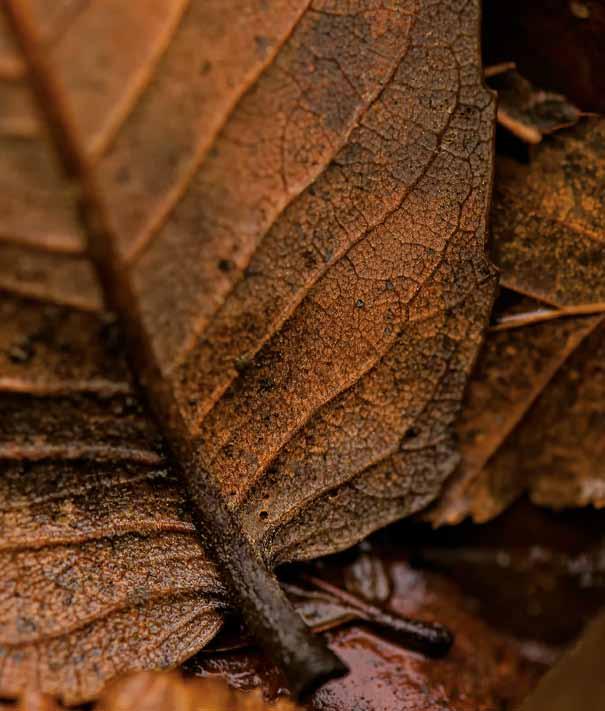
‡ el paisaje como creación cultural ‡ ‡ landscapes as a cultural creation ‡
When we speak of miniatures , we normally think of small objects, usually made for children. Or perhaps we think of small, imaginative craftwork that somehow embodies the significance of the larger, original object.
Miniatures can include souvenirs, dollhouses, Christmas nativity scenes, small books and Gulliver’s little people. As you can see, we are talking about something very small in relation to the normal size of things, which in the end is defined by our own body. The world out there has its own matter and dimensions, but it becomes subjective in relation to the principal character in history, which is mankind, complete with our values and ideologies. There are no miniatures in nature (nor are there giants). Rather, they are a creation of man.
The opposite of miniature is gigantic, colossal or monumental. And like opposite poles, each generates its own unique, sometimes contrary sensations. Very small things stimulate a sensation of intimacy and a personal reaction to the universe contained within the object. That is why diminutive things elicit a kind of domestic or interior feeling. Gigantic things, on the other hand, are somewhat of a metaphor for public things, for authority, for what is natural and exterior to us.
Things that are giant and monumental are defined by our relationship with landscapes. Monumental concepts are never a given, just like miniature does not exist in and of itself. It is our relationship with what is around us that generates this entire vocabulary of adjectives, which we use to describe our environment. Thus, it is a sort of cultural exercise, this distinguishing of the objects that exist in our world. In many ways landscapes are a composition of cultural aspects, which is the concept around this book – the cultural product of natural monuments.
Academic definitions of the word monument allude to all material things that help create identity by way of memorization, as in the study of history, or disciplines that are artistic, archeological, scientific or literary. The Real Academia de la Historia provides a definition for natural monument that works for our purposes: A natural space resulting from geological formations, paleontological sites, or other elements of the earth that – for their uniqueness, importance or beauty – are legally protected to guarantee their continued existence.
What do these academic definitions of monument and natural monument have in common with the way that we normally use the word “monumental”? And, in the context of landscape, how does the term encompass this discussion?
I would venture to suggest that a natural monument is, like any other landscape, a construction of our culture, which is valued in such a special way in contemporary society that it is considered heritage. And as such, we should safeguard it as part of our shared or national identity, and not only because it’s been there throughout history as a habitat for a variety of animal and plant
Cuando hablamos de miniaturas , pensamos en objetos diminutos, hechos generalmente para los niños. O bien pensamos en productos artesanales que resumen, en un volumen muy pequeño, todo el significado del objeto original. Miniaturas pueden ser algunos souvenirs , las casas de muñecas, los pesebres navideños, los libros pequeñitos y los enanos de Gulliver. Como se puede apreciar, aludimos a algo muy pequeño en relación a la medida normal de las cosas, que está dada finalmente por nuestro propio cuerpo. El mundo está ahí, con su propia materialidad y su volumen, pero se subjetiviza en relación al sujeto principal de la historia, que es el hombre con su carga valórica e ideológica. En la naturaleza no existen las miniaturas (ni los gigantes). Es el hombre el que las crea.
Lo contrario de la miniatura es lo gigantesco, lo colosal, lo monumental. Y, como polos de una antinomia, cada uno genera sensaciones propias y, a la vez, contrarias entre sí. Lo muy pequeño estimula sensaciones de intimidad y un sentimiento individual frente a un universo contenido en un objeto. Así, lo diminuto se refiere más bien a lo doméstico, a un sentimiento interior. Lo gigantesco, por su parte, es una metáfora de lo público y de la autoridad, de lo natural y lo exterior.
Lo gigantesco y monumental lo definimos en nuestra relación con el paisaje. Así como en la naturaleza no existe la miniatura en sí misma, tampoco existe el monumento como algo dado. Es nuestra relación con el entorno la que genera todo un vocabulario adjetivante para referirnos a lo que nos rodea. Estamos hablando, entonces, de un ejercicio cultural. E incluidos en los productos culturales están el paisaje y el concepto que nos convoca en este libro, el de monumento natural.
Las definiciones académicas de la palabra monumento aluden todas a objetos materiales que son útiles para la generación de identidad a través de la memorización, para el estudio historiográfico, o bien por su capacidad de contener valores artísticos, arqueológicos, científicos o literarios. La Real Academia de la Historia incluye, asimismo, una definición de monumento natural que sirve a nuestras intenciones: Espacio natural constituido por formaciones geológicas, yacimientos paleontológicos y otros elementos de la gea que, por su singularidad, importancia o belleza, es objeto de protección legal para garantizar su conservación.
¿Qué tienen en común las definiciones académicas de monumento y monumento natural con los usos cotidianos que hacemos de la palabra “monumental”, y con el contexto del paisaje que pareciera albergar toda esta discusión?
Me atrevo a aventurar que el monumento natural es, así como cualquier otro paisaje, un constructo cultural que en la coyuntura contemporánea valoramos de forma especial hasta ensalzarlo a la categoría de patrimonio. Como tal, debemos salvaguardarlo porque forma parte de nuestra identidad comunitaria o nacional, y porque históricamente ha estado ahí albergando una serie de especies vegetales y animales, así como
species; it also serves as a natural context, determining specific historic episodes that illustrate humankind’s acquisition of nature. Thus, landscapes are a social product, a way of perceiving the world. Just as is true with any other viewpoint, this vision contains a cultural idea of space, of time and of its possibilities. Simon Schama refers to this when he talks about how revealing it was for him to consider the River Thames as a line in space and time – a viewpoint that was part of a shared tradition among Londoners. This idea of landscape associated with space and time is seen in other examples throughout the history of landscapes.
In the 16th century, the recently discovered lands of America by the Europeans were viewed upon, with all of their exoticism and exuberance, as a compensation for the familiar landscapes of those times. The wide-open and empty spaces – from Europe’s perspective – could be filled with content that would better satisfy the needs of the conquerors in their search for a different, everlasting, even paradisiacal environment. In this sense, the American habitat was also representative of a lost time, a reproduction of an Eden inhabited by naked humans, without laws or malice, who lived without sin or worries. In other words, the Americas were a golden Arcadia without any of the restrictions of civilization.
Moving on to the rural English landscapes of the 19th century, for instance, they are portrayed in paintings and literature as a way to ennoble nature and our coexistence with nature, counterbalancing the excesses brought by the industrial revolution. In contrast to the grey routine embodied by the city, the epic greenery of natural landscapes was emphasized. Faced with the eminence of a faster and more efficient pace, a more “natural” time is rescued and portrayed in the soothing country landscapes.
Fernand Braudel, a French historian of the Annales school of thought, took the relationship between landscapes and space and time to a new, systematized level. He wrote that there are three levels of duration that determine historical time: the level that is most visible, the short level of particular events; the medium duration that has to do with the conjunctures of events; and, finally, the long duration that, in Europe’s case, he relates with the influence of the landscape. This level allows an understanding of how mankind interacts with nature. This is not a case of geographic determinism, but rather giving due weight to “the historic value that landscapes play in the unfolding of humankind”1 . Nature acquires the possibility of becoming a subject of history. A natural monument, although given a special status, is not untouched by the passing of time and is not overlooked.
un contexto natural que ha determinado episodios históricos y que expresa la apropiación humana de la naturaleza.
El paisaje es, por lo tanto, un producto social, una forma de ver el mundo. Pero, como toda mirada, ésta contiene una idea cultural del espacio, del tiempo y de sus posibilidades. Simon Schama repara en esto al relatar cuán reveladora fue para él la idea de ver el río Támesis como una línea de espacio, así como de tiempo, idea que era parte de una tradición compartida entre los londinenses. Esta idea de paisaje asociada a tiempo y espacio se vislumbra también en otros ejemplos, a través de la historia del paisaje.
Durante el siglo XVI, el paisaje americano recién descubierto por Europa es visto, con todo su exotismo y su exuberancia, como una forma de compensar el paisaje europeo de entonces. Este espacio vacío –a ojos del europeo– podía llenarse del contenido que más satisficiera a sus conquistadores en la búsqueda de un ambiente diferente, perenne, incluso con características paradisíacas. En este sentido, el hábitat americano era también la representación de un tiempo perdido, una reproducción de aquel Edén habitado por hombres desnudos, carentes de leyes y de malicia, que alguna vez vivieron sin mayores pecados ni preocupaciones. O, como describe la tradición clásica, una Arcadia dorada sin las restricciones de la civilización.
El paisaje rural inglés del siglo XIX, por su parte, se realza en las pinturas y en la literatura como una forma de enaltecer la naturaleza y la convivencia con ella frente a los excesos que estaba provocando la revolución industrial. Ante el gris rutinario de la ciudad se instala el verde épico del paisaje natural. Frente a la inminencia de un tiempo rápido y eficiente, se rescata el tiempo más “natural” del espacio agrario.
Quien lleva la relación del paisaje con el espacio y el tiempo a una sistematización reveladora es Fernand Braudel, historiador francés de la escuela de los Annales . Para él, hay tres niveles de duración que determinarían el tiempo histórico: el nivel más visible o de los eventos; el de la mediana duración, que coincide con las coyunturas; y, por último, el de la larga duración que, en el caso de Europa, él relaciona con el influjo del paisaje. Este nivel es el que permite ver la interacción de los hombres con la naturaleza. No se trata de un determinismo geográfico, sino de ponderar “el valor histórico del paisaje en el complejo devenir de la humanidad”1 La naturaleza adquiere la posibilidad de constituirse en un sujeto histórico. El monumento natural, aunque ensalzado a un estatus especial, no queda ajeno a los pasos del tiempo y a su visibilidad.
There is no single way to view a landscape. On the contrary, there are innumerous ways of looking at what is all around us, ways that can sometimes compete amongst one another.
Natural systems are perceived, valued and modified by mankind. The simple act of identifying an aspect of nature is already, in itself, a cultural act full of significance. Following that is the task of building monuments. These are built in synch with the current conjuncture of events, despite the effort of producing immortality and timelessness, which seem to be the intended aura of a monument.
In the case of our natural monuments, the concept – and the concern for them – emerges from the sensation of vulnerability of the environment, and the valorization of all patrimonial aspects that, from a State level or community level, we consider intrinsic to our identity. Natural monuments are the result of our concern about the relationship between sustainable development and the environment.
National monuments are designed to find a solution to these contemporary concerns. By giving these landscapes a special status, people accept these “manufactured” landscapes as something natural and logical, and then incorporate them into their own mindset, so that they can be consumed, defended and legitimatized 2 .
On the other hand, each of us is capable of living with various landscapes as part of a single vision. A region and its natural assets can also be understood in our minds in terms of a mythological landscape, while for another person it might be understood in terms of its economic resources. Landscapes can be viewed through a lens of esthetics, of science, or of identity. In other words, landscapes are polysemous 3 . But our mission is to try to integrate all these meanings, while being attentive to those characteristics believed to be the most objective. And at the same time, include that which is subtly subjective of an ever-changing nature and viewer.
The monuments most valued today are those that encompass both an identity and a concern for their sustainability over time. A monument or a monumental space strengthens our sense of community and gives people a sense of belonging 4 . We could say that if today a landscape is considered heritage, it is because there’s been an interesting evolution of the concept of heritage in
2 Joan Nogué (ed.): La construcción social del paisaje [The social construction of landscape] Biblioteca Nueva, Madrid, 2009.
Introduction: “El paisaje como constructor social”, p. 12.
3 Barbara Bender (ed.): Landscapes. Politics and perspectives. Berg Publishers, Oxford, 1993. Introduction, p. 3.
4 Ladina Bezzola Lambert, Andrea Ochsner (eds.): Moment to Monument. The Making and Unmaking of Cultural Significance. Transaction Publishers, New Brunswick, London, 2009, p. 11.
No hay una sola forma de mirar el paisaje. Al contrario, puede haber múltiples formas de construir miradas frente al entorno; miradas que muchas veces pueden ser competitivas entre sí. Los sistemas naturales son percibidos, valorados y modificados por los hombres. El mero acto de identificar un aspecto de la naturaleza es ya un acto cultural lleno de significado. Luego está la acción de erigir monumentos, que sigue alineándose con las coyunturas culturales de la época, a pesar de la vocación de inmortalidad y atemporalidad que parece conformar el aura de lo monumental.
En el caso de nuestros monumentos naturales, el concepto –y la preocupación por ellos– surge en un contexto de sensación de vulnerabilidad del medio ambiente, y de valoración de todos aquellos aspectos patrimoniales que desde el Estado y las comunidades se piensan como conformadores de una identidad insoslayable. Surge como una preocupación por la relación entre desarrollo sustentable y medio ambiente. Los monumentos naturales son realidades facturadas para dar solución a estas preocupaciones contemporáneas. Al darles este especial estatus, las personas asumen estos paisajes “manufacturados” de manera natural y lógica, pasando a incorporarlos a su imaginario y a consumirlos, defenderlos y legitimarlos 2 .
Por otro lado, en cada uno de nosotros pueden convivir varios paisajes frente a un mismo entorno. Una región y su naturaleza pueden configurarse en tanto paisaje mitológico en nuestra mente, así como para otra persona ese mismo lugar puede mirarse desde los recursos económicos. Se puede ver un paisaje desde criterios estéticos, identitarios o científicos. Los paisajes son, por tanto, polisémicos 3 . Pero nuestro objetivo es intentar integrar todas estas aproximaciones, estando atentos a aquellas características supuestamente más objetivas, pero integrando la sublimidad subjetiva de una naturaleza y un espectador cambiantes.
Los monumentos que ponemos en valor ahora se articulan en función de su capacidad de generar identidad y preocupación por su sustentabilidad en el tiempo. Un monumento o un espacio monumental fortalecen el sentido de comunidad, ofreciendo a sus miembros una imagen de su pertenencia. Los monumentos crean espacios sociales al evocar sentimientos de identidad y pertenencia 4 . En esta línea, podemos decir que si el paisaje es considerado patrimonial hoy en día, es porque ha habido una
2 Joan Nogué (ed.): La construcción social del paisaje . Biblioteca Nueva, Madrid, 2009. Introducción: “El paisaje como constructor social”, p. 12.
3 Barbara Bender (ed.): Landscapes. Politics and perspectives Berg Publishers, Oxford, 1993. Introducción, p. 3.
4 Ladina Bezzola Lambert, Andrea Ochsner (eds.): Moment to Monument. The Making and Unmaking of Cultural Significance. Transaction Publishers , New Brunswick y Londres, 2009, pág. 11.
recent years. This process responds to the greater general value we now give to our natural surroundings, the result of the need to preserve things – to help us survive both biologically and culturally. Natural and cultural spaces are perceived as a mix of various timelines that mankind is unable to unravel: on the one hand they both work to assure future life on earth, while on the other hand they are vessels providing insight into the past that enrich our experience and provide depth. Today’s conservationist and patrimonial vision is able to mix what’s been inherited from the past with the necessities and concerns that are part of the future.
The monuments considered national heritage in Chile are categorized as such – among other reasons – for their unquestionable historical value and because of the possibilities they leave open for the future. They have all been important pieces that help explain the ways of life of ancient inhabitants of our territory, or how our forefathers settled and made use of the nation’s resources; and they are part of our collective memory, or have a place in the nation’s history books of the arts. These characteristics are best illustrated by examples: in the Quebrada de Camarones there are 17 rock overhangs with paintings believed to be linked to caravan travelers or to late Paleolithic hunters. In the Pichasca natural monument, traces of the Molle, Diaguita and Inca cultures can be found. There are theories about archeological artifacts from hunter and gatherer communities, existing some 9,000 years ago. And while the Los Pingüinos monument in the Magallanes region is home to large numbers of Magellanic penguins, it was also regularly inhabited by aborigine groups of the past. The Laguna de los Cisnes, in Region XII, is home to a large number of bird species, including the black-necked swan. This location was also most likely highly valued by pre-Columbian cultures. Information about the monument was the result of writing done by Abate Molina (1778), and then more writing by the naturalist Claudio Gay at the beginning of the 19th century.
Another of Chile’s natural monuments that we all have a visual memory of, is the Portada de Antofagasta. Its shape and surroundings create an unforgettable landscape. There’s little doubt that centuries ago it was appreciated by the changos , the canoe culture that traveled upon rafts made from sea lion skins and extracted sea resources for food and trade.
From the information gained about El Morado, we can further discuss the importance of natural monuments in the history of the people of our country. The first inhabitants of the area were a community of hunters and gatherers known as the chiquillanes , who were – as Gómez de Vidaurre wrote – the most “barbarous” of all the indigenous Chilean tribes.
Even poetry has described some of the natural reserves that capture our interest. This is the case with Contulmo, which in mapudungún means “the place of passing.” It is inhabited still today by Mapuche groups and merits remembrance for the glowing words written by Alonso de Ercilla in La Araucana : “The Elicura road grows more narrow / along the
interesante evolución del concepto de patrimonio en los últimos años. Este proceso responde a la valoración generalizada de nuestro entorno natural, a una coyuntura de necesidad de preservación, tanto por nuestras necesidades biológicas como culturales. Los espacios naturales y culturales son percibidos como portadores de varios tiempos de los cuales el hombre no se puede sustraer: por un lado aseguran la vida futura en la tierra, pero por otro lado son portadores de un pasado que enriquece nuestra experiencia y le proporciona profundidad. Esta nueva visión conservacionista y patrimonialista, entonces, es capaz de conjugar, desde el presente, las herencias del pasado con las necesidades y aprensiones que presenta el futuro.
Los complejos monumentales chilenos elegidos como patrimoniales alcanzan esa categoría, entre otras cosas, por su historicidad incuestionable y por sus posibilidades a futuro. Todos ellos han sido piezas importantes en las formas de asentamiento y aprovechamiento de recursos de nuestros antepasados, los antiguos habitantes de nuestro territorio, y están presentes en la memoria colectiva o en los registros de las artes. Estas características deben ilustrarse con ejemplos. En la Quebrada de Camarones se han reconocido diecisiete aleros con pinturas, cuyas ocupaciones han sido vinculadas a caravaneros y cazadores tardíos. En el monumento natural Pichasca se encontraron vestigios de las culturas Molle, Diaguita e Inca. Incluso se habla de artefactos arqueológicos que datarían de hace nueve mil años y que corresponden a pueblos recolectores y cazadores. El monumento Los Pingüinos, en la región de Magallanes, alberga una gran cantidad de pingüinos magallánicos, pero se sabe que fue también habitado por aborígenes que hicieron del lugar su escenario cotidiano. La Laguna de los Cisnes, en la XII Región, está habitada por una variedad de aves, entre las que destaca el cisne de cuello de negro. Probablemente fue valorizada por las culturas precolombinas. Su posterior conocimiento se debe a los escritos del Abate Molina (1778) y, luego, a los del naturalista Claudio Gay, a comienzos del siglo XIX.
Un monumento natural chileno que todos tenemos en nuestra memoria visual es la Portada de Antofagasta. Desde tiempos remotos su forma y su entorno han constituido un paisaje memorable, y hace cientos de años, probablemente, esta formación fue rondada por los changos, cultura canoera que se transportaba en balsas de cuero de lobo y que extraía recursos marinos para alimentarse y comerciar.
A partir de la información de El Morado, también podemos argumentar sobre la importancia de los monumentos naturales en la historia de los habitantes de nuestro país: la zona fue habitada por una comunidad de recolectores de piñones y cazadores de animales. Eran los chiquillanes, que según Gómez de Vidaurre constituían la tribu indígena más “bárbara” de todas las chilenas. Hasta la poesía ha descrito algunas de las zonas de nuestro interés. Es el caso de Contulmo, que en mapudungún significa “lugar de paso” y que, por estar habitado hasta el día de hoy por comunidades mapuches, merece ser recordado en las palabras
mountain’s small skirt / the cause and the reason for this narrowness / is a lake that the valley below has closed.”
Another contextual process that favors the importance of natural monuments is the increased complexity of the concept of territory. Thanks to new concerns and actions taken by modern geography, urbanism and landscape architecture, these disciplines have highlighted the territory as part of culture. These spaces are now understood not as just given, but rather as something that has been constructed. This is important because it signifies that territory is a product of society, and because “it leads to the idea of introducing a historical element to our thinking, so that territory becomes a kind of contingent product, while at the same time linked to determined conditions related to time or history.”5
In the third place, this renovated status of landscape as a valued cultural artifact results from the combination of cognitive and methodological thinking, in an effort to deal with problems that were previously studied separately – by biological and social sciences. Today, however, it would be unthinkable to separate natural from social issues when trying to understand the complexities related to landscapes.
The nature-culture dichotomy defers to contemporary definitions of landscape as the “cultural dimension of nature” or the “natural dimension of culture”6 .
Photography is one of the ways most used today to depict and immortalize landscapes. By taking photographs of a territory, one is engaging in a kind of remaking of the property (reterritorialización 7). The monument’s landscape passes from its natural habitat to the space of a photograph, where it remains frozen, framed and immortalized from a subject’s viewpoint. The place represented is first monumentalized in the click of a lens, and consequently those places later declared as such are twice monumentalized. And this almost sacred natural landscape is converted into invaluable material. The moment (chosen by the photographer who takes record of the landscape) is transformed into a monument 8
Once again it is man, in all his presence and his baggage, he who is there at the precise time, enshrining the moment and the space to
5 José Ortega Valcárcel: “El patrimonio territorial: el territorio como recurso cultural y económico” [Territorial Heritage: the territory as a cultural and economic resource], in Ciudades , revista del Instituto Universitario de Urbanística de la Universidad de Valladolid, ISSN 1133-6579, n. 4, 1998, p. 6.
6 Pedro S. Urquijo Torres, Narciso Barrera Bassols: op. cit.
7 The concept is from Deleuze and Guattari.
8 Ladina Bezzola Lambert, Andrea Ochsner (eds.): Moment to Monument. The Making and Unmaking of Cultural Significance. Transaction Publishers, New Brunswick and London, 2009, p. 186.
halagadoras de Alonso de Ercilla en La Araucana : “Estréchase el camino de Elicura / por la pequeña falda de una sierra / la causa y la razón de esta angostura / es un lago que el valle abajo cierra”.
Otro proceso contextual que favorece el relevamiento de los monumentos naturales es la complejización del concepto de territorio. Gracias a las nuevas preocupaciones y acciones de la geografía moderna, el urbanismo y la arquitectura del paisaje, se ha homologado el territorio a la cultura, y se lo ha entendido no como algo dado, sino como algo construido. Esto es importante porque significa entender el territorio como un producto de la sociedad, y porque “comporta introducir un componente de historicidad que hace del territorio un producto contingente y, al mismo tiempo, vinculado a condiciones determinadas de orden temporal o histórico”5 .
En tercer lugar, el renovado estatus del paisaje como artefacto cultural a valorar se deriva de la interdisciplinariedad epistémica y metodológica usada para enfrentar problemas que antes eran estudiados desde las ciencias biológicas y las ciencias sociales, en forma independiente. Hoy en día es impensable separar los aspectos naturales de los sociales a la hora de comprender las complejidades del paisaje. La dicotomía naturaleza-cultura cede frente a las definiciones contemporáneas de paisaje como “la dimensión cultural de la naturaleza” o la “dimensión natural de la cultura”6
La fotografía como ejercicio cultural frente al paisaje
La fotografía es una de las formas más utilizadas hoy en día para registrar e inmortalizar paisajes. Al fijar fotográficamente un territorio, se lleva a cabo una suerte de reterritorialización 7 .
El paisaje monumental pasa de su hábitat natural al espacio de la fotografía, donde queda congelado, enmarcado e inmortalizado desde la mirada de un sujeto. El lugar representado se monumentaliza, lo que lleva a que los paisajes así declarados queden, entonces, doblemente monumentalizados. Y esta naturaleza casi sacra se convierte en un material nemotécnico invaluable. El momento (elegido por el fotógrafo que registra el paisaje) se transforma en monumento 8
Nuevamente es el hombre, con toda su presencia y su bagaje, el que está ahí, enmarcando un momento y un espacio para guiar nuestra mirada. Esta recreación es fundamental para que determinado territorio se convierta en paisaje, porque la naturaleza, por sí sola, no puede ensalzarse a sí misma como
5 José Ortega Valcárcel: El patrimonio territorial: el territorio como recurso cultural y económico en Ciudades : revista del Instituto Universitario de Urbanística de la Universidad de Valladolid, ISSN 1133-6579, Nº 4, 1998, p. 6.
6 Pedro S. Urquijo Torres, Narciso Barrera Bassols: op. cit.
7 El concepto es de Deleuze y Guattari.
8 Ladina Bezzola Lambert, Andrea Ochsner (eds.): op. cit., p. 186.
help guide our vision. This kind of recreation is fundamental for any given territory to be converted into a landscape. Because nature, left to itself, is unable to appreciate or see itself as beautiful, spectacular or monumental. The material medium is that which allows us to perceive an image, which in essence is a mental phenomenon; the medium is what allows us to share images in a social space 9 . This medium can take different forms: it can be shown on the fabric of a painted picture, as an etching on printed paper, in the design of a park, or in the celluloid of a photograph.
In this book we have a spectacular photographic registry created by Claudio Almarza, who uses his own background, space and time to give us a personal look at these monuments. The photographs allow us to contemplate his point of view, the place from where the photographer was located with the objective of framing a monumental landscape; the site from where the horizon is seen and the steps he chose to share this vision with us. In viewing his images, it’s valid for us – the spectators who have not traveled with him – to ask ourselves about the perspective he has chosen, about the visual and sensory relationship he had with the setting, and the dimension the monument is given in relation to the rest of the setting. Because Almarza himself argues that each place, in some way, is so unique and special that it creates its own point of view. And not just because the viewpoint is admirable or gives comfort on one side or the other, but because the organic characteristics of the place ring out with force, grabbing the attention of the photographer. We see, then, artistic criteria in conjunction with biological criteria, which give Claudio Almarza’s work a very special look. It is a modern and complete perspective that succeeds in combining the sublime of art with the exactitude of science. That’s why he is so attentive to climatic variations, to geological changes over time, to the effects of wind, the clouds and the moon. And he is interested in the changes that occur over short periods of time –climatic and environmental changes. But he is also interested in changes that occur to these patrimonial landscapes over longer periods of time. Another example of how our heritage – and natural patrimony is no different – is a dynamic phenomenon.
At the same time, Almarza’s work contributes to the dialectic process between the aesthetic conservation of a natural landscape and its diffusion. By giving such great value to the aesthetic and patrimonial dimension of our natural monuments, his visual registry shall be seen by a great number of people who will benefit from the intoxicating magic of their beauty. A contemplation of these landscapes helps form a personal and collective aesthetic sense. Through looking at these photographs we experience a true aesthetic stimulus. And this contemplation of visual landscapes is a means of schooling in our regard for the transformations occurring in our landscapes,
bella, espectacular o monumental. El medio material es el que nos permite percibir una imagen que en su origen es un fenómeno mental; el medio es el que nos permite compartir las imágenes en el espacio social 9 . Este medio puede tener diferentes formas: puede ser el lienzo de una pintura, el papel de un grabado, el diseño de un parque o el celuloide de la fotografía. Tenemos en este libro el espectacular registro fotográfico de Claudio Almarza, quien desde su biografía, su espacio y su tiempo propios nos otorga una mirada personal. Podemos contemplar a través de sus fotografías su propio punto de vista; el lugar desde donde el fotógrafo se ubica con el objetivo de enmarcar el paisaje monumental; el sitio desde donde fija el horizonte y las escalas que elige para compartir con nosotros. Frente a sus imágenes, es válido que nosotros –los espectadores que no hemos viajado junto a él– nos preguntemos respecto a la perspectiva que ha elegido, su relación visual y sensorial con el entorno que lo alberga, las dimensiones del monumento en relación al resto del entorno. Porque el mismo Almarza argumenta que cada lugar, de alguna forma, es tan único e irrepetible que determina su propio punto de vista. Y no sólo porque la mirada se admira o se acomoda en un lado o en otro, sino también porque las características orgánicas del lugar resuenan con fuerza para llamar la atención del fotógrafo. Vemos, entonces, cómo se van conjugando en su fotografía los criterios artísticos con los biológicos, lo que hace de Claudio Almarza un fotógrafo de mirada muy especial. Es una mirada moderna y completa, que logra conjugar lo sublime del arte con la exactitud de la ciencia. Por eso es que está atento a las variaciones climáticas, a los cambios geológicos a través del tiempo; a los efectos del viento, las nubes y la luna. Le interesan los cambios que ocurren en la corta duración, eventos o acontecimientos climáticos y ambientales; pero también le interesan las modificaciones que estos paisajes patrimoniales sufren en un tiempo más largo. Un ejemplo más de que el patrimonio –y el natural no es una excepción– es un fenómeno dinámico.
La obra de Almarza contribuye, asimismo, al proceso dialéctico que existe entre la conservación de la estética natural del paisaje y la difusión de ésta. Al valorar la dimensión estética y patrimonial de nuestros monumentos naturales, su registro visual intenta llegar a muchas personas que se beneficiarán con la magia embriagadora de su belleza. La contemplación del paisaje colabora con la formación de un sentido estético personal y colectivo. Al mirarlo, experimentamos un verdadero estímulo estético. Así, esta contemplación del paisaje visual es una escuela para nuestra mirada, y las transformaciones del paisaje desafían a nuestro pensamiento estético con nuevos retos 10 . El paisaje puede ser un espacio de experiencia estética,
9 Hans Belting: Antropología de la imagen . Katz Editores, Buenos Aires, 2007, p. 22.
10 Javier Maderuelo: Paisaje y arte . Abada Editores, 2007, p. 8.
and dare our aesthetic thinking to assume new challenges 10 Landscapes can be a space for an aesthetic experience, a subject of aesthetic judgment and a relational link 11 . The appreciation, the valorization, and the construction of a landscape are not based on appearances, but on a consciousness using ethicalaesthetic practices that are the result of human understanding of totality, interiority, continuity and authenticity.
In spite of the undeniable importance that the sense of sight has had in Western culture 12 , it must be pointed out that other senses, too, can help us build a landscape – both in individual and collective terms. We are accustomed to reading visual registries, but it would be interesting to incorporate into our understanding of landscapes the natural sounds that accompany the landscapes, the smells and tastes of different species, as well as the tactile feel of materials. The fall of water from the waterfalls, the sea breeze on our skin, the way sand feels on bare feet. All these things would enrich our experience of our surroundings. Because a landscape is a complete experience. It is the relationship between the world and ourselves 13 .
Pablo Neruda’s prose achieved the description of this relationship: “Beneath the volcanoes, next to the snowfields, among the great lakes, the fragrance, the silence, the overgrown Chilean forests… Feet sink into dead foliage, a broken branch scratches, gigantic oak trees rise up like statues, a bird from the cold forest dances, flaps its wings and stops amidst the darkened branches. And then, from its hideout, it pipes up like an oboe… The savage scent of wild laurel enters through my nose, goes to my soul, the dark smell of boldo… A Guaitecas cypress intercepts my path…”
Olaya Sanfuentes E. Historian10 Javier Maderuelo: Paisaje y arte [Landscape and Art]. Abada Editores, 2007, p. 8.
11 Aurora Carapinha: “Los tiempos del paisaje”, in Paisaje e historia [Landscape and Art], Javier Maderuelo (ed.), Abada Editores, Madrid, 2009, p. 114.
12 Aristotle himself said that sight is the most beloved of the senses.
13 Josepa Bru: “Cuerpo y palabra o los paisajes de la cautividad” [Body and Word, or the landscapes of Captivity], in La construcción social del paisaje . Joan Nogué (ed.), Biblioteca Nueva, Madrid, 2009, p. 63.
un sujeto de juicio estético y vínculo relacional 11 . La apreciación, la valoración y la construcción del paisaje se basan no en sus apariencias, sino en una conciencia y en una práctica éticoestética que son el resultado de una comprensión humana de él en cuanto totalidad, interioridad, continuidad y autenticidad.
A pesar de la importancia indiscutible que el sentido de la vista ha tenido en la cultura occidental 12 , no podemos dejar de decir que otros sentidos pueden también ayudarnos a constituir paisaje, tanto en términos individuales como colectivos. Estamos acostumbrados a leer los registros visuales, pero interesante sería poder incorporar en nuestra idea de paisaje las sonoridades de la naturaleza, los olores y sabores de las especies, así como el tacto de los materiales. La caída del agua en las cascadas, la brisa marina en nuestra piel, el tacto de la arena en los pies desnudos, no hacen más que enriquecer nuestra experiencia del entorno. Porque el paisaje es experiencia. Es vivencia de la relación entre el mundo y nosotros 13
La prosa de Pablo Neruda pudo lograrlo: “Bajo los volcanes, junto a los ventisqueros, entre los grandes lagos, el fragante, el silencioso, el enmarañado bosque chileno… Se hunden los pies en el follaje muerto, crepitó una rama quebradiza, los gigantescos raulíes levantan su encrespada estatura, un pájaro de la selva fría cruza, aletea, se detiene entre los sombríos ramajes. Y luego desde su escondite suena como un oboe… Me entra por las narices hasta el alma el aroma salvaje del laurel, el aroma oscuro del boldo… El ciprés de las Guaitecas intercepta mi paso…”.
Olaya Sanfuentes E. Historiadora11 Aurora Carapinha: “Los tiempos del paisaje”, en Paisaje e historia , Javier Maderuelo (ed.), Abada Editores, Madrid, 2009, p. 114.
12 El mismo Aristóteles decía que la vista es el sentido más amado.
13 Josepa Bru: “Cuerpo y palabra o los paisajes de la cautividad”, en La construcción social del paisaje; Joan Nogué (ed.); Biblioteca Nueva, Madrid, 2009, p. 63.
Ar T hro P ods: Phylum or group of invertebrate animals with an exoskeleton and a segmented body. This includes insects, arachnids, centipedes and crustaceans, among others.
Asso C i AT io N ( vege TAL): Community of plants that are normally found together in an ecosystem.

Biodiversi T y: All the different varieties of biological phenomena and structures – ranging from genetic sequencing to the interaction of species within ecosystems, and how all of these elements interact with one another and with the environment.
Co MM u N i T y: Group of organisms that includes all the populations present at one place.
d eC iduous: A vegetal species that loses all its leaves during the unfavorable part of the year, when temperatures are most extreme.
d i M or Phis M (sexuAL): The difference that is visibly observable between the sexes of an adult species.
eCosys T e M : A system that includes the biological community and non-biotic elements, and the interrelationship between and among them that occurs over a defined period of time and in a defined space.
eCoTo N e: The transition area between one or more ecosystems, which results in a combining of ecosystems, and an increase of niches within the combination, as well as the creation of new niches. As a result, biodiversity is greater in these areas.
eN de M i C : A native species with a limited geographic distribution. The term can refer to an international endemic species (for example, a species living in the Argentine/Chilean Patagonia), as well as national or regional, and even to a species in a specific ecosystem.
Bio Logi CAL s PeC ies: Defined generally as a group of individuals that mate and produce fertile offspring. Although a very useful concept for fauna, it is somewhat ambiguous for plants, as different plant species oftentimes successfully reproduce fertile hybrids. As a result, other concepts have been defined, such as phylogenetic species or ecologic species, depending on the emphasis.
sTAT e of Co N servAT io N : Indicates the probability that a population of any given species may disappear, based on the number of individuals, population tendencies, its genetic variability and the threats it faces. Countries and organizations differ on the way this conservation classification is determined. The best-known classification is the IUCN, which is used in this publication.
ePi Phy T e: A plant that grows on top of another plant.
g reg A rious: A term used where groups of individuals of a species live together.
h y B rid: An individual whose parents are from different species, varieties or races.
Mu T uAL is M : The relation between two species whereby both are benefited. Pollination, for example, is mutualism between flowering plants and bees.
N AT ive: A species that evolved in the territory of a country that it continues to inhabit. Or that occurs naturally in a territory over a large period of time. Its presence is the result of natural phenomena, without human intervention.
sC ie NT ifi C NAM e: A name that defines a species based on a consensus of the scientific community. It is composed of two names: the first is the genus (the group of species that are most related) and the second name is the specific epithet, which distinguishes the species within the genus grouping.
eCo Logi CAL N i C he: Each species occupies or lives within a specific range of environmental factors (temperature, diet, latitude, etc.); if all these variables are identified and defined, they constitute the ecological niche of the species. The term is understood as the unique way by which a species lives within its environment.
PAL eo NTo Logy: Science that studies past life on earth through the examination of fossil remains.
PL eis To C e N e: A geological era ranging from 2.6 million to 12,000 years ago. It is characterized by recurrent glaciations, the expansion of mankind to all corners of the planet (except the Antarctic) and the extinction of macro-fauna (large sized animals such as mammoths, sable-toothed tigers, etc.). It corresponds to the Stone-Age era of mankind.
Po P u LAT io N : All members of the same species that live in an identified geographic area.
Terri Tori AL : Territorial animals are those that occupy a single area and do not permit others of the same species to move in, except during times of reproduction.
Ar T ró P odos : Phyllum o grupo de animales invertebrados con exoesqueleto y cuerpo segmentado. Incluye a insectos, arácnidos, ciempiés y crustáceos, entre otros.
Aso C i AC ió N ( vege TAL): Comunidad de plantas que se presentan comúnmente juntas en un ecosistema.
BiodiversidA d : Toda la variedad de fenómenos y estructuras biológicas, desde las secuencias genéticas a las interacciones ecosistémicas, pasando por las especies y por cómo estas interactúan entre sí y con el medio.
Co M u N idA d : Grupo de organismos que incluye a todas las poblaciones presentes en un lugar.
d eC iduo: Especie vegetal que pierde todas las hojas durante la época desfavorable del año, cuando las temperaturas son extremas.
d i M orfis M o (sexuAL): Diferencia visiblemente observable entre los sexos de una especie en estado adulto.
eCosis T e MA : Es un sistema que incluye la comunidad biológica, elementos abióticos y las interrelaciones dentro y entre ellos que ocurren en un tiempo y espacio definidos.
eCoTo N o : Zona de transición entre dos o más ecosistemas. Presenta nichos propios de cada ecosistema, además de nichos nuevos que surgen debido a la transición misma, por lo que la biodiversidad es más alta.
eN dé M i Co : Especie nativa con una distribución geográfica acotada. Se puede hablar de endemismo a nivel internacional (por ejemplo, la Patagonia chileno-argentina), nacional, regional o, incluso, a nivel de ecosistema específico.
e s PeC ie B io Lógi CA : Definida generalmente como un conjunto de individuos que se cruzan y producen descendencia fértil. Concepto muy útil para la fauna, pero ambiguo para las plantas, ya que especies distintas frecuentemente producen híbridos fértiles. Por esto se han definido otros conceptos, como especie filogenética o especie ecológica, dependiendo del énfasis.
e s TA do de Co N servAC ió N : Indica la probabilidad de que la población de una especie desaparezca, basándose en la cantidad de individuos, las tendencias poblacionales, las amenazas que enfrenta y su variabilidad genética. Países y organizaciones difieren en la forma de clasificar las especies según su grado de conservación. La clasificación más conocida es la de IUCN, usada en esta publicación.
ePífi TA : Planta que crece sobre otra.
g reg A rio : Que vive en grupos de individuos de su especie
h í B rido: Individuo cuyos padres son de especies, variedades o razas distintas.
Mu T uAL is M o : Relación entre dos especies en la que ambas se benefician; por ejemplo, un mutualismo de polinización.
N AT ivo : Especie que evolucionó en el territorio del país que actualmente habita, o bien que ocurre naturalmente en él desde hace mucho tiempo. Su presencia se debe a fenómenos naturales sin intervención humana.
No MB re C ie NT ífi Co : Define a una especie inequívocamente y surge del consenso de la comunidad científica. Está compuesto de dos palabras: la primera es el género (es decir, el grupo de especies emparentadas a la cual esta pertence) y la segunda es el epíteto específico, que es único para cada especie de ese género.
Ni C ho eCo Lógi Co : Cada especie siempre ocupa un rango acotado de cada variable ambiental (temperatura, dieta, latitud, etc.); si se pudiera definir ese rango para todas las variables, eso correspondería al nicho ecológico, el que se puede entender como la forma particular de vivir de una especie respecto del ambiente.
PAL eo NTo Logí A : Ciencia que estudia el pasado de la vida en la tierra a través de restos fósiles.
PL eis To C e N o: Es una época geológica que va desde 2,6 millones de años atrás hasta 12.000 años atrás. Se caracteriza por recurrentes glaciaciones, la expansión del hombre por todos los continentes (excepto la Antártica) y la extinción de la macrofauna (animales de gran tamaño como mamuts, tigres dientes de sable, etc.). Corresponde a la Edad de Piedra de la prehistoria humana.
Po BLAC ió N : Corresponde a todos los individuos de una misma especie que habitan un área geográfica.
Terri Tori AL : Animales territoriales son aquellos que ocupan únicamente un área y no permiten la entrada de otros de su misma especie, excepto en época reproductiva.

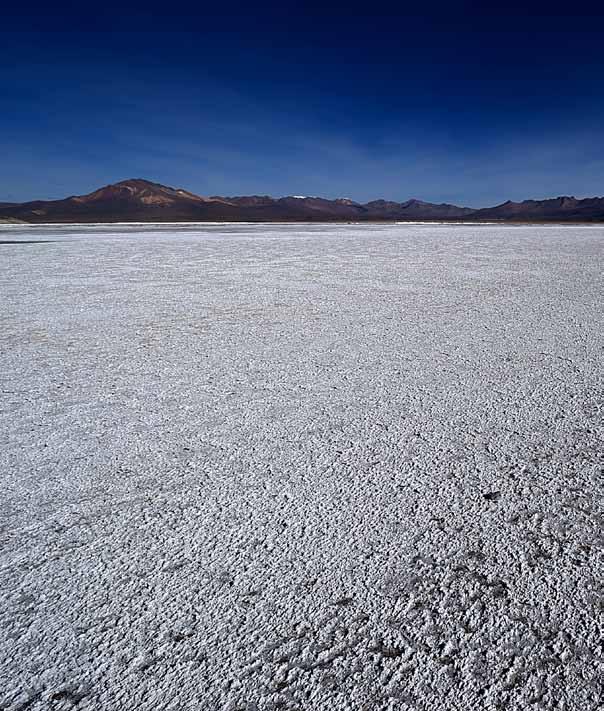

Natural Monument (NM) d eclaration d ate: 1983.
Location: Region XV of Arica and Parinacota, Province of Parinacota.

surface area: 11,298 hectares.
Name origin: The word surire alludes to the ñandú or rhea, an animal native to the area. The word suri in the Aymara language means “ñandú,” while ire denotes the plural form of the word 1 . So this area is called “The salt flat of the ñandús.”
Motive for conservation: The community of very unique species have made the salt flat, its various salt lakes, and the surrounding area an oasis of life in the high plateau, known as the Altiplano . This NM is rich in endemic flora and fauna, as well as it has problems relating to their conservation. The area includes half of the Flamingo species that exist on the planet. This biodiversity has been recognized around the world as part of the Lauca Biosphere Reserve.
fecha de creación como Monumento Natural (MN): Año 1983.
u bicación : XV Región de Arica y Parinacota, provincia de Parinacota.
superficie: 11.298 hectáreas.
o rigen del nombre: La palabra surire alude al ñandú, animal propio de estas tierras, pues suri , en lengua aimara, significa “ñandú”, mientras que ire es la desinencia que indica el plural 1 . Por lo tanto, este sector se denomina “Salar de ñandúes”.
Motivo de conservación : Una comunidad de especies singulares ha hecho del salar y sus alrededores un oasis de vida en el altiplano, rico en flora y fauna endémicas y/o en problemas de conservación, y que incluye la mitad de las especies de flamenco que existen en el mundo. Esta biodiversidad ha sido reconocida mundialmente como parte de la Reserva de la Biósfera Lauca.
g eographic and climatic characteristics: Temperatures in this area fluctuate sharply between -15 °C during winter nights to 5 °C in the daytime. The average yearly temperature is between 5 °C and -5 °C, while average rainfall is 250 mm. The NM features salt lakes and high altitude ecosystems. The area making up this NM is an essential part of the Lauca Biosphere Reserve. The landscape is the main reason for attractiveness, with strong white and blue desert colors providing stark contrasts, especially at dusk and at dawn. The salt flat was formed during the Cenozoic era, as the Andes mountain range pushed upward from the sea, trapping seawater that later evaporated. This phenomenon, together with the salt sediments coming from nearby volcanoes, created the salt flat 2 .
Características geográficas y climáticas: Es una zona de gran oscilación térmica, la que fluctúa entre -15 °C en las noches de invierno y 5 °C en el día. Como promedios anuales, presenta precipitaciones de 250 mm y temperaturas entre 5 °C y -5 °C. Abarca zonas de salares y ecosistemas de altura. El espacio que conforma este MN es parte integral de la Reserva de la Biósfera Lauca. Su paisaje constituye gran parte del atractivo del lugar, donde los colores desérticos, fuertes blancos y azules, se contraponen con especial intensidad en los atardeceres y amaneceres. El salar se formó durante el cenozoico debido a la evaporación de agua de mar atrapada en una Cordillera de los Andes que estaba elevándose. Esto, sumado a aportes de sedimentos salinos provenientes de volcanes, configuró definitivamente el salar2
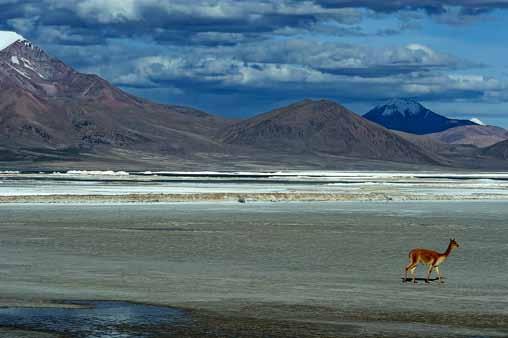
f lora: There are unique vegetation species that form shrubsteppes and wet meadows 3 , which have adapted interesting ways to deal with the unusual and extreme conditions that make life impossible for any other kind of plant. These extreme conditions include ultraviolet light, sharp temperature changes, prolonged dry spells and very high salt concentrations.
fauna: This NM contains a variety of exceptional birds and mammal species that provide much of the unique natural value of the site. Of special importance are the vicuña (Vicugna vicugna ), the puma (Puma concolor ), the Andean fox (Pseudalopex culpaeus ), the southern viscacha (lagidium viscacia ) and the Andean hairy armadillo (Chaetophractus nationi ). Exceptional bird species include the ñandú or rhea (Rhea darwinii ), the high altitude partridge or partridge of the puna, the Chilean flamingo (Phoenicopterus chilensis ), the Andean flamingo (Phoenicopterus andinus ), the James’s flamingo (Phoenicopterus jamesi ), the caiti and the crested duck (Lophoneta specularioides ) 4
3 I. Garcés: “Salar de Surire, un ecosistema altoandino en peligro frente al escenario del cambio climático” [Salt flats of Surire, a high Andean ecosystem endangered by climate change], in Nexo , vol. 24, nº 1, 2011, pp. 43-49.
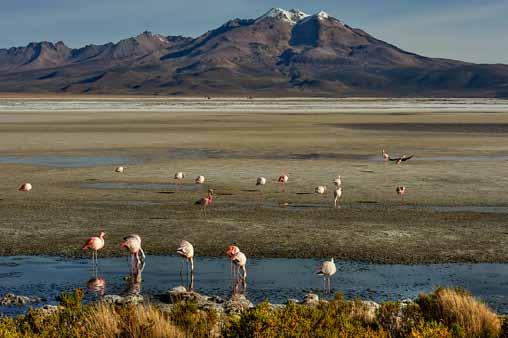
4 www.conaf.cl Visited April 1, 2012.
f lora: Hay especies vegetales como las que forman los tolares y bofedales 3 . Estas presentan interesantes adaptaciones para enfrentar la radiación ultravioleta, cambios bruscos entre temperaturas extremas, condiciones de aridez o anegamiento, y altísimas concentraciones de sales, características que harían impensable la vida para cualquier otra planta. Los camélidos del altiplano forrajean de estas especies.
fauna: El MN contiene una variedad excepcional de aves y mamíferos que aportan en gran medida al valor natural que tiene el lugar. Destacan la vicuña (Vicugna vicugna ), el puma (Puma concolor ), el zorro culpeo (Pseudalopex culpaeus ), la vizcacha (lagidium viscacia ) y el quirquincho de la puna (Chaetophractus nationi ). Las especies de aves son los ñandúes o suris (Rhea darwinii ), la perdiz de la puna o kiula, el flamenco chileno (Phoenicopterus chilensis ), la parina grande (Phoenicopterus andinus ), la parina chica (Phoenicopterus jamesi ), el caiti y el pato juarjual (Lophoneta specularioides ) 4
3 I. Garcés: “Salar de Surire, un ecosistema altoandino en peligro frente al escenario del cambio climático”, en Nexo, vol. 24, nº 1, 2011, pp. 43-49.
4 www.conaf.cl Visitada 1-4-2012.
ARRIBA:
ñ andú del norte o Suri (Rhea pennata tarapacensis )
Cometocino de dorso castaño (Phrygilus dorsales)
Parina grande (Phoenicopterus andinus)
The presence of the diatoms, a microscopic algae species abundant in these environments, allows for two different types of flamingo species to thrive – the Andean flamingo and the James’s flamingo. The Chilean Flamingo, for its part, feeds on water invertebrates that also thrive in the area.

Public usage and community relationship with the NM: The Surire Salt Flat unites the natural, physical beauty of the landscape with the marvels of its wildlife. These two elements make the park an important, critical space for the preservation of both the magnificent vistas and the animal and plant life that make our national territory unique.
ABAJO: Vizcacha, (Lagidium viscacia) Formación vegetacional heterogénea de estepa alto-andina subdesértica.
La presencia de diatomeas , una especie de alga microscópica que es un recurso abundante en esta clase de ambientes, permite que los dos tipos de parinas, grande y chica, puedan existir. El flamenco chileno, en tanto, se alimenta de invertebrados acuáticos que también habitan la zona.
relación con los habitantes y usos del MN: El Salar de Surire conjuga las bellezas de la naturaleza como paisaje físico y las maravillas de su fauna. Estos dos elementos hacen del parque un espacio de importancia vital para la conservación de vistas y de especies animales y vegetales propias, que marcan y distinguen a nuestro territorio.




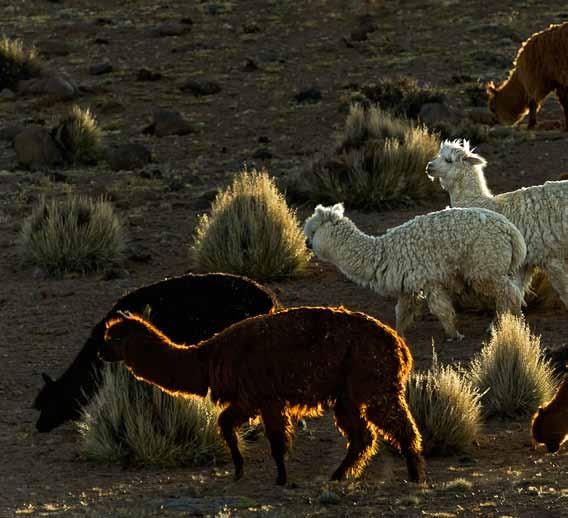

Traveler notes: The naturalist Rodulfo Philippi described for the first time the existence of the Andean flamingo, or parina grande 5 . The flamingo population here is important because three of the world’s six flamingo species inhabit the area. In his book Las aves de Chile (Birds of Chile) Philippi explains the tremendous impression made by the flamingos: “seeing us so close upon them, nearly all of the flamingos took flight, flying into the heavens with their beautiful, rosetinted wings. But soon they returned, giving us the chance to closely observe them and confirm that the great majority were Phoenicoparrus andinus and Phoenicoparrus chilensis ”6 .
Notas de viajero: El naturalista Rodulfo Philippi describe por primera vez la existencia del flamenco andino o parina grande 5 La relevancia de esta especie tiene que ver con que tres de los seis tipos de flamencos que existen en el mundo habitan en este parque. En el libro Las aves de Chile , Philippi cuenta con gran impresión: “al vernos aparecer tan de cerca casi todos alzaron el vuelo, y llegaron al cielo con sus lindos tintes rosados. Pero luego volvieron, dándonos la oportunidad de observarlos bien y determinar en detalle que la gran mayoría eran Phoenicoparrus andinus y Phoenicoparrus chilensis ” 6 e species con problemas de conservación: La vicuña y el quirquincho de la puna se consideran en peligro de extinción, mientras que la llareta, el flamenco chileno, la parina chica, la parina grande, el puma, la perdiz de laguna y el ñandú están clasificadas como vulnerables.
5 Yerko A. Vilina, Hernán Cofré, Carolina Pizarro: “Final Report: Waterbirds in Chile”, Waterbird conservation for the Americas, 2006, p. 2.

6 J. D. Goodall, Alfredo William Johnson, Rodolfo A. Philippi Bañados: Las aves de Chile: su conocimientos y sus costumbres [Birds of Chile: their knowledge and customs], vol I, Platt Establecimientos Gráficos, 1957, p. 113.
5 Yerko A. Vilina, Hernán Cofré, Carolina Pizarro: “Reporte final: Aves acuáticas en Chile”, Waterbird conservation for the Americas, 2006, p. 2.
6 J. D. Goodall, Alfredo William Johnson, Rodolfo A. Philippi Bañados: Las aves de Chile: su conocimiento y sus costumbres , vol I., Platt Establecimientos Gráficos, 1957, p. 113.
species in need of conservation: The vicuña and the partridge of the puna are in danger of extinction. The yareta, the Chilean flamingo, the James’s flamingo, the Andean flamingo, the puma, the lagoon partridge and the lesser rhea are classified as vulnerable.
The vicuña is a special case because it was classified as “endangered” by the Ministry of the Environment – making this NM all the more important in the effort to assure its preservation.
The Andean fox and the lesser rhea have not been sufficiently studied to allow a correct categorization 7
relationship with pre- h ispanic cultures: The Aymara culture and language also share the lands encompassed by the Surire Salt Flat. The language is still spoken by the indigenous people living in the Altiplano and ravines of northern Chile. The Aymara community believed nature to be divine, but “at the same time legitimatized mankind’s existence and functioning within it”8
7 “National inventory of species”, Ministry of the Environment.
8 Juan Van Kessel: “La cosmovisión aymara” [The Cosmovision of the Aymara], in Culturas de Chile , vol. II, Ed. Andrés Bello, Santiago, Chile, 1996.
Un caso especial es el de la vicuña, que fue clasificada como “en peligro” por el Ministerio del Medio Ambiente, lo que hizo de este MN un hito de especial importancia para su preservación. El zorro culpeo y el ñandú no han sido lo suficientemente estudiados como para categorizarlas correctamente 7 .
relación con culturas prehispánicas: El espacio conformado por el Salar de Surire debe comprenderse dentro de la lengua y la cultura aimaras. Esta lengua es utilizada hasta el día de hoy por la etnia que habita el altiplano y las quebradas de las primeras regiones de Chile. La comunidad aimara considera a la naturaleza como la divinidad misma, pero “al mismo tiempo legitima la posición y función existencial del hombre en este medio”8

L LA re TA .
s cientific name : Azorella compacta. Conservation status : Vulnerable. This tiny flowering endemic plant grows in the form of a “compact” cushion, which is the reason for its scientific name. This morphology minimizes heat loss during the night and, being close to the ground, also benefits from the natural ground heat resulting from the absorption of sun radiation during the day. This plant grows extremely slowly on very poor and stressed earth. Many of these plants can be as much as 3,000 years old. At some places, at certain times, they were burned by artisan mining industries, a practice that still occurs in a lesser degree today. As a result, its numbers are falling significantly.
Lesser r he A (dA rW i N ’s r he A ).
s cientific name : Rhea pennata tarapacensis.

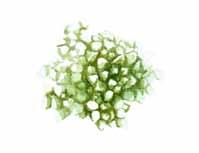
Conservation status : Vulnerable. A large sized bird, as much as a meter high, without taking into account its neck. Although it cannot fly, it can run as fast as 60 km/hr in the high plains (in the case of its subspecies tarapacensis ) and in Patagonia (subspecies pennata ). Northern populations are more threatened, mostly because of egg theft and because of the fragmentation of its habitat.
A N de AN fLAM i N go.
s cientific name : Phoenicopterus andinus. Conservation status : Vulnerable. This bird species lives in the high plains lakes of Chile, Bolivia and Argentina. Like all flamingos, it feeds by filtering microorganisms and small surface animals, mostly diatoms, through its beak. In summer months the birds migrate toward lower land and are able to fly as much as 700 kms in one day. In earlier times their eggs were poached, but the most important threat today is the change


JAM es’s fLAM i N go.
s cientific name : Phoenicopterus jamesi. Conservation status : Vulnerable. This is the smallest of Chilean flamingos. They move in groups in the high altitude lagoons looking for food, which is mostly plancton that is filtered by a specially developed beak, a trait typical of flamingos. They build cone-shaped nests and lay a single egg. During mating seasons the whole colony can be seen “dancing,” which is, in fact, a complex mating ritual.
A N de AN Ar MA di LLo.
s cientific name : Chaetophractus nationi. Conservation status : Endangered. This is a nocturnal solitary creature inhabiting the sandy soil of the high plains, where it digs its nest. It is still hunted today, mostly for its meat and for its skin, used for making charangos and for artwork made of skin.
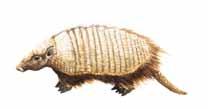
v i C uñ A
s cientific name : Vicugna vicugna. Conservation status : Endangered. The smallest of the cameloid family and, together with the guanaco, one of the two undomesticated cameloids in the Americas. In earlier times its population fell sharply, but today it is in recuperation and growing thanks to proactive conservation programs. It is highly valued because of its fine wool, which is very resistant to freezing temperatures of the high plains. They feed almost exclusively on grasses.
L LA re TA .
Nombre científico: Azorella compacta. e stado de conservación: Vulnerable Esta planta endémica de la puna crece con forma de cojín “compacto”, a lo que debe su nombre científico. Esta morfología minimiza las pérdidas de calor durante la noche y, por otro lado, la mantiene cerca del suelo, donde las temperaturas son uno o dos grados Celsius más altos durante la noche, debido a que el suelo emite la radiación que recibe durante el día. Crecen extremadamente lento y en terrenos en extremo pobres y estresantes. Muchos individuos llegan a los 3.000 años de edad. En algunos tiempos y zonas, la llareta se quemó en industrias mineras artesanales, lo que parcialmente aún se hace en nuestros días. Por eso su población disminuyó significativamente.

ñAN dú.
Nombre científico: Rhea pennata tarapacencis. e stado de conservación: Vulnerable. Ave de tamaño considerable que llega al metro de altura, sin considerar el cuello. Aunque no puede volar, corre hasta los 60 km/h por las planicies del altiplano (en el caso de la subespecie tarapacensis ) y la Patagonia (la subespecie pennata ). Las poblaciones más nortinas están más amenazadas, principalmente por la recolección de huevos y la fragmentación de su hábitat.
PA ri NA gr AN de. Nombre científico :Phoenicopterus andinus.
e stado de conservación: Vulnerable. Habita en las lagunas del altiplano chileno-boliviano-argentino. Como todo flamenco, se alimenta filtrando microrganismos y pequeños animales de la superficie, principalmente diatomeas en este caso. Durante el verano migra hacia tierras más bajas, pudiendo volar hasta 700 kilómetros en un solo día. En el pasado sus huevos eran recolectados, pero hoy la principal amenaza es la alteración de las fuentes de agua por uso humano.
PA ri NA C hi CA .
Nombre científico : Phoenicopterus jamesi.
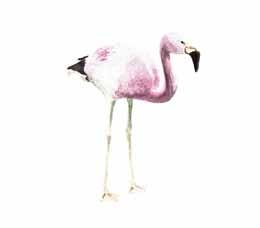

e stado de conservación: Vulnerable. Es el menor de los flamencos chilenos. Se mueve en grupos por lagunas de la puna, en busca de alimento, el que consiste en plancton que filtra con su pico provisto de barbas, rasgo típico de los flamencos. Construye un nido de barro de forma cónica donde pone un solo huevo. Durante la temporada de apareamiento puede verse a toda la colonia “bailando”, lo que corresponde a un complejo ritual de apareamiento.
Quir Qui NC ho de LA P u NA .
Nombre científico : Chaetophractus nationi.
e stado de conservación: En peligro. Este quirquincho es una criatura mayoritariamente nocturna y solitaria, que habita los suelos arenosos del altiplano, donde excava sus madrigueras. Aún hoy es habitualmente cazado por su carne, y para construir charangos y artesanías con su coraza.
v i C uñ A .
Nombre científico : Vicugna vicugna. e stado de conservación: En peligro. Este camélido es el más pequeño de su familia y, junto con el guanaco, uno de los dos camélidos no domesticados de América. Antaño su población disminuyó dramáticamente, pero hoy está recuperada y aumentando gracias a programas activos de conservación. Es muy apreciada por su fina lana, que le permite resistir las temperaturas de congelación del altiplano. Se alimenta casi exclusivamente de pastos.
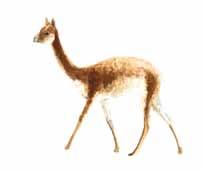


Natural Monument (NM) d eclaration d ate: 2112 1
Location: Region XV of Arica and Parinacota, Province and Arica County.
surface area: 11,325.71 hectares.
Name origin: The name alludes to the presence of groups of large sized candelabra cacti. This is the most notable flora within the area, and the most important to preserve.
Motive for conservation: The idea is to preserve the desert shrublands, made up of plant species with sophisticated ways of adapting to the climate extremes found in the Atacama desert. One of these plant species is the candelabra cactus. Prehistoric archeological sites have been found within this NM, related to ancient trade and communication routes. Prehistoric paintings are also found here. 1 www.conaf.cl Reviewed July 3, 2012.
fecha de creación como Monumento Natural (MN): Año 2012 1
u bicación : XV Región de Arica y Parinacota, provincia y comuna de Arica.
superficie: 11.325,71 hectáreas.
o rigen del nombre: Alude a la presencia de los cardos de cactus candelabros de gran tamaño, que son la flora que más destaca y que se quiere preservar dentro de esta zona.
Motivo de conservación: Preserva la formación de matorral desértico, compuesta de especies vegetales con sofisticadas adaptaciones al clima extremo del desierto de Atacama, entre las cuales destaca el cactus candelabro. Dentro de sus límites se ha encontrado sitios arqueológicos prehispánicos relacionados con rutas de comunicación y comercio, así como pinturas rupestres.
1 www.conaf.cl Revisado 3-7-2012.
 Cactus Candelabro (Browningia candelaris )
Cactus Candelabro (Browningia candelaris )
g eographic and climatic characteristics: This is a desert climate. There is little rainfall and the average temperature is 15 °C. In the Huaylillas mountain range, which is part of the Tertiary Rhyolite formation, begins the Cardones ravine. On the sharply sloped sides of this range are cactus formations called cardones
f lora: The most important is the candelabra cactus (Browningia candelaris ) because of its great size and its branch arrangement, which makes it look like a candelabra 2 It grows naturally in the mountain foothills or precordillera , in extremely dry areas between 1,700 and 3,000 meters high 3
Características geográficas y climáticas: El clima es desértico, con ausencia de precipitaciones y una temperatura promedio de 15 °C. En la sierra de Huaylillas, cordón montañoso correspondiente a la formación riolítica de edad terciaria, nace la quebrada seca de Cardones. En sus laderas de fuertes pendientes se aprecia la cactácea llamada cardón.

f lora: Destaca el cactus candelabro (Browningia candelaris ) por su gran tamaño y sus ramificaciones situadas en la parte superior, que lo asemejan a este objeto 2 . Crece de forma natural en la precordillera, entre los 1.700 metros y los 3.000 metros de altitud, en condiciones de extrema sequedad 3 .
2 Luis A. Raggi: “Guía para el turismo aventura y el turismo científico” [Guide for adventure and scientific tourism], IV World Congress of Mountaineering Medicine and Altitude Physiology, XV Annual Meeting of the Chilean Society of Physiological Science, and VII Chilean Congress of Physical Exercise Science. Universidad de Chile, 2000, p. 7.
3 www.chilebosques.cl Reviewed July 3, 2012.
2 Luis A. Raggi: “Guía para el turismo aventura y el turismo científico”, IV Congreso Mundial de Medicina de Montaña y Fisiología de Altura, XV Reunión anual de la Sociedad Chilena de Ciencias Fisiológicas, y VII Congreso Chileno de Ciencias del Ejercicio Físico. Universidad de Chile, 2000, p. 7.
3 www.chilebosques.cl Revisado 3-7-2012.




fauna: Animal life includes insects, reptiles, birds and mammals. There are a large number of insects associated with the pollination process. Hummingbirds are among the most important bird species, as well as other species that vary according to season. Mammals include Southern viscacha (Lagidium viscacia ), small rodents, foxes, guanacos and lizards 4
Public usage and community relationship with the NM: While there is no human settlements near this NM, there is archeological evidence of pre-Hispanic and post-Hispanic human activity.
The value of the NM has to do with its flora, its fauna and its history – and how these all interact. Visitors can explore and observe the very unique landscape and connect to the area’s past history.
species in need of conservation: The candelabra cactus is considered to be vulnerable, which is why the ravines where large groups of this cacti grow are given priority protection. In terms of animal life, the Southern viscacha, a kind of mountain rabbit related to the chinchilla , is in danger of extinction.
relationship with pre- h ispanic cultures: There is an important archeological site, Los Aleros de Pampa del Muerto, a spacious rock overhang found on the Eastern slope of the Huaylillas, between the Azapa and Cardones ravines. Seventeen different prehistoric paintings have been found there, linked to hunters and gatherers from the late Paleolithic Era.
At this same location are found seven species of the genus Oreocereus , within the Cactaceae (cactus) family. These cacti are all related to the mountain cactus, so named because of its ability to grow in mountain areas 5 .
4 “Quebrada Cardones: primer área silvestre protegida de Arica” [Cardones Cliff: the first protected wilderness area of Arica], La Estrella de Arica , Monday 12 of January, 2009.
5 Magdalena García, Marcela Sepúlveda: “Contextos vegetales de aleros con pinturas (precordillera de Arica, norte de Chile)” [Vegetative context of painted hillsides (central mountain range of Arica, north of Chile)], Estudios Atacameños, Arqueología y Antropología Surandinas , N° 41, 2011, pp. 103-112.
fauna: Incluye insectos, reptiles, aves y mamíferos. La gran cantidad de insectos se asocia a la polinización de las especies presentes. Entre las aves destaca el picaflor, y otros tipos de aves fluctúan dependiendo de la estación. Completan el cuadro las vizcachas (Lagidium viscacia ), roedores de talla menor, zorros, guanacos y lagartijas 4
relación con los habitantes y usos del MN: Si bien en la actualidad no hay asentamientos humanos, Cardones es un sitio arqueológico de data prehispánica y posthispánica.
La puesta en valor de este MN se debe al modo en que se conjugan la fauna, la flora y la historia. Los visitantes pueden caminar y observar un paisaje muy peculiar y característico de la zona, y así entrar en conexión con el pasado histórico de la región.
e species con problemas de conservación: El cactus candelabro está considerado como vulnerable, razón por la cual se hace prioritario proteger las quebradas donde existen poblaciones considerables. En cuanto a la fauna, la vizcacha se encuentra en peligro de extinción.
relación con culturas prehispánicas: Existe un importante sitio arqueológico llamado Los Aleros de Pampa del Muerto, ubicado en el faldeo oriental de Huaylillas, entre las quebradas de Azapa y Cardones. Allí se han reconocido 17 aleros con pinturas, cuyas ocupaciones han sido vinculadas a caravaneros y cazadores tardíos. En este mismo lugar se ha hallado siete ejemplares de cactáceas afines a Oreocereus , que en latín significa “cactus de montaña”, en referencia a su característica de crecer en altura 5 .
4 “Quebrada Cardones: primer área silvestre protegida de Arica”, La Estrella de Arica , lunes 12 de enero de 2009.
5 Magdalena García, Marcela Sepúlveda: “Contextos vegetales de aleros con pinturas (precordillera de Arica, norte de Chile)”, Estudios Atacameños, Arqueología y Antropología Surandinas , n° 41, 2011, pp. 103-112.

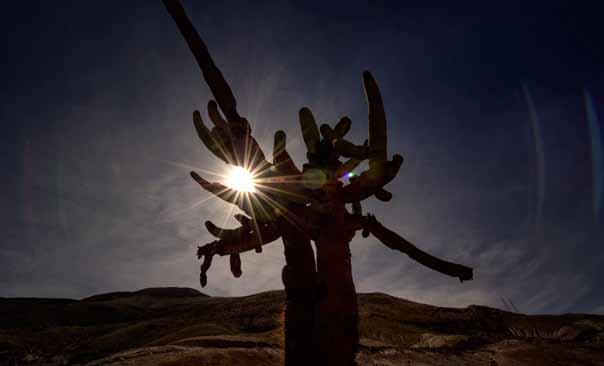


C AN de LAB rA C ACT us.
s cientific name : Browningia candelaris.
Conservation status : Vulnerable. This cactus can grow as much as six meters tall with is sculptured form, similar to a candelabra. It is endemic to the ravines in the high plains of northern Chile and southern Peru, in altitudes of between 1,700 and 3,000 meters above sea level.

s ou T her N v is CAC h A .
s cientific name : Lagidium viscacia.
Conservation status : Endangered. This rodent, which looks like a rabbit, has thick abundant soft fur that protects it from the low desert and mountain night temperatures. It lives in rocky formations between the Antofagasta and Aysén Regions. In earlier times its population fell dramatically because it was hunted for its fur.
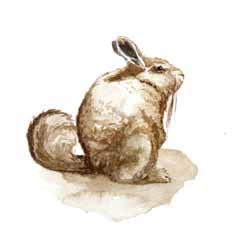
s ou T h A M eri CAN gr Ay fox
s cientific name : Pseudalopex griseus.
Conservation status : Low risk.
A solitary animal that feeds on rodents, young pigeons, bird eggs, fruit, seeds and insects. Roams the shrub-steppe landscapes, where it reproduces each spring with up to five pups. It occasionally attacks chicken coops, and it is common in Patagonia to put traps with poisoned meat. Its numbers have fallen in some areas where it is also hunted by abandoned dogs. Also found in : Dos Lagunas, Contulmo, Pichasca, and Quebrada Cardones.

C ACT us CAN de LAB ro, CA rdó N . Nombre científico : Browningia candelaris. e stado de conservación : Vulnerable. Esta cactácea puede llegar a los seis metros de altura con su escultórica estructura, similar a un candelabro. Es endémico de las quebradas del altiplano en el norte de Chile y sur de Perú, entre los 1.700 y 3.000 metros sobre el nivel del mar.
v izCAC h A .
Nombre científico : Lagidium viscacia. e stado de conservación : En peligro. Este roedor, parecido a un conejo, tiene un abundante pelaje grueso y suave con el que se protege de las bajas temperaturas propias de la cordillera y del desierto en la noche. Habita en recovecos de formaciones rocosas entre las regiones de Antofagasta y Aysén. Antaño sus poblaciones disminuyeron dramáticamente debido a que eran objeto de caza por su pelaje.
zorro C hi LLA .
Nombre científico : Pseudalopex griseus. e stado de conservación : Riesgo menor. Se alimenta de roedores, pichones, huevos de ave, frutos, semillas e insectos. Usa las áreas de estepa y matorral, donde se reproduce en primavera y tiene hasta cinco crías. Ocasionalmente puede atacar los gallineros, por lo que los habitantes de la Patagonia le ponen trampas y/o carroña envenenada. Su población ha disminuido en algunas zonas debido a que es presa de jaurías de perros domésticos abandonados. Hábito solitario. : Dos Lagunas, Contulmo, Pichasca, Quebrada Cardones.



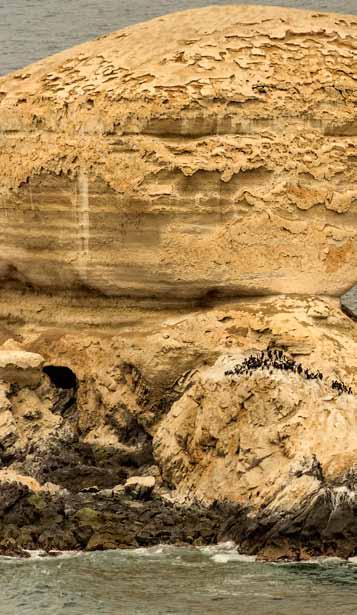

Natural Monument (NM) d eclaration d ate: October 5, 1990.
Location: Region II of Antofagasta, Antofagasta Province, Antofagasta County.
surface area: 31.27 hectares 1
Name origin: The name alludes to its form, since the word portada is used to denote either the cover of a book, or a decoration placed on the entrance of a building. In the case of this NM, its arched form can be perceived as a “doorway” to the sea.
Motive for conservation: The rock formation itself is a regional symbol worthy of protection. But it is also an important source of “fingerprints” left by past eras, since within the different geological layers are abundant fossils of marine animal life. It is also a rookery for a large number of birds, both permanent residents and migratory, which visit the area to feed. Some of these bird species confront conservation problems.

g eographic and climatic characteristics: The NM has a coastal desert climate, characterized by abundant cloud cover that results from the constant evaporation of the sea from waves crashing against the cliff, which serves as a kind of climate divider. It is from this natural cliff formation, characteristic of the Coastal Mountain Range throughout the Norte Grande zone, which falls abruptly to the sea, that the beauty of this NM can be appreciated. The average yearly rainfall is 0.6 mm, with periods of drought lasting as long as eight years. The average yearly temperature is 15 °C.
f lora: There are no plant species here.
fauna: There are 30 different species of birds, mammals and reptiles, many of which are endemic. Most notable are the Guanay shag (Phalacrocorax bougainvillii ), the Peruvian tern (Sterna lorata ), the Atacama lava lizard (Microlophus atacamensis ), the Peregrine falcon (Falco peregrinus ) and the grey gull.
fecha de creación como Monumento Natural (MN): 5 de octubre de 1990.
u bicación : II Región de Antofagasta, provincia y comuna de Antofagasta.
superficie: 31,27 hectáreas 1 .
o rigen del nombre: Alude a su forma física, ya que la palabra “portada” se utiliza, en general, para denominar la primera página o la tapa de un libro, o un adorno arquitectónico situado en la fachada principal de un edificio. En el caso de este MN, su forma de arco se percibe como una “puerta” en medio del mar.
Motivo de conservación: La formación rocosa representa por sí sola un símbolo regional digno de conservar, pero es también una importante fuente de huellas de eras pasadas, ya que entre sus capas geológicas sedimentarias abundan los fósiles de animales marinos. Es lugar de nidación de gran cantidad de aves permanentes o migratorias que visitan el área y se alimentan en los alrededores, algunas de ellas con problemas de conservación.
Características geográficas y climáticas: El MN está bajo la influencia del clima de desierto costero, por lo que abundan los cielos nublados. Esto, debido a la constante evaporación del mar que se topa con el farellón de la costa, que actúa como biombo climático. Es desde este farellón, formación natural característica de la Cordillera de la Costa en la zona del Norte Grande, y que cae de forma abrupta al mar, que se puede observar la belleza de este MN. El promedio anual de precipitaciones es de 0,6 mm, con periodos de más de ocho años sin llover, y la temperatura media anual es de 15 °C.
f lora: No contiene especies vegetales.
fauna: Alcanza a unas 30 especies entre aves, mamíferos y reptiles, muchas de las cuales son endémicas. Destacan el guanay (Phalacrocorax bougainvillii ), el gaviotín chico (Sterna lorata ), el lagarto corredor de Atacama (Microlophus atacamensis ), el halcón peregrino (Falco peregrinus ) y la garuma. 1 www.conaf.cl Revisado 3-7-2012.

Public usage and community relationship with the NM: Birds are the dominant fauna in this NM because of its location. This results in the accumulation of guano (bird dung) on the rocks, creating a very valuable fertilizer for the agricultural market. Since this guano is produced within a protected area, it is necessary to maintain it as part of the monument’s natural value. Still, the guano has been exploited commercially. In 2010 two people were arrested transporting 2,000 kilos of this valuable white fertilizer2 This Natural Monument’s value resides in the quality of the landscape, composed of the form of the monument and its surroundings. It is an important touristic icon and is strongly identified with the area.
species in need of conservation: The Peregrine falcon, the Atacama lava lizard and the grey gull are vulnerable species, while the Peruvian tern is in danger of extinction. The fragility of these populations is due in part to the overexploitation of guano reserves throughout Peru and Chile in the past, and the commercial over-fishing of today.

relationship with pre- h ispanic cultures: In pre-Hispanic times the coasts of the area were inhabited by the changos , an aborigine canoe culture of northern Chile. Their boats were made of sea lion skins and they extracted marine resources to sustain themselves and for trade. Later, the discovery of guano made the local economy more dynamic. Among the most notable explorers is Juan López, a chango who is said to have been among the first to settle in a place that today is known as the city of Antofagasta 3

relación con los habitantes y sus usos: Debido a la ubicación geográfica de este MN, a su alrededor la fauna predominante son las aves. Estas dan paso a la acumulación de guano sobre la roca, siendo un recurso muy preciado como fertilizante en el mercado agrícola. Debido a que el guano se produce en un área protegida, es necesario preservarlo como parte del valor natural del monumento. Pese a ello, se ha detectado una insistente extracción. El año 2010 se detuvo a dos personas que transportaban desde el área dos mil kilos del preciado fertilizante blanco 2
El valor de este MN es la calidad paisajística que conllevan su forma y su entorno. Es un elemento fundamental para el turismo y le da, además, un fuerte carácter identitario a la zona.
e species con problemas de conservación: El halcón peregrino, el lagarto corredor y el guanay son especies vulnerables, mientras que el gaviotín chico está en peligro de extinción. La fragilidad de estas poblaciones se debe, en parte, a la sobreexplotación que en el pasado se hizo de las guaneras del norte de Chile y sur de Perú, y a la actual sobrepesca.
relación con culturas prehispánicas: En tiempos prehispánicos, las costas de esta zona se hallaban pobladas por los changos, una cultura aborigen canoera del norte. Con sus balsas de cuero de lobo, extraían recursos marinos para alimentarse y comerciar. Más tarde, el descubrimiento del guano dinamizó económicamente la región. Entre los exploradores más célebres destaca Juan López, un chango de quien se dice que fue uno de los primeros en fijar su residencia en lo que hoy es la ciudad de Antofagasta 3


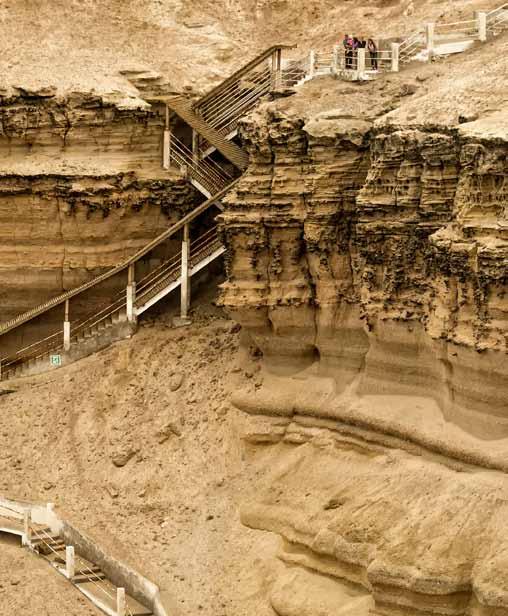
g uANAy Cor M or ANT.
s cientific name : Phalacrocorax bougainvillii.
Conservation status : Vulnerable. This cormorant inhabits the coasts of southern Peru and northern Chile. It dives under water to capture its food – usually anchovies. The loss of its habitat due to the guano boom and to overfishing has put its population at risk.
Peregri N e fALCo N
s cientific name : Falco peregrinus.
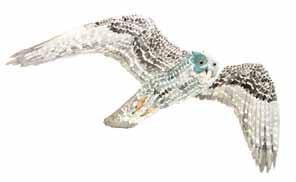

Conservation status : Low risk in terms of world distribution, vulnerable in Chile. A bird of prey that hunts other birds all over the world. It ambushes its prey at a speed of up to 300 km/h, making it the fastest bird on the planet. In Chile inhabits the subspecies cassini
sMALL Ter N .
s cientific name : Sternula lorata.
Conservation status : In danger. This maritime bird has a range limited to the northern coast of Chile and the southern coast of Peru. It traps fish in flight and nests in desert areas far from the coast.

L AvA Liz A rd.
s cientific name : Microlophus atacamensis.
Conservation status : Vulnerable. Lizard that inhabits the rocky coastal areas of Antofagasta. Feeds on algae and animals that remain exposed at low tide, like crabs and mollusks.

g uANAy.
Nombre científico : Phalacrocorax bougainvillii.
e stado de conservación : Vulnerable. Cormorán que habita las costas del sur de Perú y del norte de Chile. Se sumerge para capturar principalmente anchoveta. La pérdida de hábitat durante el auge del guano y la sobrepesca han puesto su población en riesgo.
hALCó N Peregri N o. Nombre científico : Falco peregrinus. e stado de conservación : Riesgo menor en su distribución mundial, vulnerable en Chile.
Rapaz que caza aves en todo el planeta. Las embosca a una velocidad de hasta 300 km/h, siendo el ave más veloz registrada. En Chile habita la subespecie Cassini
gAvioT í N C hi Co. Nombre científico : Sterna lorata. e stado de conservación : En peligro. Esta ave marina tiene una restringida distribución en la costa del norte de Chile y el sur de Perú. Atrapa peces al vuelo y anida en zonas desérticas alejadas de la línea costera.
Corredor de ATACAMA
Nombre científico : Microlophus atacamensis. e stado de conservación : Vulnerable. Lagarto que habita en roqueríos en el intermareal de Antofagasta, se alimenta de algas y animales que quedan expuestos al bajar la marea, como jaibas y moluscos.


Natural Monument (NM) d eclaration d ate: It was declared a National Park in 1972; in 1983 it was considered not applicable to that category, and in 1985 it was declared a NM.
Location: Region IV of Coquimbo, Limarí Province, Río Hurtado County.
surface area: 128 hectares.
Motive for conservation: Contains important paleontological material such as remains of animal fossils, and fossilized vegetation that once formed a forest. There are also prehistoric paintings and other signs of the presence of pre-Columbian cultures, which makes it necessary to protect the site for archeological investigation. In addition, within the area exist diverse species of plants in need of conservation.
g eographic and climatic characteristics: Categorized as an arid Mediterranean climate (Di Castri, 1976). Average maximum temperatures reach the 30 °C in January, and minimum temperatures register a mean of 4 °C in June. The precipitation mean reaches 119 mm in rainy years, concentrated within the months of May through August 1
f lora: The NM is located in an interior arid or secano zone, meaning it is composed of xerophytic vegetation, and of which the majority of plant species have various levels of vulnerability in terms of conservation 2 . This area is part of an ecosystem containing dry sectors of the intermediate depression and the eastern slope of the Coastal Mountains Range. Noteworthy species are the Northern olivillo (Proustia bacharoides ), the carbonillo (Cordia decantra ), the red espino (Calliandra chilensis ), and diverse cactus species such as the copao (Eulychnia acida ) and the quisquito (Eryosice curvispina ).
1 www.conaf.cl Reviewed July 4, 2012.
2 www.conaf.cl Reviewed April 10, 2012.
fecha de creación como Monumento Natural (MN): En 1972 se lo declara Parque Nacional; en 1983 se desafecta de esta categoría y en 1985 se convierte en MN.
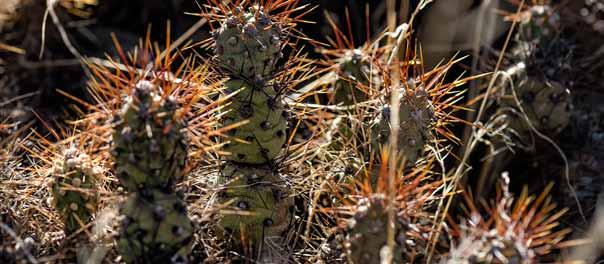
u bicación : IV Región de Coquimbo, provincia de Limarí, comuna de Río Hurtado.
superficie: 128 hectáreas.
Motivo de conservación : Contiene importantes fuentes paleontológicas, como fósiles de especies vegetales que alguna vez formaron un bosque, y restos fosilizados de animales. También se encuentran rastros de culturas precolombinas en forma de pinturas rupestres y otras señales de presencia humana, lo que hace necesaria su protección para la investigación arqueológica. Asimismo, alberga diversas especies vegetales con problemas de conservación.
Características geográficas y climáticas: Se inserta en el contexto del clima mediterráneo árido (Di Castri, 1976). Sus temperaturas máximas alcanzan en promedio los 30 °C en enero, y las mínimas una media de 4 °C en junio. Las precipitaciones medias llegan a 119 mm en años lluviosos, concentradas entre los meses de mayo y agosto 1 .
f lora: El MN se ubica en una zona de secano interior, por lo que su formación vegetacional es de carácter xerofítica, estando la mayoría de estas especies con algún tipo de problema de conservación 2 . Esta área corresponde a un ecosistema de sectores no regados de la depresión intermedia y la vertiente oriental de la Cordillera de la Costa. Dentro de la flora destacan el olivillo del norte (Proustia bacharoides ), el carboncillo (Cordia decandra ), el espino rojo (Calliandra chilensis ), y diversas cactáceas como el copao (Eulychnia acida ) y el quisquito (Eryosice curvispina ).
1 www.conaf.cl Revisado 4-7-2012.
2 www.conaf.cl Revisado 10-4-2012.
Quisco (Echinopsis chiloensis ).fauna: The area has an abundance of herpetofauna (reptiles and amphibians), including in particular the Chilean iguana (Callopistes palluma ). There are mammals such as the elegant fat-tailed mouse opossum (Thylamys elegans ), known as yaca , the South American gray fox (Pseudalopex griseus ), and birds such as the Chilean mockingbird (Mimus tenca ). In combination with the patrimonial routes and noteworthy flora, the NM is a part of the late cretaceous geological formation (80 million years ago) – known as the late “Dinosaur Age.” Many groups of fossilized insects, modern mammals, birds, and angiosperms (flowering plants) are found from this period 3 . Within this prehistoric fauna there is evidence of the remains of dinosaur bones, in particular the claosaurus and titanosaurus 4 . To better illustrate this fascinating period, the NM has a life-size replica of the titanosaurus. In addition there are findings of fragments of tortoise shells. All of these features make this NM a center of investigation and a knowledge base for the country’s very young scientific discipline of paleontology.
Public usage and community relationship with the NM: The natural beauty of this zone is due in part to the spectacular high vistas along its hiking trails. The landscape beholds a great historical presence: plant and animal fossils of ancient millennia, with an area that proves the existence of preColumbian cultures. In addition there is a close relationship amongst the surrounding communities and the NM, where the potential for tourism provides an opportunity for development.
fauna: Es abundante en herpetofauna, grupo de vertebrados que incluye a reptiles y anfibios, entre ellos la iguana chilena (Callopistes palluma ). También habitan mamíferos como la yaca (Thylamys elegans ) y el zorro chilla (Pseudalopex griseus ), y aves como la tenca (Mimus tenca ). En sintonía con las rutas patrimoniales y la flora excepcional, el MN se sitúa sobre la formación geológica del cretácico tardío (80 millones de años), generalmente conocido como la última porción de la “Era de los Dinosaurios”. En este período encontramos los primeros fósiles de muchos grupos de insectos, mamíferos modernos, aves y plantas florecientes conocidas como angiospermas 3 . Dentro de esta fauna hay evidencia de restos óseos de vertebrados que corresponderían a dinosaurios, en particular coleosaurios y titanosaurios 4 . Para ofrecer una imagen verídica de este último saurio, en el MN hay una réplica a escala real. También se han encontrado fragmentos de caparazones de tortugas. Todo ello determina el atractivo de este MN como centro de investigación y creación de conocimiento en una disciplina poco desarrollada en el país.
relación con los habitantes y usos del MN: La belleza natural de esta zona destaca por sus hermosas vistas en altura y sus senderos de trekking. En conexión con el paisaje se encuentra el gran trasfondo histórico del área: los fósiles evidencian la flora y la fauna de milenios pasados, mientras se recorre un espacio que da cuenta de culturas precolombinas. Asimismo, existe una estrecha relación entre las comunidades aledañas y los potenciales turísticos, configurándose un espacio para el desarrollo de emprendimientos en este sentido.
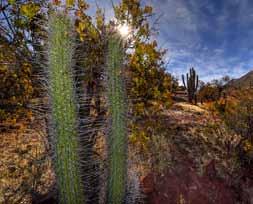
3 www.ucmp.berkeley.edu Reviewed April 10, 2012.
3 www.ucmp.berkeley.edu Revisado 10-4-2012.
4 David Rubilar-Rogers, Rodrigo A. Otero, Roberto E. YuryYáñez, Alexander O. Vargas, Carolina S. Gutstein: “An overview of the dinosaur fossil record from Chile”, Journal of South American Earth Sciences , vol. 37, 2012, pp. 242-255.




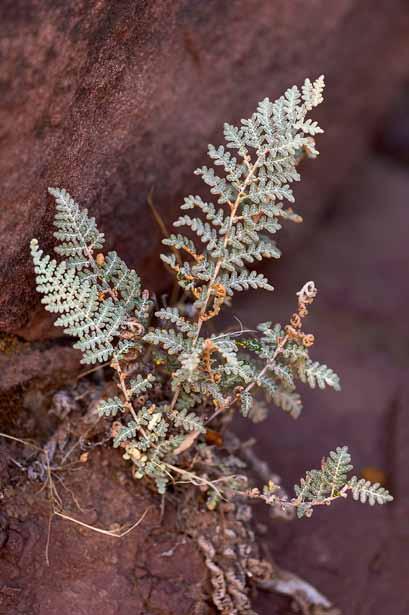
species in need of conservation: The xerophytic vegetation is in a state of vulnerability, with special concern for the quisquito and the carboncillo . Among vertebrates, the Chilean iguana is considered vulnerable, and the elegant fat-tailed mouse opossum is viewed as a rare species.

relationship with pre- h ispanic cultures: Remains of prehistoric paintings, arrowheads, and other articles over 9,000 years old, all correspond to a hunter and gatherer culture 5 . The legume seeds date back to 2,000 BC, and are evidence of the existence of agricultural communities. And in reference to the legume, one of the theoretical origins of the bean is in southern Peru 6 . The pre-Columbian cultures that inhabited this zone are determined by the findings of prehistoric paintings – an archeological artwork known as “Limarí style” – and are associated with the Molle culture, of which the later Diaguita culture was based upon 7. A historical highlight is the later arrival of the Inca, when around the year 1470 the leader Topa Inca Yupanqui realized an expansion of his territory that reached the Aconcagua Valley 8
5 www.educarchile.cl Reviewed April 10, 2012, Ministry of Education.
6 L. Kaplan: “Identificación de porotos arqueológicos de Pichasca”, en M. Rivera ed., Nuevos enfoques de la teoría arqueológica aplicada al Norte Chico [”Identification of the archeological legumes of Pichasca”, in M. Rivera ed., New studies of applied archeological theory of Norte Chico], Acts of the VI Congress of Chilean Archeology, 1971, pp. 308-309.
7 Gonzalo Ampuero Brito: Antiguas culturas del Norte Chico [Ancient cultures of Norte Chico]. Museo de Arte Precolombino, pp. 20-22.
8 Ibid. p. 28.2
e species con problemas de conservación: La vegetación de tipo xerófita se encuentra en estado vulnerable, al igual que la iguana chilena, el quisquito y el carboncillo. La yaca se considera una especie rara. relación con culturas prehispánicas: Se han descubierto restos de pinturas rupestres, semillas de porotos y puntas de flechas, artículos que superan los 9.000 años y que corresponden a pueblos recolectores y cazadores 5 . Las semillas de porotos datan del segundo mileno a.C y da cuenta de la existencia de comunidades agrícolas; cabe destacar que uno de los centros de origen propuestos para el poroto es el sur de Perú 6 . Las culturas precolombinas que habitaron la zona se determinan por las muestras rupestres encontradas –del tipo arqueológico conocido como “estilo Limarí”– y que luego se asociaron a la cultura Molle, que sentó las bases para el desarrollo de una nueva cultura llamada Diaguita 7. También se debe tomar en cuenta la posterior presencia Inca ya que el líder Topa Inca Yupanqui realizó alrededor de 1470 una expansión territorial que llegó hasta el valle de Aconcagua 8 .
5 www.educarchile.cl Revisado 10-4-2012, Ministerio de Educación.
6 L. Kaplan: ”Identificación de porotos arqueológicos de Pichasca”, en M. Rivera ed., Nuevos enfoques de la teoría arqueológica aplicada al Norte Chico , Actas del VI Congreso de Arqueología Chilena, 1971, pp. 308-309.
7 Gonzalo Ampuero Brito: Antiguas culturas del Norte Chico. Museo de Arte Precolombino, pp. 20-22.
8 Ibid., p. 28.



QuisQui To.
Nombre científico : Eriosyce curvispina. e stado de conservación : Vulnerable. Cactus que habita laderas áridas de Rancagua a Coquimbo. Su baja densidad de población y la recolección ilegal con fines ornamentales lo hacen vulnerable.
C A r B o NC i LLo.
Nombre científico : Cordia decandra. e stado de conservación : Vulnerable. Arbusto endémico del Norte Chico, adaptado a plena exposición solar y condiciones de aridez. e s Pi N o roJ o.
Nombre científico : Calliandra chilensis. e stado de conservación : Casi amenazado. Arbusto endémico del Norte Chico, florece profusamente y con un intenso color rojo.
Co PAo.
Nombre científico : Eulychnia acida. e stado de conservación : Riesgo menor. Este cactus es uno de los elementos característicos del matorral árido del Norte Chico. Produce unas llamativas flores blancas que dan origen a frutos carnosos que son comestibles. En la zona es usado para hacer cercos vivos.
i guANA C hi L e NA .
Nombre científico : Callopistes palluma. e stado de conservación : Rara. Es el reptil más grande de Chile, llegando a los 45cm de largo. Es endémica y habita desde Antofagasta hasta el Bío-Bío. Excava madrigueras donde pone sus huevos.
yACA .
Nombre científico : Thylamys elegans. e stado de conservación : Rara. Especie de zarigüeya de hábitos nocturnos.
QuisQui To.
s cientific name : Eriosyce curvispina. Conservation status : Vulnerable. This is a cactus that inhabits dry slopes from Rancagua to Coquimbo. Its sparse population density and the illegal gathering of this cactus (used for ornamental purposes) make it vulnerable.

C A r B o NC i LLo.
s cientific name : Cordia decandra. Conservation status : Vulnerable. This is a bush endemic to Norte Chico, completely adapted to the solar and dry conditions of the area.

e s Pi N o roJ o.
s cientific name : Calliandra chilensis. Conservation status : Almost threatened. This is a shrub endemic to Norte Chico that flowers profusely with an intense read color.

Co PAo.
s cientific name : Eulychnia acida. Conservation status : Low risk. This cactus is one of the characteristic elements of the arid scrublands of Norte Chico. It produces very striking white flowers that result in a very fleshy, eatable fruit. It is used in the area to build live fences.

Chi L e AN i guANA .
s cientific name : Callopistes palluma. Conservation status : Rare. This is Chile’s largest reptile, as long as 45 cm. It is endemic and lives from Antofagasta to the Bío-Bío. It digs holes where it puts its eggs.

yACA
s cientific name : Thylamys elegans. Conservation status : Rare. This is an unusual mammal species that is active only at night. It is a marsupial that feeds on insects and small vertebrates.

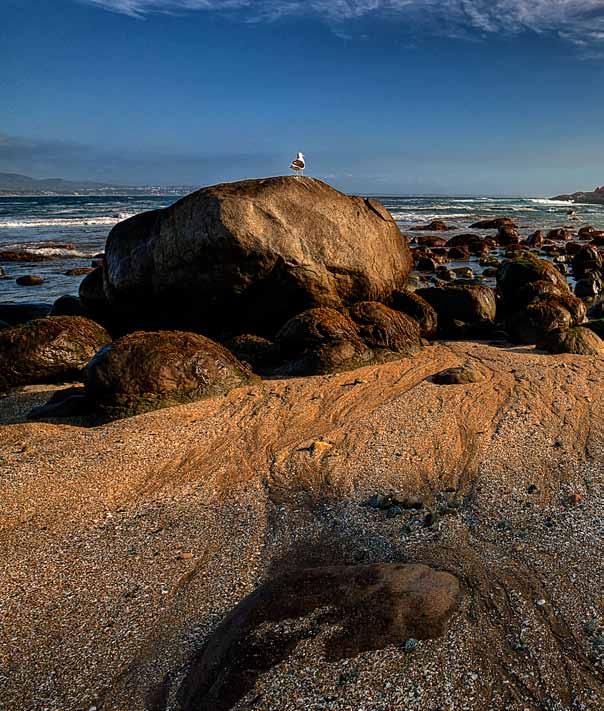
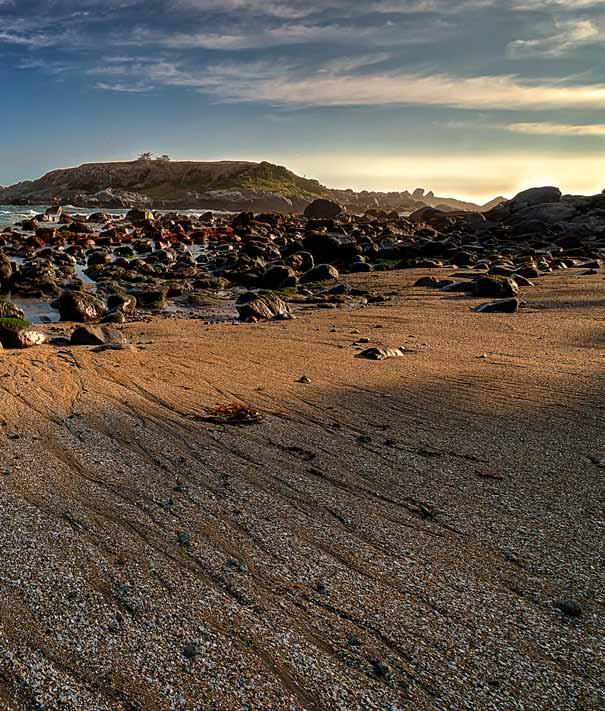
Natural Monument (NM) d eclaration d ate: In 1979 it was declared a Natural Sanctuary and on August 9th, 1989, it was constituted as a NM.
Location: Region V of Valparaíso, Petorca Province, Zapallar County.
surface area: 4,5 hectares.
Name origin: The word Cachagua means “place of grass”, and originates from two words in mapudungún , the language of the native Mapuche people – kachu, which translates to herb or grass, and we , meaning place.
Motive for conservation: It is an important rookery (nesting site) for the Humboldt penguin (Spheniscus Humboldti ), and serves the same purpose for many other marine birds.
g eographic and climatic characteristics: A marine current over 100 meters wide separates this island from the continental coast. The island’s shape is a simple hilltop mesa, and its highest point is 30 meters above sea level. The hillsides are basically rocks and sandy soil, and the northernmost part of the mesa is covered principally with coastal cactus vegetation, known as quisco
f lora: Of the identifiable species, ten are recognized as exotic (introduced, not native), and three are recognized as endemic (native, existing only in a specific habitat). The exotic vegetation is annual, lasting from August to January, and is predominant in the limited areas where perennial (year round) vegetation is able to exist. The native species of most importance are the coastal cacti, the quisco (Echinopsis litoralis ) and its smaller and rounder cousin the quisquito (Eriosyce subgibbosa ), both endemic to Chile’s central coast and classified as vulnerable 1
fecha de creación como Monumento Natural (MN): En 1979 es declarado Santuario de la Naturaleza y el 9 de agosto de 1989 se constituye como MN.
u bicación : V Región de Valparaíso, provincia de Petorca, comuna de Zapallar.
superficie: 4,5 hectáreas.
o rigen del nombre: La palabra Cachagua significa “lugar de pasto”, del mapudungún kachu, traducido como yerba o pasto, y we , lugar.
Motivo de conservación: Es lugar de reproducción, descanso y alimentación de aves marinas; sitio importante para las poblaciones de pingüinos de Humboldt (Spheniscus Humboldti ).
Características geográficas y climáticas: La isla está separada de la costa por un brazo de agua de unos 100 metros de ancho, y su parte más alta alcanza los 30 metros sobre el nivel del mar. Es una colina de baja altura, plana y cubierta de rocas y suelo arenoso en las laderas y la cima, con vegetación principalmente de quisco costero en los sectores norte.
f lora: Se ha identificado diez especies que corresponden a malezas, ocho a especies nativas y tres a endémicas. Las primeras son las que predominan en los reducidos sectores donde existe vegetación permanente. El cien por ciento de las malezas son introducidas (vegetación alóctona), y corresponden a vegetación anual que se da entre los meses de agosto y enero. Las especies nativas de mayor importancia son el quisco costero (Echinopsis litoralis ) y el quisquito (Eriosyce subgibbosa ), endémicas de la costa central de Chile y que se encuentran catalogadas como vulnerables 1



fauna: The lack of human intervention and the excellent environmental conditions allow for an important diversity of bird species to use the island as a rookery, or simply for rest and feeding. The largest population on this small island is the Humboldt penguin (Spheniscus Humboldti ). It is one of the three most important rookeries for this species in Chile, as 15% of the entire national population lives here. Another important inhabitant is the marine otter (Lontra felina ), also known as a sea cat in English and a chungungo in Chilean Spanish. It is a mammal that feeds on the abundant marine life available from the high levels of nutrients flowing in from the Humboldt Current 2
Some of Chile’s more typical coastal species that nest on the ground are also found here, counting over 15 pairs of kelp gulls (Larus dominicanus ), and on some occasions over 3,000 pairs of Chilean pelicans (Pelecanus thagus ).
The American oystercatcher utilizes the vegetation and small depressions in the sand to build their nests. Other habitual residents that use the island as a rest stop or feeding area are the Peruvian booby, sanderling, guanay cormorant, ruddy turnstone, blackish oystercatcher, rufous-collared sparrow, redheaded vulture and the black vulture.
Public usage and community relationship with the NM: This island, apart from being a necessary habitat for important bird species, has a characteristic visual element. For coastal residents the island serves as a point of reference on the sea horizon. As such, the old hacienda of Catapilco plays a historic role. Not only did this NM serve as a viewpoint, it was also part of the hacienda’s domain.
The monument is not open to the public. Exceptions are for research activities authorized by the National Forestry Corporation (CONAF – Corporación Nacional Forestal). However, the coves of Zapallar and Maitencillo can contract boat tour services, when weather permitting, to go around the island to take pictures of the birds and views from the sea 3 .
fauna: La escasa intervención humana y las excelentes condiciones ambientales permiten que una importante diversidad de avifauna use esta área como lugar de reproducción, descanso y alimentación. La mayor presencia la tiene el pingüino de Humboldt (Spheniscus Humboldti ). El islote es uno de los tres lugares más importantes de nidificación de esta especie en Chile, pues en él vive un 15 % de su población nacional. Otro habitante importante es el chungungo (Lontra felina ), mamífero que se alimenta de la riqueza faunística que permiten las aguas con altos niveles de nutrientes de la corriente de Humboldt 2
También se puede avistar especies típicas del litoral chileno que se reproducen en el suelo, contando con más de 15 parejas de la gaviota dominicana (Larus dominicanus ), y en algunas ocasiones más de 3.000 parejas de pelícano (Pelecanus thagus ). El pilpilén utiliza la vegetación y pequeñas depresiones en la arena para construir sus nidos. Otros residentes habituales del islote, que ocupan el área para pernoctar o alimentarse, son el piquero, el playero blanco, el guanay, el playero vuelvepiedras, el pilpilén negro, el chincol y los jotes de cabeza negra y colorada. relación con los habitantes y usos del MN: La isla, además de ser un espacio natural que alberga avifauna valiosa para el país, es un elemento visual característico. Para los habitantes de la costa, el islote se presenta como una constante en el horizonte marítimo. En este sentido, la antigua hacienda de Catapilco juega un rol histórico, pues este MN no solo aportaba al paisaje de la hacienda, sino que era parte de los dominios de la misma.
El monumento no está abierto para uso público, salvo para actividades de investigación, previa solicitud a la Corporación Nacional Forestal (Conaf). Sin embargo, en la caleta de Zapallar y en Maitencillo se puede contratar servicios de paseo en bote, cuando el tiempo lo permite, y rodear el islote para tomar fotografías de las aves marinas o paisajísticas desde la embarcación 3 .
2 Fundación Mar de Chile, www.mardechile.com Revisado 9-5-2012.
3 www.conaf.cl Revisado 9-5-2012.


Traveler notes (h istory): In 1599 the crown of Spain granted the land title of the Catapilco estate to don Pedro de Escobar and Inés de Mendoza as reward for their bravery during the Conquest Period. In 1851, English and United States sailors travelled around the mountainous region of Valparaiso, studying the geography with the mission of installing trains and irrigation canals. It occurred to one of the crewmembers, of the Prat Collier family, to build a tunnel through the Melón mountain range to intersect with and create a reservoir of the Aconcagua River. By way of this tunnel-reservoir, the winter rains generated a volume of 5 million cubic meters of irrigation water. Thus in 1853 the first dam of South America was initiated – a huge step for Chile’s agriculture – and an obvious benefit for Catapilco. Until today, the estate’s principal house is conserved, which was brought from Norway by Francisco Javier Ovalle. In this house the President of the Republic don Francisco Vicuña Larraín, his brother the archbishop of Santiago don Manuel Vicuña Larraín, and the well-known historian Benjamín Vicuña Mackenna resided for long seasons 4 .
species in need of conservation: The Humboldt penguin is a vulnerable species. The last population count indicated a combination of 626 adults and juveniles, 64 chicks of various ages, and 6 eggs in nests 5 . The marine otter, although spotted along Chile’s entire coast, is also considered vulnerable, as well as the coastal cacti the quisco costero and the quisquito.
Notas de viajero (historia): En 1599 se concede la encomienda de Catapilco a don Pedro de Escobar y a Inés de Mendoza, por su valentía en los hechos de la Conquista. Luego, en el siglo XIX, llegará por herencia a las manos de don Francisco Javier Ovalle y de Isabel Vicuña. En 1851, marinos ingleses y estadounidenses recorrieron las montañas de la V Región, observando la geografía con la intención de instalar trenes y canales de riego. A Prat Collier, uno de los tripulantes que participaban en la expedición, se le ocurrió hacer un túnel a través del cordón montañoso El Melón para trasvasijar el río Aconcagua. Con este túnel las lluvias del invierno se encargarían de crear una superficie con cinco millones cúbicos de agua para regar. Así se inicia, en 1853, el primer embalse de América del Sur, un gran paso para la agricultura chilena, y un claro beneficio de la hacienda Catapilco. En esta misma se conserva hasta el día de hoy la casa patronal traída por Francisco Javier Ovalle desde Noruega. En ella pasaron largas temporadas el Presidente de la República don Francisco Vicuña Larraín, su hermano el arzobispo de Santiago don Manuel Vicuña Larraín, y el renombrado historiador Benjamín Vicuña Mackenna 4 .
e species con problemas de conservación: El pingüino de Humboldt se encuentra en estado de vulnerabilidad. En el último censo se contabilizaron 626 ejemplares entre adultos y juveniles, 64 polluelos de varias edades, y 6 huevos en nidos 5 . El chungungo, si bien puede encontrarse a lo largo de toda la costa chilena, también es considerado vulnerable, al igual que las especies quisco costero y quisquito.
4 Cf: Javier Pérez Ovalle: La encomienda de Catapilco [The Granting of Catapilco]. Ed. Andrés Bello, Santiago, 1979, pp. 40-50.
5 Conaf News: “Conaf does a census of penguins in the Cachagua natural monument”, March 11, 2011.
4 Cf: Javier Pérez Ovalle: La encomienda de Catapilco. Ed. Andrés Bello, Santiago, 1979, pp. 40-50.
5 Noticia Conaf: “Conaf censa pingüinos en monumento natural Isla Cachagua”, 11-3-2011.
 Quisco costero ( Echinopsis chiloensis ).
Quisco costero ( Echinopsis chiloensis ).

Pe L i CAN .
s cientific name : Pelecanus thagus. Conservation status : Low risk. This marine bird eats fish that it captures in a bag under its beak. It nests in seaside rock formations and can be seen near fishermen throughout the length of Chile and Peru’s coasts. It lives in colonies together with other species like the kelp gull. Also found in : La Portada.
Ke LP g u LL .
s cientific name : Larus dominicanus.

Conservation status : Low risk. This is the most common of gulls. It lives close to human communities along the coast and river shores throughout the southern hemisphere. It eats domestic scraps and leftovers from artisan fishermen. In its natural habitat it feeds on mollusks, crustaceans exposed by the sea, and fish. Also found in : Islotes de Puñihuil, La Portada.
h u MB o L dT Pe N gui N .
s cientific name : Spheniscus humboldtii.
Conservation status : Vulnerable. Its natural habitat coincides with the Humboldt Current, which means the northern coast of Peru to the southcentral coast of Chile. Along shoreline slopes or in guano (dried and hardened dung) they dig small caves to nest. They eat mostly fish or squid. In recent years their numbers have fallen sharply for a lack of nesting grounds and food, due to man’s depredation and, most of all, because of climatic change phenomena such as El Niño. Their eggs are often eaten by species introduced by man, such as cats, dogs and rats. Fishermen also use their flesh as bait, or occasionally to eat. They are protected by the law in Chile. Also found in : Isla Cachagua.
NeoT ro Pi C Cor M or ANT.
s cientific name : Phalacrocorax olivaceus.


Conservation status : Low risk. This bird is a permanent resident of the coastal waters of the Americas, from the southern United States to Patagonia. It dives underwater to fish and is a great swimmer. It is often seen on top of rocks, extending its wings in order to dry them.
Pe L í CAN o. Nombre científico : Pelecanus thagus. e stado de conservación : Riesgo menor. Ave marina que se alimenta de peces que captura en una bolsa bajo su pico. Anida en formaciones rocosas y suele verse cerca de las caletas de pescadores a lo largo de la costa de Chile y Perú. Vive en colonias junto a otras especies, como la gaviota dominicana. También en : La Portada.
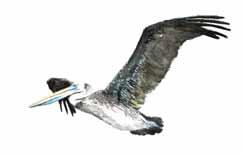
Cor M orá N . Nombre científico : Phalacrocorax brasilianus. e stado de conservación : Riesgo menor. Residente permanente de las costas americanas, desde el sur de Estados Unidos a la Patagonia. Se sumerge para pescar (es un gran nadador). Se suele ver sobre las rocas, extendiendo las alas para secar sus plumas.
gAvioTA do M i N i CANA
Nombre científico : Larus dominicanus. e stado de conservación : Riesgo menor. Es la especie más común de gaviota. Vive íntimamente asociada a comunidades humanas en las costas y riberas cercanas de todo el hemisferio sur, donde se alimenta de desperdicios domésticos y restos de la pesca artesanal. En su hábitat natural su dieta se compone de moluscos y crustáceos expuestos por la marea, y de peces. También en : Islotes de Puñihuil, La Portada.
Pi N güi N o de h u MB o L dT. Nombre científico : Spheniscus humboldtii. e stado de conservación : Vulnerable. Su hábitat natural coincide con la corriente de Humboldt, es decir, desde la costa norte de Perú al centro-sur de Chile. En laderas o en el huano excava pequeñas cuevas donde anida. Se alimenta principalmente de peces o calamares. En los últimos años sus poblaciones se han reducido drásticamente a consecuencia de la escasez de lugares de nidificación, reducción en la oferta de alimentos, depredación por parte del hombre y, sobre todo, el impacto de fenómenos climáticos severos, como El Niño. Sus huevos suelen servir de alimento a especies introducidas por el hombre, como perros, gatos y ratas; también, los pescadores usan su carne como carnada y ocasionalmente como alimento. Está protegido por la legislación chilena. También en : Isla Cachagua.

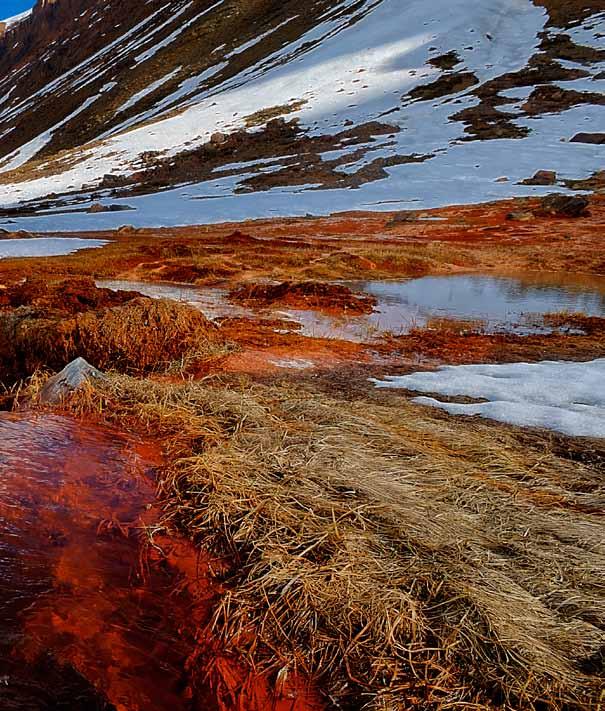
Natural Monument (NM) d eclaration d ate: It was declared a Natural Monument in 1974.
Location: Metropolitan Region, La Cordillera Province, San José de Maipo County.
surface area: 3,009 hectares.
Name origin: The name is a reference to Mount El Morado, which in turn takes its name from the bluish purple color of its rocks 1 .
Motive for conservation: Andean ecosystems are especially fragile. In this NM exist the Andean sclerophyll scrubland and the high-Andean steppe formations. These landscape formations contain a large number of vulnerable plant species that are very interesting in terms of their origin and adaptations. Another motive for its conservation has to do with its geological formation, which showcases the process of glaciation in the region’s basins, where there is paleontological evidence from the Cretaceous Period.
g eographic and climatic characteristics: Natural attractions include the headwaters of the Morales stream, fed from the eternal snowmelts, and the mineral waters called Aguas Panimávidas. At the foot of the mountains is the El Morado lake, covered in ice from June through October2
f lora: The plant life corresponds to the ecologic region of the high-Andean steppe and the ecological sub-region of the Andes’ temperate-Mediterranean zone; which means that two types of vegetation formations are present: the Andean sclerophyll scrubland and the high-Andean steppe of the Santiago Andes.
It is interesting to observe the yareta (Laretia acaulis ) and the frangel (Kageneckia angustifolia ); also, the endemic species –the southern spiny cactus ( Austrocactus spiniflorum ) and the mountain lily ( Alstroemeria umbellata ). This makes the NM an ideal place to observe and preserve a unique plant life 3 .
fecha de creación como Monumento Natural (MN): Año 1974.
u bicación : Región Metropolitana, provincia de La Cordillera, comuna de San José de Maipo.
superficie: 3.009 hectáreas.
o rigen del nombre: Alude al cerro El Morado, que a su vez se denomina así por el color amoratado que tienen sus rocas 1
Motivo de conservación: Los ecosistemas andinos son particularmente frágiles. En este MN se encuentra el matorral esclerófilo andino y la estepa altoandina, compuestos, entre otras, por varias especies vegetales vulnerables, muy interesantes desde el punto de vista de su origen y adaptaciones. Otro motivo de conservación es que su formación geográfica es un exponente del proceso de glaciación en las cuencas de la región, y en él hay evidencias paleontológicas del período cretácico.
Características geográficas y climáticas: Algunas atracciones naturales son el cauce de aguas del estero Morales que nace de los deshielos de las nieves eternas, y las aguas minerales (hierro-carbonatadas) denominadas Aguas Panimávidas.
A los pies de los cerros se impone la laguna El Morado, que permanece cubierta de hielo desde junio hasta octubre 2 .
f lora: Corresponde a la región ecológica de la estepa altoandina y a la subregión ecológica de los Andes mediterráneos, estando presentes dos tipos de formaciones vegetales: el matorral esclerófilo-andino y la estepa altoandina de la cordillera de Santiago. Es de interés observar la llaretilla (Laretia acaulis ) y el olivillo de la cordillera o frangel (Kageneckia angustifolia ); también están el cactus espinifloro y el lirio de cordillera, ambos endémicos de la zona, que hacen de este MN un lugar ideal para observar y preservar ese tipo de plantas 3 .
1 www.conaf.cl Reviewed May 15, 2012.
2 www.rutaschile.cl Reviewed May 15, 2012.
3 www.mma.gob.cl Reviewed May 15, 2012.



fauna: Predominan aves, reptiles y mamíferos. Entre estos últimos son los roedores, principalmente el coruro (Spalacopus cyanus ) y el ratón sedoso de Noé, los que abundan en la zona. Entre las aves es frecuente observar especies como el yal, el cometocino, el chirihue dorado (Sicalis auriventris ), el jilguero negro, el jilguero cordillerano, la golondrinita chilena, el picaflor cordillerano (Oreotrochilus leucopleurus ), el picaflor gigante y el minero. En términos acuáticos se puede observar al pato juarjual (Lophoneta specularioides alticola ), que deriva del pato juarjual tradicional que habita más al sur. Al primero muchos lo llaman “el cordillerano”, pues difiere del tradicional en que habita en las faldas cordilleranas; el sureño lo hace en zonas tierra adentro en el continente, y también cerca de la costa. Otra diferencia es su mayor tamaño, ya que el pato juarjual tradicional mide 50 cm, mientras que el de la laguna El Morado mide unos 60 cm 4
relación con los habitantes y usos del MN: Es un espacio protegido donde es posible pasear, observar y aprender sobre nuestro patrimonio natural.
e species con problemas de conservación: El coruro está clasificado como en peligro, y el frangel u olivillo de cordillera como casi amenazado.

fauna: The animal life is mostly birds, reptiles and mammals. Mammals include rodents, in particular the coruro (Spalacopus cyanus ) and the ratón sedoso de Noé (Euneomys noei ), the latter of which is abundant here. The most frequently observed bird species are common finches, sierra-finches, yellow finches (Sicalis auriventris ), black finches, mountain finches, the Chilean swallow, white-sided Hillstar hummingbirds (Oreotrochilus leucopleurus ), the giant hummingbird and the common miner. Aquatic birds include the crested duck (Lophoneta specularioides alticola ), which is a derivation of the traditional species that lives further south. It is named “el cordillerano” because, unlike the traditional species, it inhabits the Andean foothills. The southern variety lives farther inland from the mountains and also along the coast. This crested duck is also larger, measuring 60 cm, as compared to the 50 cm of its southern brethren 4
Public usage and community relationship with the NM: This is a protected space where you can walk, observe and learn about our natural heritage.
species in need of conservation: The coruro is classified as endangered, and the frangel is classified as closely threatened.
relación con culturas prehispánicas: Este MN fue habitado por una comunidad de recolectores de piñón y cazadores de animales: los indígenas chiquillanes. Gómez de Vidaurre, historiador y naturalista de Chile en el siglo XIX, los califica como la tribu “más bárbara de todas las chilenas”5 . Eran comerciantes de sal, producto que obtenían de las lagunas ubicadas entre los valles cordilleranos, pues ahí ésta “cuaja en abundancia, y muy sabrosa”6 .
Los chiquillanes poblaron este espacio hace ya más de un siglo, atravesando a caballo de un lado a otro de la cordillera, y generando comercio y relaciones sociales con sus vecinos los pehuenches.
relationship with pre- h ispanic cultures: This NM was once inhabited by an indigenous community of hunters and gatherers called the chiquillanes . Their diet was primarily hunted animals and piñón nuts. The 19th century Chilean historian and naturalist Gómez de Vidaurre, described this tribe “as the most barbarous of all the Chilean indigenous groups”5 . They traded salt, which they gathered from northern mountain lakes, because there “the grains are abundant and very tasty”6 .
The chiquillanes populated this territory over a century ago, crossing the mountains on horseback, and generating trade and social relations with their neighbors, the pehuenches
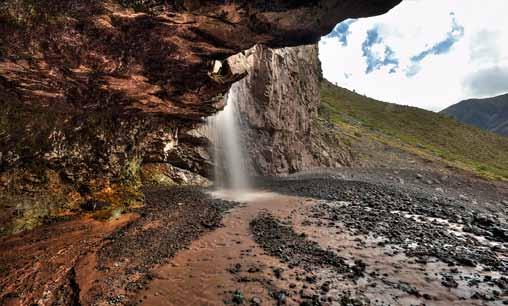
5 Goméz de Vidaurre, en Horacio Zapater: Aborígenes chilenos a través de cronistas y viajeros. Ed. Andrés Bello, Chile, 1978, p. 101.
6 Manuel de Amat y Junyent: “Historia geográfica e hidrográfica con derrotero general correlativo al Reyno de Chile”, en op. cit. Horacio Zapater, Aborígenes… , p. 102.
5 Goméz de Vidaurre, in Horacio Zapater: Aborígenes chilenos a través de cronistas y viajeros [Chilean Aborigines through the eyes of journalists and travellers]. Ed. Andrés Bello, Chile, 1978, p. 101.
6 Manuel de Amat y Junyent: “Historia geográfica e hidrográfica con derrotero general correlativo al Reyno de Chile” [Geographic and hydrographic history with a general correlative course of the Realm of Chile], in op. cit. Horacio Zapater, Aborígenes… , p. 102.
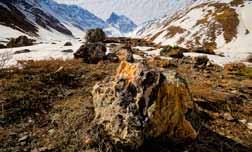



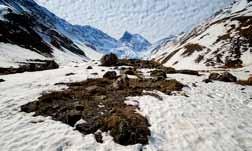
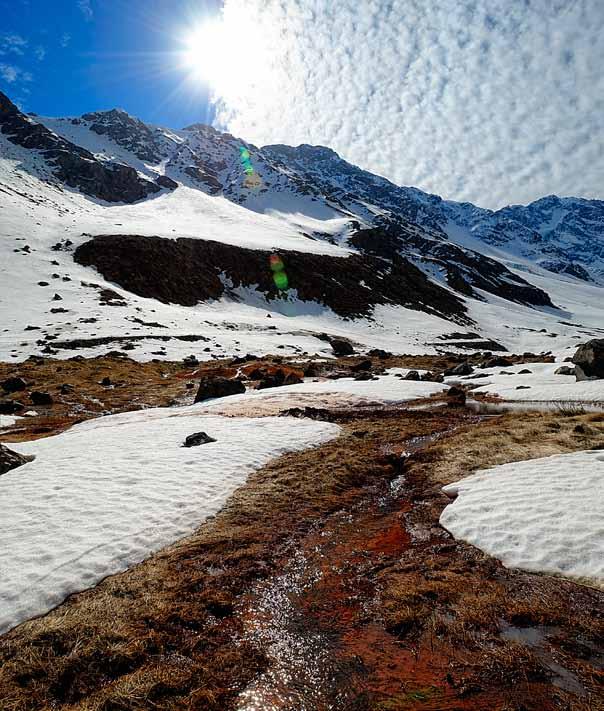

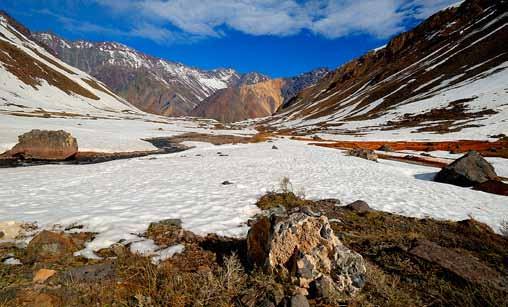
oL ivi LLo.
s cientific name : Kageneckia angustifolia.
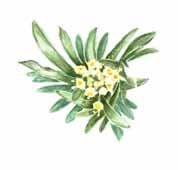

Conservation status : Almost threatened. This tree with sclerophyllous leaves is endemic to the Andes and Coastal mountain ranges of central Chile. In earlier times it was used to make coal, which no doubt greatly harmed its populations. It is the only tree species on the mountain slopes.
yA re TA
s cientific name : Laretia acaulis.
Conservation status : Low risk. This is a tiny, flowering plant forming compact pillows that can resist snow covers for several months. The area beneath this plant formation has a microclimate of its own that allows other plants to withstand the harsh conditions of the Andes mountains.
Coruro.
s cientific name : Spalacopus cyanus.
Conservation status : Endangered. This is a species of rodent endemic to central Chile found from sea level to 3,500 meters above sea level. It digs extensive tunnel systems where it lives in colonies. It feeds on tubers and stems.

Whi T e-sided h i LL s TA r.
s cientific name : Oreotrochilus leucopleurus.
Conservation status : Low risk. Lives exclusively in the Andes mountain range from 1,500 meters in altitude. It shows sexual dimorphism with its neck plumage: in the male it is a green metallic color, while in the female it is white with dark spots.
g re AT er y e LLoW - f i NC h.
s cientific name : Sicalis auriventris.
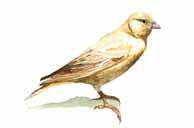

Conservation status : Not evaluated. This bird is common in the mountain scrublands from Arica to Talca. Males and females have a yellow abdomen, which is the source of the name for this species (auri means golden and ventris means abdomen). It is not afraid of humans and often makes its nest in rooftops.
f L or A
f r AN ge L , o L ivi LLo de LA Cordi LL er A . Nombre científico : Kageneckia angustifolia.
e stado de conservación : Casi amenazada.
á rbol de hojas esclerófilas endémico de las cordilleras de los Andes y de la Costa, de Chile central. Antiguamente se usaba para hacer carbón, lo que supuso un grave daño a sus poblaciones. Es la única especie arbórea en los faldeos cordilleranos.
L LA re TA
Nombre científico : Laretia acaulis. e stado de conservación : Riesgo menor. Forma cojines compactos que resisten cubiertos de nieve varios meses; el ambiente protegido que queda bajo su estructura crea un microclima que permite el establecimiento de otras plantas en las duras condiciones de los Andes.
Coruro.
Nombre científico : Spalacopus cyanus. e stado de conservación : En peligro. Roedor endémico de Chile central, se encuentra desde el nivel del mar hasta 3.500 metros de altura. Cava extensos sistemas de túneles donde vive en colonias y se alimenta de tallos o tubérculos.
Pi CA f Lor Cordi LL er AN o.
Nombre científico : Oreotrochilus leucopleurus.
e stado de conservación : Riesgo menor. Habita exclusivamente en la Cordillera de los Andes desde los 1.500 metros de altitud. Presenta un dimorfismo sexual característico en el plumaje del cuello, que en el macho es verde metálico y en la hembra es blanco con manchas oscuras.
Chirihue dor A do.
Nombre científico : Sicalis auriventris. e stado de conservación : No evaluado. Ave común en los matorrales cordilleranos de Arica a Talca. Macho y hembra tienen el abdomen de color amarillo, lo que le da el nombre a esta especie (auri es dorado, y ventris es vientre). No teme la presencia humana y suele anidar en los tejados.
fA u NA


Natural Monument (NM) d eclaration d ate: April 8, 1941.
Location: Region IX of the Araucanía, Malleco Province, Purén County.
surface area: 82 hectares.
Name origin: Contulmo – from the mapudungún , language of the native Mapuche people: means “place of passage”.
Motive for conservation: This NM protects part of the Nahuelbuta Mountain Range (Cordillera de Nahuelbuta), an internationally recognized priority conservation spot due to the number of endemic species with very limited ranges, in some cases limited to this one location only. Even so, only 1.8 % of the surface area is protected.
g eographic and climatic characteristics: This is a temperate climate with a dry summer and a short drought period. The low altitude receives the influences of maritime weather, including humid western winds. For this reason the NM has more rainfall in comparison to other parts of the Nahuelbuta range, and it does not have a marked dry season. The annual rainfall varies from 1,900 mm to more than 3,000 mm, resulting in an average of 1,896.1 mm. The average annual temperature is 12.6 °C, and the average annual relative humidity is 82 %.
fecha de creación como Monumento
Natural (MN): 8 de abril de 1941.
u bicación : IX Región de la Araucanía, provincia de Malleco, comuna de Purén.
superficie: 82 hectáreas.
o rigen del nombre: Contulmo en mapudungún significa “lugar de paso”.
Motivo de conservación : Protege parte de la Cordillera de Nahuelbuta, la que ha sido reconocida internacionalmente como prioritaria para la conservación, debido a la presencia de especies endémicas con rangos muy restringidos, a veces sólo existentes en este lugar. Sin embargo, sólo el 1,8 % de su superficie está protegido.
Características geográficas y climáticas: Clima templado de verano seco con una corta estación de sequía. La baja altitud del sector permite la penetración de la influencia marítima y de los vientos húmedos provenientes del oeste. Por tal motivo, el MN presenta la más alta pluviosidad si se lo compara con otros sectores de la Cordillera de Nahuelbuta, y en él desaparece la estación seca. Las precipitaciones varían de 1.900 mm a más de 3.000 mm al año; la temperatura media anual es de 12,6 °C; la precipitación media anual es de 1.896,1 mm, y la humedad relativa media anual es de un 82 %.


 o pilión macho de la familia Gonyleptidae .
o pilión macho de la familia Gonyleptidae .
f lora: This area is a paradise for ferns, with more than 26 species present. One of these is the famous yerba loza or palmita (Gleichenia quadripartita ), often used in flower arrangements for its stylish form, and because it can be used even after it has dried. This NM preserves a unique environment of the temperate rainforests of Southern Chile 1 . There are vines such as the clavel de campo (Mutisia decurrens ), the quilineja (Luzuriaga radicans ) and the voqui pilfuco or coral plant (Berberidopsis corallina ), which give color to the forest with their attractive flowers, as well as flowering trees like the laurel (Laurelia sempevirens ), the aromo de hoja larga ( Azara lanceolata ), the olivillo ( Aextoxicon punctatum ), the roble beech (Nothofagus obliqua ), and the tineo (Weinmannia trichosperma ) 2
The ulmo tree is also found here (Eucryphia cordifolia ). It is a corpulent, round-shaped tree with dense foliage that can grow to 40 meters, with a trunk diameter of 1 to 2 meters. The most characteristic part of this tree is its large, white, perfumed flowers. The species is not endangered, but its range goes only as far north as the Bío-Bío, where its presence is very limited. The tree’s fragrant flowers make it an excellent choice for honey production, and “ulmo honey” is highly valued for its aroma and golden color. The tree bark is used to reddish dye for wool and is used to cure hides. The tree has great ornamental value and is considered to be one of the most beautiful trees in southern Chile 3
f lora: La zona es el paraíso de los helechos, con más de 26 especies presentes. Una de ellas es la famosa yerba loza o palmita (Gleichenia quadripartita ), hoy utilizada para la confección de arreglos florales por su forma estilizada, la que conserva incluso después de seca la ramilla. Este MN es un parque que mantiene un ambiente único de la selva húmeda del sur de Chile 1 . Hay enredaderas como el clavel de campo, la quilineja (Luzuriaga radicans ) y el voqui, que le dan color al bosque con sus atractivas flores, además del laurel, el aromo, el olivillo, el roble y el tineo (Weinmannia trichosperma ) 2 .
También está presente el ulmo (Eucryphia cordifolia ), árbol corpulento, de copa redondeada y follaje denso, que llega a medir hasta 40 metros de altura, y cuyo tronco alcanza un diámetro de dos metros. Lo más característico de esta especie son sus flores blancas y perfumadas de gran tamaño. No es una especie en peligro, pero en su límite norte de distribución, ubicado en la Región del Biobío, es muy escaso. La cantidad de néctar que producen sus flores hace de él un árbol melífero por excelencia, siendo su miel una de las más preciadas por su aroma y color dorado. Su corteza tiñe la lana de color rojizo y se emplea para curtir cueros. Tiene un gran valor ornamental, y es considerado uno de los árboles más bellos del bosque sureño de Chile 3
1 R. Rodríguez, D. Alarcón, J. Espejo: Helechos nativos del centro y sur de Chile. Guía de campo [Native Ferns of Central and Southern Chile. Field Guide]. Ed. Corporación Chilena de la Madera, Concepción, Chile, 2009, p. 96.
2 Carlos M. Baeza, Clodomiro Marticorena, Roberto Rodríguez: Catálogo de la flora vascular del Monumento Natural Contulmo, Chile [Catalogue of vascular flora of the Contulmo Natural Monument, Chile]. Gayana Botánica, 1999, pp. 125-135.
3 N. García, C. Ormazábal: Árboles nativos de Chile [Native Trees of Chile] Enersis S.A., Santiago, Chile, 2008, p. 156.
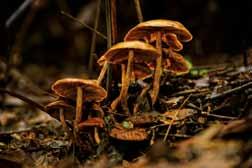
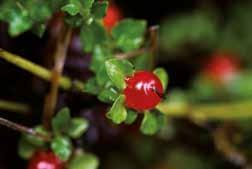

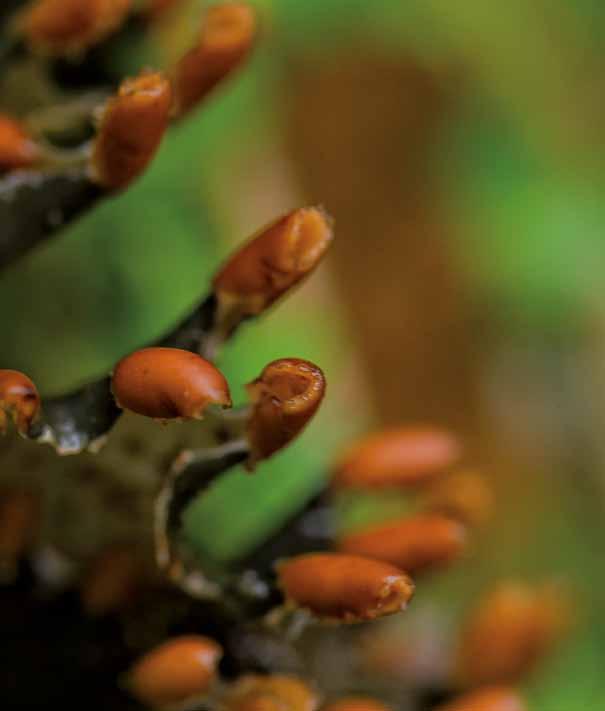
fauna: The most important fauna include the puma (Puma concolor ), pudú (Pudu puda ), red fox (Pseudalopex culpaeus ), güiña (Leopardus guigna ), skunk (Galictis cuja ), South American gray fox (Pseudalopex griseus ) and the very timid, little mountain monkey (Dromiciops gliroides ). Among the birds found here are the Chilean pigeon, the rufous-legged owl, and noisy colonies of slender-billed parakeets (Enicognathus leptorhynchus ). Amphibians include the four-eyed frog, (Pleuroderma thaul ) and the Darwin frog (Rhinoderma darwinii ).
Public usage and community relationship with the NM: The city of Contulmo was originally founded as a fort in 1868 by Cornelio Saavedra. Once built, the fort attracted families who created a city. German colonists were part of this mix and certain traces of their influence can be found in construction styles and lifestyles that exist to this day.
Traveler notes: As indicated by its name, British scientist Charles Darwin discovered the Darwin frog, during his travels to South America aboard the Beagle. This naturalist found it in the Valdivian forests and was struck by the wide variety of colors presented by different individuals within the same species. He wrote how some specimens had “on their body a steel tone that was quite pale,” while others had “a beautiful brilliant green color.” He continued in this manner detailing the colors of the different parts of the frog’s body 4
species in need of conservation: The pudú, the little mountain monkey, the güiña and the slender-billed parakeet are all classified as vulnerable. The puma is nearly threatened and the Darwin frog is in danger of extinction.
relationship with pre- h ispanic cultures: Although the greatest attraction of this NM is its mix of flora and fauna, there is also a connection to ancient indigenous communities. The Contulmo area has been inhabited since as long as can be remembered by the Mapuche people. Their steadfast resistance to Spanish domination inspired the Spanish writer Alonso de Ercilla to write the poem La Araucana , which includes one of the earliest descriptions of the local geography:
The Elicura road grows more narrow along the mountain’s small skirt the cause and the reason for this narrowness is a lake closed off by the valley below 5
fauna: Destacan el puma (Puma concolor ), el pudú (Pudu puda ), el zorro culpeo (Pseudalopex culpaeus ), la güiña (Leopardus guigna ), el quique (Galictis cuja ), el tímido monito del monte (Dromiciops gliroides ) y el zorro chilla (Pseudalopex griseus ). Entre las aves están la torcaza, el concón y las ruidosas bandadas de loros choroy (Enicognathus leptorhynchus ). En anfibios, el sapito cuatro ojos (Pleuroderma thaul ) y la ranita de Darwin (Rhinoderma darwinii ).
relación con los habitantes y usos del MN: La ciudad de Contulmo se funda con un fuerte edificado al mando de Cornelio Saavedra el año 1868. A partir de esta acción, comienzan a llegar distintas familias que se establecen allí, creando una ciudad. Entre ellas, la colonia alemana, que daría a la zona ciertos rasgos característicos en términos de construcción y modo de vida, los que se mantienen hasta hoy.
Notas de viajero: La ranita de Darwin, como indica su nombre, fue descubierta por el inglés Charles Darwin en su viaje por Sudamérica a bordo del navío Beagle. Este naturalista la encontró en los bosques valdivianos, y destacó la gran variedad de colores que presentan distintos individuos de la misma especie, detallando cómo algunos ejemplares tienen “por encima del cuerpo una tonalidad de hierro bastante pálido”, mientras que otros llevan “los muslos de un hermoso color verde brillante”, siguiendo de esta manera con especificidad hasta cubrir todas las partes del cuerpo 4 .
e species con problemas de conservación: En estado vulnerable se encuentran el pudú, el monito del monte, la güiña y el loro choroy. El puma se considera casi amenazado. La ranita de Darwin, está en peligro de extinción.
relación con culturas prehispánicas: A pesar de que el gran atractivo de este MN es el conjunto de flora y fauna, hay una conexión con los antiguos pueblos originarios. La zona de Contulmo ha sido habitada desde tiempos inmemoriales por la etnia mapuche. Su tenaz resistencia a la dominación española inspiró al cronista español Alonso de Ercilla para escribir el poema La Araucana , que incluye una de las primeras descripciones de su geografía:
Estréchase el camino de Elicura por la pequeña falda de una sierra: la causa y la razón de esta angostura es un lago que el valle abajo cierra 5
4 Thomas Bell: Reptiles. Part 5 of The Zoology of the Voyage of HMS Beagle . Editado y supervisado por Charles Darwin. Smith Elder and Co., Londres, 1843, p. 48.
5 Este verso se refiere al lago Lanalhue, situado aproximadamente a 11 km del monumento natural Contulmo. Alonso de Ercilla y Zúñiga, La Araucana

 r anita de d arwin ( Rhinoderma darwinnii ).
r anita de d arwin ( Rhinoderma darwinnii ).
y er BA Loz A .
s cientific name : Gleichenia quadripartita.
Conservation status : Vulnerable on continental Chile, out of danger on Juan Fernández Island. This fern grows from Concepción to Magallanes, and in the Juan Fernández islands, up to 1,600 meters above sea level.
uLM o.
s cientific name : Eucryphia cordifolia.
Conservation status : Low risk. An impressive tree that flowers profusely in springtime. Its white flowers fill the forest with an incomparable scent that attracts insects and honey bees. “Ulmo honey” is very famous in Chile.
Qui L i N e JA .
s cientific name : Luzuriaga radicans. Notes : An evergreen vine that clings to tree trunks with its roots. The stalks are used for weaving baskets and for making tools.
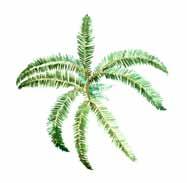

Conservation status : Low risk.
Ti N eo.
s cientific name : Weinmannia trichosperma.
Conservation status : Not evaluated. This tree is endemic to the forests of southern Chile and Argentina. It has several qualities that make it useful to people: its bark has tannins good for curing leather, its flowers are visited by honey bees, and its wood has both decorative and functional value. Elsewhere in the world it is cultivated as an ornamental tree. In its natural ecosystem the fruit, seeds and flowers are eaten by forest animals.
Pudú.
s cientific name : Pudu puda.
Conservation status : Vulnerable.
Notes : This is the smallest deer in the world. Its population has diminished for loss of habitat. It is attacked by dogs, run over by automobiles and hunted.
g üiñ A
s cientific name : Leopardus guigna.

Conservation status : Vulnerable from Region X to the north. Almost threatened towards the south.
Notes : The size of a domestic cat, this wild animal hunts at night in forested areas and is the smallest of America’s felines. It lives in forests or scrublands from the Coquimbo Region to Aysén. It is in risk largely because of the loss of habitat to pine and eucalyptus plantations. And because it is hunted to safeguard poultry operations.
Chi L e AN sK u NK .
s cientific name : Galictis cuja.
Conservation status : Not evaluated. This carnivore hunts all kinds of small vertebrates and birds. It complements its diet with fruit and eggs. Its versatility allows it to live in a wide range of territory, from southern Peru to Magallanes. It is a natural control for European rabbits.
sL e N der Bi LL ed PA r AK ee T.
s cientific name : Enicognathus leptorhynchus.

Conservation status : Endangered north of its range in Region VII, vulnerable between the Bío-Bío River and Chiloé Island, and with Low risk in the Aysén Region. It lives in humid forests in colonies including various dozens of individuals. It eats seeds and native forest fruits, and also forages on the ground.
Li TTL e Mou NTA i N Mo NK ey.
s cientific name : Dromiciops gliroides.
Conservation status : Almost threatened. This is a small marsupial that moves around in treetops during the night. It nests in bamboo and has a mutually beneficial relationship with the quintral plant.
y er BA Loz A , PALM i TA .
Nombre científico : Gleichenia quadripartita.
e stado de conservación : Vulnerable en Chile continental, fuera de peligro en Juan Fernández.
Helecho que crece de Concepción a Magallanes y en el archipiélago de Juan Fernández hasta los 1.600 metros sobre el nivel del mar.
uLM o.
Nombre científico : Eucryphia cordifolia. e stado de conservación : Riesgo menor. Imponente árbol que en primavera florece profusamente con flores blancas; estas llenan el bosque de un olor inconfudible, con el que atrae gran a cantidad de insectos, entre ellos la abeja melífera, que produce la famosa “miel de ulmo”.
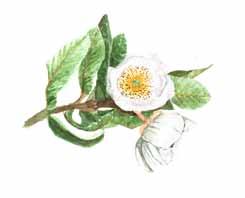
Qui L i N e JA
Nombre científico : Luzuriaga radicans. Notas : Trepadora siempreverde que se adhiere a los troncos por medio de raíces; los tallos se usan para hacer canastos y herramientas.

Estado de conservación: Riesgo menor.
Ti N eo.
Nombre científico : Weinmannia trichosperma.
e stado de conservación : No evaluada.
á rbol endémico de los bosques del sur de Chile y Argentina, tiene varias cualidades que lo hacen útil para el hombre: la corteza produce taninos para la curtiembre, las flores son visitadas por abejas melíferas, y la madera tiene valor tanto decorativo como funcional. Es cultivado en el resto del mundo como árbol ornamental. En su ecosistema natural, sus frutos, semillas y flores son consumidas por la fauna del bosque.
Pudú.
Nombre científico : Pudu puda. e stado de conservación : Vulnerable. Notas : Es el ciervo más pequeño del mundo. Su población ha disminuido por pérdida de hábitat, ataque de jaurías de perros, atropellos y caza.
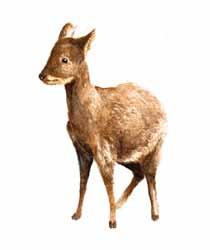
gü iñ A , huiñ A .
Nombre científico : Leopardus guigna. e stado de conservación : Vulnerable de la X Región al norte, y casi amenazado hacia el sur.
Notas : Cazador nocturno de hábitos arbóreos, del tamaño de un gato doméstico: es el más pequeño de los felinos americanos. Habita en bosques o en matorrales desde la región de Coquimbo a la de Aysén. En riesgo debido, principalmente, a la conversión de su hábitat a plantaciones de pino o cultivos, y a la persecución por parte de criadores de aves.
Qui Que.
Nombre científico : Galictis cuja. e stado de conservación : No evaluado. Es un carnívoro generalista que caza todo tipo de vertebrados pequeños, incluyendo aves de corral. Complementa esta dieta con frutas y huevos. Su versatilidad le permite ocupar un amplio rango territorial desde el sur de Perú a Magallanes. Es un controlador natural de la liebre europea.

Loro C horoy.
Nombre científico : Enicognathus leptorhynchus.
e stado de conservación : En peligro hacia el norte de su rango en la VII Región, vulnerable entre el Bío-Bío y Chiloé, y con riesgo menor en la región de Aysén. Vive en bandadas de varias docenas de individuos en bosques húmedos, y se alimenta de semillas y frutos de árboles nativos, forrajeando también en el suelo.
Mo N i To de L M o NT e
Nombre científico : Dromiciops gliroides. e stado de conservación : Casi amenazado.
Pequeño marsupial de hábitos nocturnos y arbóreos, hace nidos en las quilas. Tiene una relación mutualista con el quintral.

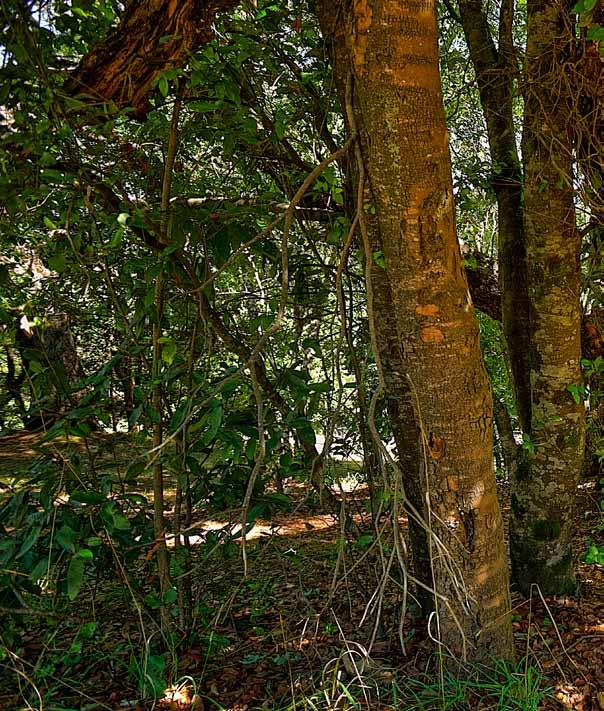
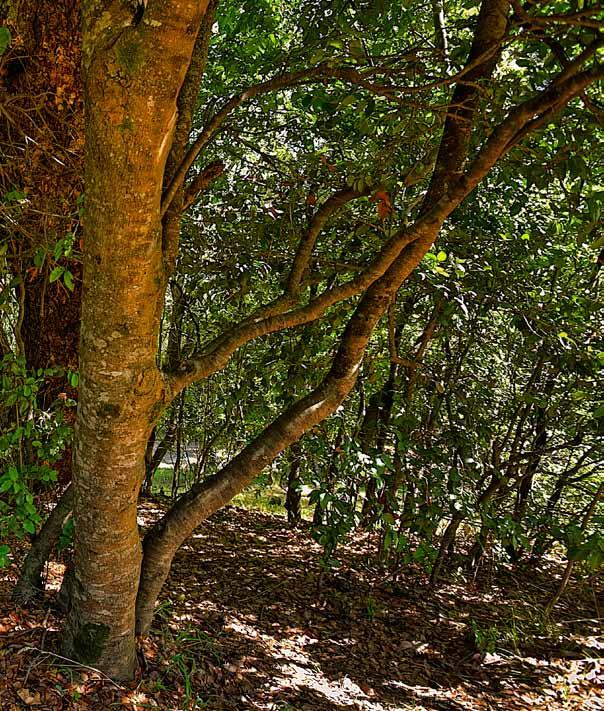

Natural Monument (NM) d eclaration d ate: March 1939.
Location: Region IX of the Araucanía, Cautín Province, Temuco County.

surface area: 89 hectares.
Name origin: From mapudungún , the language of the native Mapuche people: ñielol means “a hill with holes”.
Motive for conservation: It is ecologically relevant as a confluence point of different forest communities, some within the mesomorphic zone of Chile’s Central Valley, and others within a hygromorphic zone. As such, the convergence of these forests serves as a kind of green lung for the city of Temuco. It also has important cultural value worth preserving, as it marks the place where the Araucanía finally became a part of the Chilean state.
g eographic and climatic characteristics: It has a temperate climate with a dry period that lasts about two months. This NM is part of the ñielol volcanic range, a volcanic formation that emerges along the intermediate depression of Region IX 1 .
fecha de reación como Monumento Natural (MN): 20 de marzo de 1939.
u bicación: IX Región de la Araucanía, provincia de Cautín, comuna de Temuco.
superficie: 89 hectáreas.
o rigen del nombre: En mapudungún significa “cerro agujereado”.
Motivo de conservación: Ecológicamente es relevante, pues es el punto en que confluyen comunidades boscosas propias de la zona mesomórfica del Valle Central y otras propias de la zona higromórfica, las cuales sirven en este caso como un pulmón verde para la ciudad de Temuco. También tiene un valor cultural, ya que es el lugar donde se firmó la incorporación definitiva de la Araucanía al Estado chileno.
Características geográficas y climáticas: Tiene un clima templado con un periodo seco de aproximadamente dos meses. Una particularidad del MN es que forma parte del cordón ñielol, que corresponde a una formación volcánica intrusiva, que prácticamente irrumpe en la depresión intermedia de la IX Región 1 .
1 www.conaf.cl Reviewed May 24, 2012.
1 www.conaf.cl Revisado 24-05-2012.

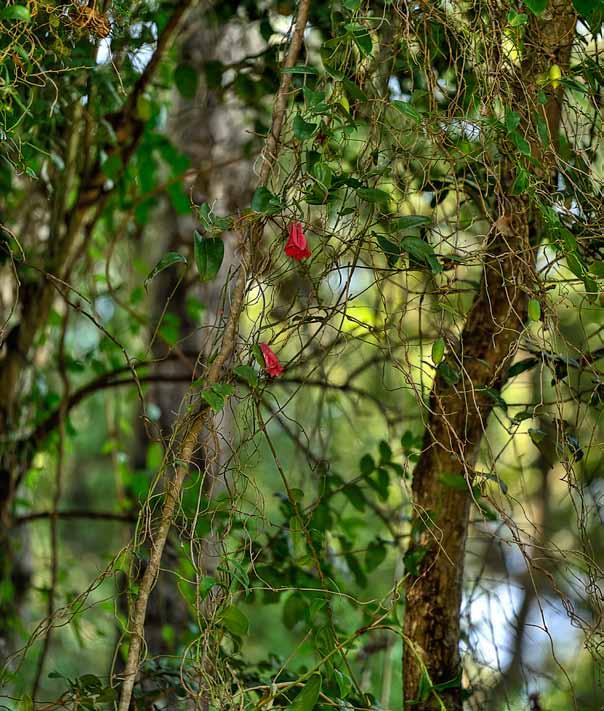
f lora: Along the trails of the NM one can observe the many species of the deciduous forests belonging to this area, which are protected here. Some examples include the huillipatagua (Citronella mucronata ), the lleuque (Prumnopitys andina ) and the peumo (Cryptocaria alba ). All of these trees, in one way or another, have a significance in the Mapuche culture.
fauna: Species found here are the South American gray fox (Pseudalopex griseus ), Chilean pigeon, ave peuquito, red-tailed hawk (Buteo ventralis ), ave concón (Strix rufipes ), brown-striped lizard, the llorón lizard, the short tailed snake, the Darwin frog (Rhinoderma darwinii ) and the four-eyed toad (Pleuroderma thaul ).
Public usage and community relationship with the NM: There are various hiking trails within the Monument: Agua Santa, Los Copihues, Los Lotos, and lastly, the Huepil trail. This last one is of special interest, since it was built for disabled tourists to enjoy. Special metal plaques have been installed in braille and there are colored panels with the same text in Spanish as well as photographs of the NM 2 .
species in need of conservation: The Darwin frog is in danger of extinction. The lleuque, naranjillo and ave concón have not been sufficiently studied – the first two are considered rare and the last is insufficiently known.

f lora: A lo largo de estos senderos se puede observar especies que crecen en los bosques caducifolios propios de esta zona y que se conservan en el MN. Algunos ejemplos son la huillipatagua (Citronella mucronata ), el lleuque (Prumnopitys andina ) y el peumo (Cryptocaria alba ), todos árboles insertos, de distinta manera, en la cultura mapuche.
fauna: Se encuentran la chilla (Pseudalopex griseus ), torcazas, el ave peuquito, el aguilucho de cola rojiza, el ave concón (Strix rufipes ), la lagartija café de rayas, el lagarto llorón, la culebra de cola corta, la ranita de Darwin (Rhinoderma darwinii ) y el sapito de cuatro ojos (Pleuroderma thaul ).
relación con los habitantes y usos del MN: Dentro del cerro hay varios senderos para recorrer: Agua Santa, Los Copihues, Los Lotos y, finalmente, el sendero Huepil. Este último es de especial interés, ya que está concebido para discapacitados. Cuenta con un sistema de placas metálicas con escritura en braille y paneles en color con el mismo texto en español, junto a fotografías atingentes al lugar2
e species con problemas de conservación : La ranita de Darwin se considera en peligro de extinción. El lleuque, el naranjillo y el concón no han sido suficientemente estudiados, considerándose como especies raras las dos primeras y como insuficientemente conocida la última.
relationship with pre- h ispanic cultures: This NM represents an emblematic landmark in our history, since a huillipatagua tree (Citronella mucronata ) signals where, in 1881, a parliamentary gathering brought to an end a long war between the Mapuche people and the Chilean Republic, resulting in the Mapuche leaders ceding their lands of Temuco to the State. (Experts say the event was held where today the State Railroad Company has its machine room.) As a symbol of this event, there is a ceremonial center that showcases the Patagua Armistice, along with five chemamulles (wooden sculptures of people) installed at the ceremonial center. In Mapuche culture, a chemamull is used to guard the tomb where the soul of a deceased loved one remains wandering among the living, before reuniting with his or her ancestors.
The fact that chemamulles were installed to mark the parliamentary event dates back to events previous to the peace agreement. In that same year of 1881, the ñielol Fort massacre occurred. The Arauco governor, Basilio Urrutia, retold that “thousands of Mapuche died there, in the fort near Lautaro”3 . It was one of the last confrontations, and brought to a close a cycle of battles in a war that was later conceptualized as the “Pacification of the Araucanía.” Of course, this concept is much debated, since it represents solely the Republic’s historical point of view, not that of the Mapuche people.

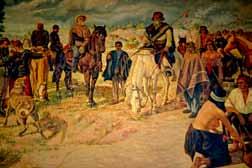
relación con culturas prehispánicas: Este MN representa un hito emblemático de nuestra historia, ya que allí existe un árbol de huillipatagua (Citronella mucronata ) que recuerda la realización, en 1881, de un parlamento (que, según algunos expertos, se efectuó en el lugar donde actualmente se localiza la sala de máquinas de Ferrocarriles del Estado), acontecimiento que puso fin a un largo periodo de guerra, y que determinó la entrega de las tierras de Temuco al Estado chileno. Como símbolo de esto encontramos la Patagua del Armisticio, con cinco chemamulles (gente de madera) instalados en un centro ceremonial. El chemamull, en la cultura mapuche, se utiliza como guardián de las tumbas donde se queda el alma de un ser querido mientras deambula entre los vivos, antes de reunirse con sus antepasados.
El hecho de que sean chemamulles los que marcan el hito del parlamento remite a los eventos previos al acuerdo de paz. Ese mismo año 1881, el 3 de noviembre, se produjo la masacre del Fuerte ñ ielol. El intendente de Arauco, Basilio Urrutia, cuenta que “allí murieron millares de mapuches, ahí en el fortín cercano a Lautaro”3 . Fue uno de los últimos enfrentamientos, y cerró un ciclo de batallas en pro de lo que luego se llamaría “la Pacificación de la Araucanía”, concepto que es debatido, pues representa solo la visión republicana –y no mapuche– de la historia.
f L or A
Peu M o.
s cientific name : Cryptocaria alba.

Conservation status : Low risk.
A tree characteristic of the sclerophyllous (desert shrub) forests of central Chile. It produces a red, meaty fruit appreciated by birds.

Chi L e AN PLu M y e W.
s cientific name : Prumnopitys andina.
Conservation status : Rare. Note : This is an odd tree within the conifer genus since it forms false fruit that is consumed by birds, which then disperse the seeds. The fruit is also used to make marmalade.
N A r ANJ i LLo.
s cientific name : Citronella mucronata.
Conservation status : Rare.
This tree is endemic, distributed widely in terms of latitude, but made up of small, isolated communities. On the backside of its leaf are small cavities where parasites and insects can be found.
r ufous- L egged oWL .
s cientific name : Strix rufipes.
Conservation status : Insufficiently known.
A native owl, feeds on rodents only at night. Nests in hollow trunks.

four-eyed f rog.
s cientific name : Pleurodema thaul.
Conservation status : Almost threatened. Unlike other amphibians, the adult frogs live on dry land within the forest. At the topside of its back there are a pair of pigmented protrusions that look like “eyes.” This, of course, confuses predators looking for the animal’s real head. Also found in : Contulmo.
dA rW i N ’s f rog.
s cientific name : Rhinoderma darwinii. Conservation status : Endangered. Endemic to the temperate forests of Chile and Argentina, it has been displaced by eucalyptus and pine forest plantations, which has put them at risk. When the male frog sees that the eggs are developing, he guards them in his mouth, where the metamorphosis takes place. Also found in : Contulmo.
Peu M o.
Nombre científico : Cryptocaria alba. e stado de conservación : Riesgo menor. á rbol característico del bosque esclerófilo del centro de Chile. Produce frutos rojos y carnosos que sirven de alimento a aves.


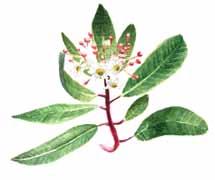
L L eu Que, uvA de Cordi LL er A . Nombre científico : Prumnopitys andina. e stado de conservación : Rara. Notas : Es una extrañeza dentro de las coníferas, ya que forma falsos frutos que son consumidos por aves que así dispersan sus semillas; también son usados para hacer mermelada.
N A r ANJ i LLo, hui LL i PATAguA . Nombre científico : Citronella mucronata. e stado de conservación : Rara. Es un árbol endémico, con una distribución latitudinalmente extensa pero compuesta de pequeñas comunidades aisladas. En el envés de la hoja tiene unas pequeñas cavidades donde aloja ácaros e insectos.
Nombre científico : Strix rufipes. stado de conservación : Insuficientemente conocida. Lechuza nativa, caza roedores exclusivamente de noche. Anida en huecos de troncos.
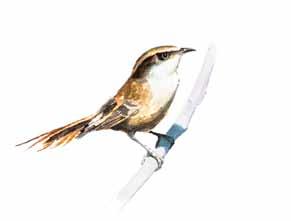
ro oJ os.
Nombre científico : Pleurodema thaul. stado de conservación : Casi
A diferencia de otros anfibios, los adultos viven en terreno seco, dentro del bosque. En el extremo del lomo tienen un par de protuberancias pigmentadas como “ojos”, lo que confunde a sus eventuales depredadores acerca de cuál es la verdadera cabeza del animal. También en : Contulmo.
rAN i TA de dA rW i N .
Nombre científico : Rhinoderma darwinii. e stado de conservación : En peligro. Endémico de los bosques templados de Chile y Argentina, fue desplazada de su hábitat por plantaciones de eucaliptus y pinos, lo que la ha puesto en riesgo. Cuando el macho ve que los huevos están desarrollándose, los guarda en su boca y los renacuajos pasan toda su metamorfosis en la boca del padre. También en : Contulmo.

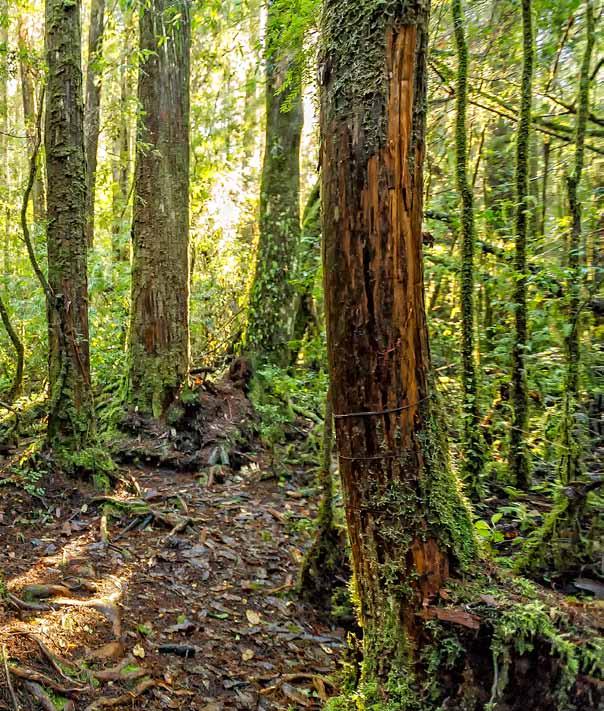
h elecho película ( hymenophyllum pectinatum ).

Natural Monument (NM) d eclaration d ate: January 10, 2000.
Location: Region X of The Lakes, Llanquihue Province, Puerto Montt County.
surface area: 200 hectares 1

Motive for conservation: It is a small relic of an old-growth forest, representative of the temperate rainforests that covered the entirety of the intermediate depression of Chile prior to the European colonization period, particularly the German colonization that took place during the 19th century. The forest contains alerce trees that are over 1,800 years old. Old-growth alerce trees are nearly extinct, but continue to exist in protected areas like this.
1 www.conaf.cl Reviewed July 3, 2012.
fecha de creación como Monumento Natural (MN): 10 de enero del año 2000.
u bicación : X Región de los Lagos, provincia de Llanquihue, comuna de Puerto Montt.
superficie: 200 hectáreas 1
Motivo de conservación: Es un pequeño bosque relicto, representativo de los bosques húmedos templados de la zona sur de Chile que cubrían la depresión intermedia de la región antes de la colonización europea, particularmente alemana, durante el siglo XIX. Destacan los alerces, algunos con hasta 1.800 años de edad. Esta especie casi se extinguió, y hoy sólo sobrevive gracias a áreas protegidas como ésta.
1 www.conaf.cl Revisado 3-7-2012


Name origin: The name derives from the indigenous Mapudungún language, spoken by the Huilliche people who used to inhabit the area. Lahuén means “medicinal water”, and ñadi means “swampland”2 . Both terms connect in this location, since the NM is in a very humid area where both medicinal water and plants used by the huilliches were likely to be found.
g eographic and climatic characteristics: A temperate rainforest climate influenced by its proximity to the sea, with temperatures averaging between 9 °C y 12 °C, and where annual average rainfall is above 1,800 mm. The NM is located on swampy volcanic soil, similar to most of the central valley areas found from Valdivia to the Chacao Channel. It is rich in organic material and has a hardened cap of iron oxides.
o rigen del nombre: Proviene del mapudungún, lengua utilizada por los huilliches que habitaban la zona. Lahuén significa “agua medicinal”, mientras que ñadi es “tierra pantanosa”2 . Ambos significados se conectan con el lugar, ya que el MN conforma un bosque en una zona muy húmeda, donde probablemente se encuentran plantas y aguas medicinales que fueron utilizadas por ese grupo étnico.
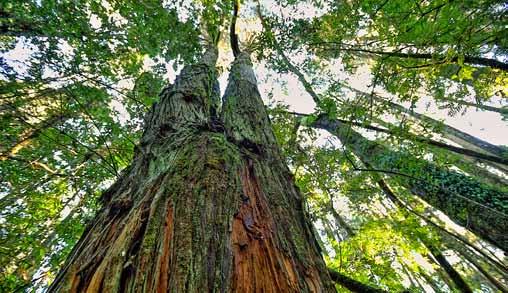
Características geográficas y climáticas: Corresponde a templado lluvioso, con influencia mediterránea, donde las temperaturas rondan los 9 °C y 12 °C, y las precipitaciones tienen promedios anuales superiores a los 1.800 mm.
El MN está situado en suelo volcánico pantanoso y de tierra muy húmeda, propia del área del Valle Central, de Valdivia al Canal de Chacao, rica en materia orgánica y con una capa endurecida de óxidos de fierro.
2 María Catrileo: Diccionario lingüístico-etnológico de la lengua mapuche. Mapudungún-Español-English [Linguistic and ethnologic Dictionary of the Mapuche language. MapudungúnEspañol-English]. Editorial Andrés Bello, Santiago, Chile, 1995.
2 María Catrileo: Diccionario lingüístico-etnológico de la lengua mapuche. Mapudungún-Español-English. Editorial Andrés Bello, Santiago, Chile, 1995.
 Musgo paragüita ( Hypopterygium arbuscula ).
Musgo paragüita ( Hypopterygium arbuscula ).

f lora: Is most characterized by its woodlands, where the principal species is the alerce (Fitzroya cupressoides ), together with arrayán (Luma apiculata ) and luma trees. There are also other tree species like the tepú (Tepuaria stipularis ), the coigüe and the canelo (Drimys winteri ) 3 . Plants such as the helecho película or the musgo paragüita thrive in the forest’s shady and wet soil 4 . In the alerce canopy there is a community of epiphytes and associated animals that create a true aerial forest.
fauna: Because of the small size of this NM, and taking into account the neighboring lands used for agricultural purposes, as well as the highway traffic to and from Puerto Montt, the forest isn’t able to serve as a permanent habitat for many species. As a result, the “fragmentized habitat” phenomenon takes place. Therefore, it is of great importance to maintain, protect and conserve the vegetative aspect of the area. Even so, there are great numbers of bird species that can be observed here, including the chucao (Scelorchilus rubecula ), the huet-huet (Pteroptochos tarnii ), the rayadito ( Aphrastura spinicauda ), the choroy (Enicognathus leptorhynchus ), the bandurria (Theristicus melanopis ), the tiuque and the traro. The Darwin frog (Rhinoderma darwinii ) also lives here, as does a species of skunk (Conepatus chinga ).
Public usage and community relationship with the NM: There is a trail in the NM that allows you to see different species, but most especially the alerce. The NM is easily accessible, as it is located on flat swampy land, and the walk lasts 20 to 30 minutes.
species in need of conservation: The Darwin frog is in danger of extinction, while the alerce tree is vulnerable.
f lora: Es de característica arbórea, donde la especie principal es el alerce (Fitzroya cupressoides ), acompañado del arrayán (Luma apiculata ) y la luma, principalmente. Existen otros árboles como el tepú (Tepuaria stipularis ), el coigüe y el canelo (Drimys winteri ) 3 . También se encuentran plantas como el helecho película o el musgo paragüita, que necesitan la sombra y la humedad constantes del bosque 4 . En el dosel de alerces se desarrolla una comunidad de epífitas y animales asociados que forman un verdadero bosque aéreo.
fauna: Dado el reducido tamaño del MN, tomando en cuenta que los sectores aledaños han sido habilitados para la agricultura, la cercanía a centro urbanos como Puerto Montt, y a carreteras de alto tráfico, no se espera que el bosque en sí pueda servir de hábitat permanente a muchas especies, produciéndose el fenómeno conocido como fragmentación del hábitat. En este sentido, es primordial poder conservar el lado vegetacional del espacio, ya que forma parte esencial de la zona. No obstante, hay numerosas aves que se pueden observar en este bosque, como el chucao (Scelorchilus rubecula ), el huet-huet (Pteroptochos tarnii ), el rayadito ( Aphrastura spinicauda ), el choroy (Enicognathus leptorhynchus ), la bandurria (Theristicus melanopis ), el tiuque y el traro. También habitan la ranita de Darwin (Rhinoderma darwinii ) y el chingue (Conepatus chinga ). relación con los habitantes y usos del MN: Dentro de los límites del MN hay un sendero que permite observar las distintas especies inmersas, especialmente el alerce. Es de fácil acceso por estar situado en terrenos planos y húmedos, y el recorrido puede durar 20 ó 30 minutos.
e species con problemas de conservación: La ranita de Darwin está en peligro de extinción, mientras que el alerce es vulnerable.
3 www.conaf.cl Revisado 3-7-2012.
4 www.conaf.cl Revisado 3-7-2012.
A L erC e.
s cientific name : Fitzroya cupressoides.

Conservation status : Vulnerable. Named in honor of Robert Fitz-Roy, captain of the HMS Beagle, the boat used by Darwin for his scientific investigations as he traveled throughout South America. It is monotypic and endemic to Southern Chile. Its current habitat is only 15 percent of what it was before the 16th century. It grows well in poor, abandoned, acidic soils, but very slowly, reaching sexual maturity after 30 years. This partly explains its vulnerability. It is the largest tree in Chile’s forests, growing as much as 60 meters high with a diameter of 5 meters, although there are descriptions by earlier naturalists of trees even bigger – most likely logged years ago.
Chi L e AN Myr TL e.
s cientific name : Luma apiculata

Conservation status : Low risk.
A tree recognized by the unmistakable cinnamon color of its trunk and its white flowers which, during spring, are an important source of pollen and nectar for native bees and honey producers. While the tree is valued for its ornamental appearance, its wood is prized for its hardness and resistance. Its fruit may be eaten.
B LACK-T hroAT ed h ue T-hue T.
s cientific name : Pteroptochos tarnii. Conservation status : Low risk. This bird has very large feet adapted to life on the ground. It is a good walker that tends to raise its tail, with colors that help it blend in with its forest environment to protect it from predators. The birds live in couples and are much more likely to be heard than seen, thanks to the characteristic “huet-huet” sung to call its mate.
Chu CAo.
s cientific name : Scelorchilus rubecula. Conservation status : Low risk.

Very common in the forests of southern Chile. It is a curious bird that follows people walking in the forest, but always at a prudent distance. It can be approached with patience. It lives mostly on the ground near streams.
Buff- N eCK ed iB is.
s cientific name : Theristicus melanopis. Conservation status : Low risk. This bird tends to travel in groups, looking for animals to eat. It is very common from Antofagasta to the south.
Thor N -TA i L ed rAyA di To.
s cientific name : Aphrastura spinicauda. Conservation status : Low risk. This is a small, omnivorous bird found in densely forested areas from Rancagua to the south. Also found in : Cerro ñ ielol.
A L erC e.
Nombre científico : Fitzroya cupressoides. e stado de conservación : Vulnerable. Nombrado en honor a Robert FitzRoy, capitán del HMS Beagle, buque de investigación científica en el que Darwin viajó por Sudamérica. Es monotípico y endémico del sur de Chile. Su hábitat actual es solo el 15 por ciento de lo que era antes del siglo XVI. Se desarrolla muy bien en suelos anegados y ácidos, e incluso delgados y pobres. Crece de modo extremadamente lento y alcanza la madurez reproductiva cerca de los 30 años, lo que explica en parte su vulnerabilidad. Es el árbol más grande de los bosques de Chile, alcanzando una altura de hasta 60 m y un diámetro de 5m, aunque hay descripciones de naturalistas que indican valores mucho mayores, probablemente de individuos longevos que fueron talados.
Arr Ayá N .
Nombre científico : Luma apiculata e stado de conservación : Riesgo menor. á rbol reconocible por el inconfundible color canela de su tronco y sus flores blancas, que durante la primavera son una fuente importante de polen y néctar para los polinizadores nativos y para los productores de miel. Es apreciado por su madera dura y resistente, sus frutos comestibles y su valor ornamental.

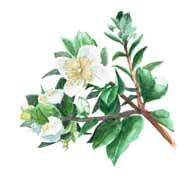
Nombre científico : Pteroptochos tarnii. stado de conservación : Riesgo menor. Tiene patas bastante largas y adaptadas a la vida en el suelo. Es buen caminador, suele erguir la cola, y su coloración mimética lo protege de sus depredadores. Vive en pareja y resulta mucho más oído que visto gracias al característico “huethuet” con que llama a su pareja.
Chu CAo.
Nombre científico : Scelorchilus rubecula. e stado de conservación : Riesgo menor. Muy común en los bosques del sur de Chile. Es un ave curiosa que sigue al caminante,siempre a una distancia prudente, aunque es fácil hacerlo entrar en confianza. Habita principalmente en el suelo, cerca de arroyos.
B AN durri A
Nombre científico : Theristicus melanopis. e stado de conservación : Riesgo menor. Esta ave suele volar en bandadas en busca de animales para alimentarse. Es bastante común de Antofagasta al sur. rAyA di To.


Nombre científico : Aphrastura spinicauda. e stado de conservación : Riesgo menor. Pequeña ave omnívora presente en zonas de bosque denso desde Rancagua al sur. También en : Cerro ñ ielol.
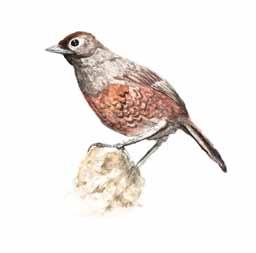
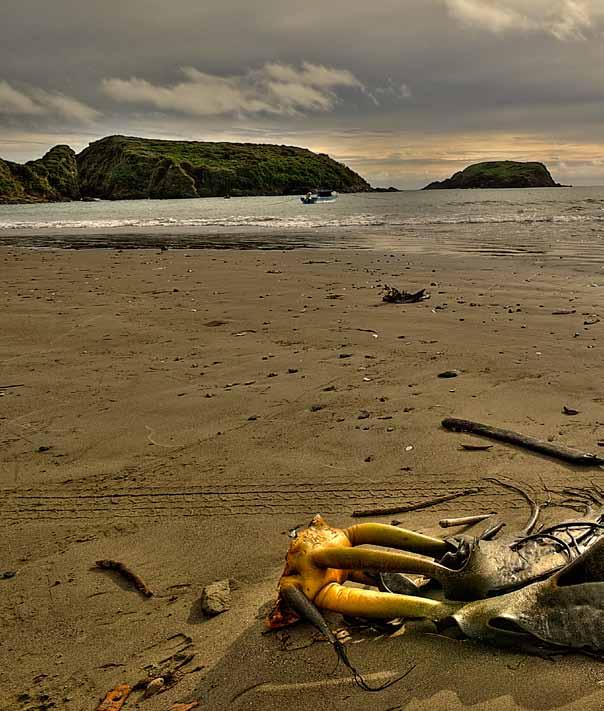
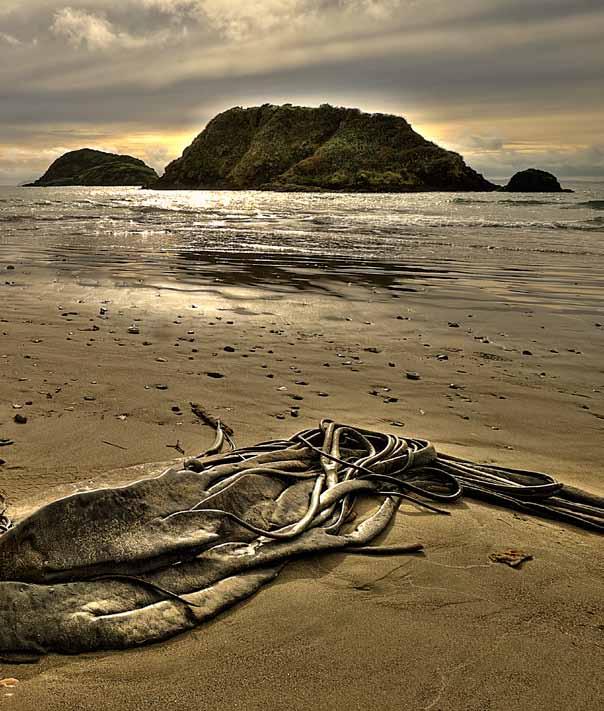

Natural Monument (NM) d eclaration d ate: September 28, 1999.
Location: Region X of The Lakes. Chiloé Province, Ancud County.
surface area: 8.64 hectares.
Name origin: Puñihuil is a composite word from the indigenous Mapudungún language, and has two possible meanings. One is “strong wind”, referring to the strong winds and waves that hit the islets 1 ; the other possible meaning is composed of puñ “front” and ihuel “calm”, alluding to the quiet bay waters on tranquil days 2
Motive for conservation: This is a nesting and breeding area for many different seabirds, but most especially the Humboldt and Magellanic penguins. Both species arrive to these small islands during the summer months to nest and reproduce, sharing the same space for this activity.
fecha de creación como Monumento Natural (MN): 28 de septiembre de 1999.
u bicación : X Región de los Lagos, provincia de Chiloé, comuna de Ancud.

superficie: 8,64 hectáreas.
o rigen del nombre: De la palabra puñihuil , en mapudungún; encontramos dos versiones acerca de su significado: por un lado, “viento fuerte”1 , lo que se explica por la exposición que tienen los islotes a las ventiscas marinas; y por otro es la designación compuesta por puñ , frente, e ihuel , estar en calma. Este es un topónimo que describe exactamente la quietud de las aguas de la bahía en días tranquilos 2
2 Ibid.
2 Ibid.

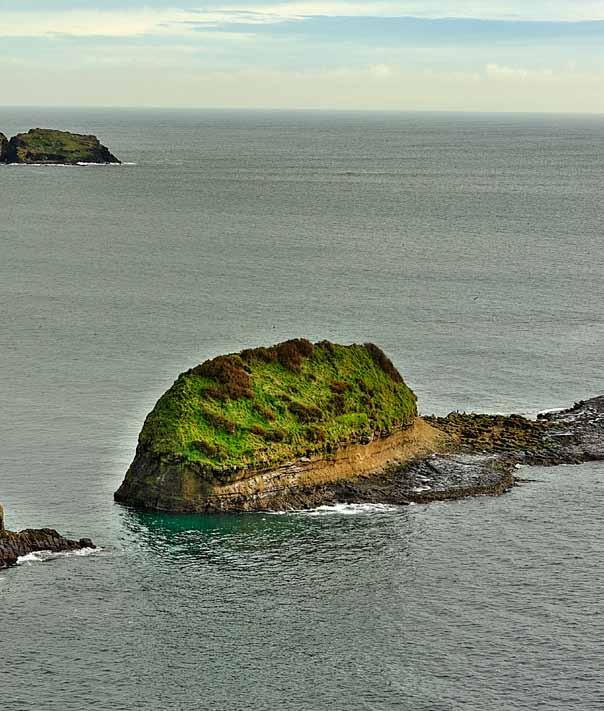


g eographic and climatic characteristics: It is composed of three very small islands (islets) located on the northeast coast of the Chiloé Island, just in front of the local fishing cove of Puñihuil. It is a humid, temperate ocean climate. Rainfall is heaviest in the winter and there is no dry season. It can be described as a cold, temperate, rainy climate from April to October, and instable between November and March. The average annual rainfall is 2,750 mm, but can be as much as 3,500 mm 3
f lora: Vegetation is composed mostly of shrubs – especially of chupalla or chupón. Also seen in the Puñihuil area are remnants of Chiloé’s coastal forests, where the dominant species include the coastal olivillo, the tepú (Tepuaria stipularis ) and the ulmo (Eucryphia cordifolia ) 4 .
fauna: Ten of the 18 penguin species that exist in the world are found in Chile. And two of these live in this NM. It is one of the few places in the world that serve as a rookery for two different penguin colonies: the Humboldt (Spheniscus humboldti ) penguin and the Magallanes (Spheniscus magellanicus ) penguin. The fact that they nest together make these islets a unique place 5 .
Other bird species on the islands include the caranca (Chloephaga hybrida ) and the flightless steamer duck (Tachyeres pteneres ). Surrounding birdlife on the mainland includes the pilpilén austral (Haematopus palliatus ), cormorants and fardelas.
The islands are also home to mammals like the chungungo, or marine otter, which is the smallest in the world within the lontra genus 6 .
species in need of conservation: Both penguin species are considered vulnerable, as is the ecological niche that provides their habitat. Goats roamed and destroyed the vegetation on the largest islet closest to the fishing cove, before the smaller islets were declared a Natural Monument. This, together with trash and pressure brought in by tour operators and tourists, has resulted in a population loss in both penguin species 7. These factors indicate an urgent need to better protect and safeguard this habitat.
Motivo de conservación : Es lugar de nidación y apareamiento de aves marinas, particularmente importante para los pingüinos de Humboldt y magallánico, que durante el verano llegan a los islotes a reproducirse y anidar, compartiendo la misma colonia reproductiva.
Características geográficas y climáticas: Se encuentra en la costa noreste de la Isla Grande de Chiloé, frente a la caleta de pescadores de Puñihuil, y está conformado por tres islotes aledaños. El clima tiende a oceánico húmedo y templado. El régimen de lluvias tiene características mediterráneas, con mucha lluvia en el invierno pero sin temporada seca. Se define como templado frío, lluvioso de abril a octubre, e inestable de noviembre a marzo. Como promedio, tiene una precipitación anual de 2.750 mm, alcanzando un máximo de 3.500 mm anuales 3
f lora: Se compone principalmente de especies arbustivas, destacándose la chupalla o chupón, además de otras herbáceas. En el sector de Puñihuil se observan relictos del bosque costero chilote, cuya especie dominante es el olivillo costero, acompañado del tepú (Tepuaria stipularis ) y el ulmo (Eucryphia cordifolia ) 4
fauna: De las 18 especies de pingüino que existen en el mundo, diez están presentes en Chile, y dos de ellas en este MN. Es uno de los pocos lugares del planeta que albergan la nidificación simultánea de colonias de pingüino de Humboldt (Spheniscus humboldti ) y de pingüino de Magallanes (Spheniscus magellanicus ), que al nidificar juntas hacen de este lugar un espacio natural único 5
En los roqueríos de las islas se encuentran la caranca (Chloephaga hybrida ) y el pato quetru no volador (Tachyeres pteneres ). Alternando sus visitas a los islotes con las planicies interiores, puede verse al pilpilén austral (Haematopus palliatus ). Además, se aprecia presencia cormoranes y fardelas.
Entre los mamíferos destaca el chungungo o nutria de mar, que dentro del género lontra es el más pequeño del mundo 6 .
e species con problemas de conservación: Ambas especies de pingüinos se consideran vulnerables, al igual que el nicho ecológico que se da por esta convivencia. Antes de que los islotes fueran declarados MN, en la isla más cercana a la caleta existían cabras que destruían la vegetación propia de los islotes. Esto, más la basura traída por los turistas, ocasionaba pérdidas en ambas especies de pingüinos 7. Lo anterior indica la necesidad urgente de proteger y resguardar este hábitat.
3 www.conaf.cl Reviewed July 3, 2012.
4 www.conaf.cl Reviewed July 3, 2012.
5 www.conaf.cl Reviewed July 3, 2012.
6 www.conaf.cl Reviewed July 3, 2012.
7 http://otros.conaf.cl Act N° 13, Regional Consulting Council Meeting for the Conservation and Development of Protected Wilderness Areas in the Lakes Region.
3 www.conaf.cl Revisado 3-7-2012.
4 www.conaf.cl Revisado 3-7-2012.
5 www.conaf.cl Revisado 3-7-2012.
6 www.conaf.cl Revisado 3-7-2012.
7 http://otros.conaf.cl Acta n° 13, Reunión Consejo Consultivo Regional para Conservación y Desarrollo de las á reas Silvestres Protegidas de la Región de los Lagos.


h u MB o L dT Pe N gui N .
s cientific name : Spheniscus humboldtii.
Conservation status : Vulnerable. Its natural habitat coincides with the Humboldt Current, which means the northern coast of Peru to the southcentral coast of Chile. Along shoreline slopes or in guano (dried and hardened dung) they dig small caves to nest. They eat mostly fish or squid. In recent years their numbers have fallen sharply for a lack of nesting grounds and food, due to man’s depredation and, most of all, because of climatic change phenomena such as El Niño. Their eggs are often eaten by species introduced by man, such as cats, dogs and rats. Fishermen also use their flesh as bait, or occasionally to eat. They are protected by the law in Chile. Also found in : Isla Cachagua.
Ke LP g oose
s cientific name : Chloephaga hybrida
Conservation status : Low risk.
A sea bird with strongly marked sexual dimorphism: the male is completely white with a black beak, while the female is dark gray with white spots and a pink beak. They feed usually in pairs, on algae found along seaside rock formations.
fL igh TL ess sT e AM er- d u CK
s cientific name : Tachyeres pteneres.
Conservation status : Not evaluated. A marine duck that feeds on mollusks, crustaceans, and rockfish exposed during low tide, although they continue for various kilometers towards sea. It cannot fly.


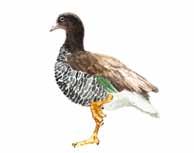
M Age LLAN oys T erCATC her.
s cientific name : Haematopus palliatus.
Conservation status : Low risk. This bird inhabits sandy beach areas, waiting for low tides to feed on oysters and other bivalves (that they open with their beaks) or on other buried invertebrates. They nest in sand dunes beyond the beach area or in wetlands more inland.
Pi N güi N o de h u MB o L dT. Nombre científico : Spheniscus humboldtii. e stado de conservación : Vulnerable. Su hábitat natural coincide con la corriente de Humboldt, es decir, desde la costa norte de Perú al centro-sur de Chile. En laderas o en el huano excava pequeñas cuevas donde anida. Se alimenta principalmente de peces o calamares. En los últimos años sus poblaciones se han reducido drásticamente a consecuencia de la escasez de lugares de nidificación, reducción en la oferta de alimentos, depredación por parte del hombre y, sobre todo, el impacto de fenómenos climáticos severos, como El Niño. Sus huevos suelen servir de alimento a especies introducidas por el hombre, como perros, gatos y ratas; también, los pescadores usan su carne como carnada y ocasionalmente como alimento. Está protegido por la legislación chilena. También en : Isla Cachagua.
C A r ANCA o CAu Qué N MA ri N o. Nombre científico : Chloephaga hybrida. e stado de conservación : Riesgo menor. Ave marina con un marcado dimorfismo sexual: el macho es completamente blanco con el pico negro y la hembra es gris oscuro con manchas blancas y el pico rosado. Se alimenta de algas del intermareal rocoso, generalmente en parejas.
Que T ru N o vo LA dor. Nombre científico : Tachyeres pteneres. e stado de conservación : No evaluado. Pato marino que se alimenta de moluscos, crustáceos y peces de roca que quedan expuestos al bajar la marea, aunque puede adentrarse varias millas mar adentro. No puede volar.
Pi LPi L é N Aus T r AL . Nombre científico : Haematopus palliatus.
e stado de conservación : Riesgo menor. Ave que habita playas arenosas, donde espera la marea más baja para alimentarse de ostras y otros bivalvos que abre con el pico, o de otros invertebrados enterrados. Anida en las dunas detrás de la playa o en campos húmedos al interior.
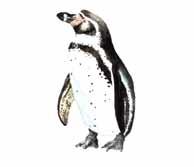


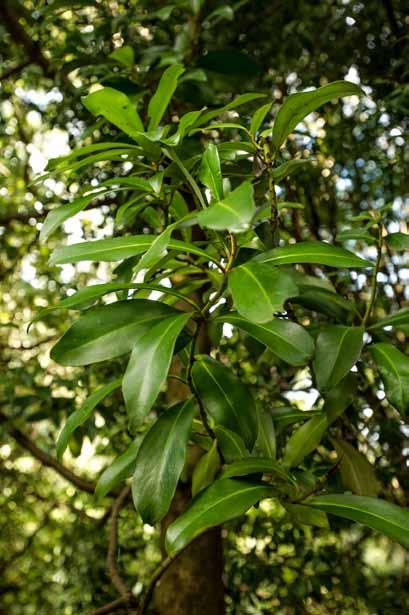
Natural Monument (NM) d eclaration d ate: October 13, 1982.
Location: Region XI of Aysén, Aysén Province, Aysén County.
surface area: 228 hectares 1
Name origin: This NM is made up of five small islands, hence its name “five sisters”.
Motive for conservation: The vegetation here is evergreen Puyuhuapi forest, which gives form to a unique ecosystem, adjacent to the nutrient and mineral rich waters of the Aysén fjord.
g eographic and climatic characteristics: This NM faces the Aysén fjord, about 50 km distant from Puerto Aysén. Because of its proximity to the ocean, it has a temperate maritime climate, very rainy and cold, with average annual precipitation between 3,500 and 4,000 mm.
f lora: Predominantly an evergreen Puyuhuapi forest formation, which includes the canelo (Drimys winteri ), coigüe (Nothofagus nitida ) and tepú (Tepuaria stipularis ) 2 .
fauna: Mammals living here include the chungungo or marine otter (Lontra felina ) and the sea lion (Otaria flavescens ). Bird species include seagulls, the common cormorant (Phalacrocorax olivaceus ) and the imperial cormorant (Phalacrocorax atriceps ).
Public usage and community relationship with the NM: Despite the fact that people now live in the area and the NM has been travelled upon and registered geographically by the armed services and numerous scientists, the NM remains a very isolated place. It can only be reached by the sea, which greatly limits the entrance of humans.
Traveler notes: Charles Darwin described the chungungo in a study included in The Zoology of the Voyage of HMS Beagle , a book written by the British naturalist George R. Waterhouse. Darwin shared with Waterhouse the notes he took during the trip aboard the Beagle. Both relate that the chungungo is an otter, similar in size to the European otter. It has short, brilliant hair, and the hair on its underbelly is especially thick and silky, with its color varying in different tones of brown. It has a long tail that is very thick at its base 3
fecha de creación como Monumento Natural (MN): 13 de octubre de 1982.
u bicación : XI Región de Aysén, provincia de Aysén, comuna de Aysén.
superficie: 228 hectáreas 1
o rigen del nombre: Se debe a que el MN está compuesto por cinco pequeñas islas.
Motivo de conservación: Su formación vegetacional es el bosque siempreverde de Puyuhuapi, que da forma a un ecosistema único en que este bosque coexiste con las ricas aguas del fiordo de Aysén.
Características geográficas y climáticas: El MN se emplaza en el fiordo de Aysén, a 50 kilómetros de Puerto Aysén. Debido a la cercanía del océano, su clima es de tipo marítimo templado, frío lluvioso de costa occidental, con precipitaciones de una medias anuales entre 3.500 y 4.000 mm.
f lora: Formación predominantemente siempreverde de Puyuhuapi, que incluye canelo (Drimys winteri ), coigüe de Chiloé (Nothofagus nitida ) y tepú (Tepuaria stipularis ) 2 .
fauna: Entre los mamíferos están el chungungo (Lontra felina ) y el lobo marino (Otaria flavescens ). Entre las aves están las gaviotas, el cormorán común (Phalacrocorax olivaceus ) y el cormorán imperial (Phalacrocorax atriceps ).
relación con los habitantes y uso del MN: Pese a que ya hay habitantes en la zona y el MN ha sido transitado y registrado geográficamente por las fuerzas armadas y por más de un científico, sigue siendo un espacio aislado. Se accede sólo por vía marítima, por lo cual el flujo de personas es limitado.
Notas de viajero: Charles Darwin describe el chungungo, incorporando dicho estudio en su libro Zoología del viaje de HSM Beagle . Dicho texto fue escrito por George R. Waterhouse, un naturalista inglés a quien Darwin confió el estudio de la información recogida en el viaje del Beagle. Ambos cuentan que el chungungo es una nutria de igual tamaño que la europea, y que su pelo es corto y brillante; el pelo de la zona inferior de su cuerpo es abundante y sedoso, cuyo color varía entre diversos tonos de café; su cola es larga y gorda en la base 3
1 www.conaf.cl Reviewed June 1, 2012.
2 www.conaf.cl Reviewed June 1, 2012.
3 Cf: George R. Waterhouse: Mammalia. Part 2 of the Zoology of the Voyage of HMS Beagle . Edited and supervised by Charles Darwin. London, Smith Elder and Co., 1839.
1 www.conaf.cl Revisado 1-6-2012.
2 www.conaf.cl Revisado 1-6-2012.
3
Cf: George R. Waterhouse: Mammalia. Part 2 of The zoology of the Voyage of HMS Beagle . Editado y supervisado por Charles Darwin. Londres, Smith Elder and Co., 1839.
The coastal area surrounding the Cinco Hermanas Natural Monument had been visited several times by scientific expeditions like the one led by Robert Fitz-Roy. Chile’s navy arrived for the first time in 1857. This expedition was led by Lt. Francisco Hudson, who died. Five years later another expedition was ordered, this one led by Captain Francisco Vidal Gormaz. Then, in 1870, another navy expedition, led by Captain Enrique Simpson, was sent to trace the western coastline of Patagonia and to locate passes to interior valleys. The interior canal reaching the NM bears his name. Simpson tried several times to locate the beginning of the Patagonia landmass, ultimately discovering the Simpson river valley 4 .
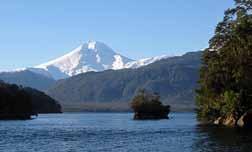
The first half of the 20th century was characterized by all kinds of unprecedented activity, including construction of new roads, the creation of new communities, and the beginning of cattle raising activity. The state then arrived to better organize all that had been done and to assert its sovereignty. In 1927 President Carlos Ibáñez created the territory of Aysén. Still, the area retained its nature as an open frontier for pioneers.

species in need of conservation: The Guaitecas cypress and the chungungo are vulnerable species.


Las costas que rodean el Monumento Natural Cinco Hermanas habían sido visitadas por expediciones científicas como la de Robert Fitz-Roy, pero solo en 1857 se aventura allí, por primera vez, la marina chilena. Lidera esta expedición el teniente Francisco Hudson, pero muere, y cinco años después el capitán Francisco Vidal Gormaz es enviado a la misma misión. Luego, en 1870, la Armada envía una nave a cargo del capitán Enrique Simpson (por el cual se nombra un canal que tiene acceso al monumento), quien reconoce las costas occidentales de la Patagonia, con la misión de encontrar un paso hacia los valles interiores. Tras varios intentos logra llegar hasta los inicios de la meseta patagónica, descubriendo el valle del río que lleva su nombre 4 .
Durante la primera mitad del siglo XX se despliega en la zona una inédita actividad, pues se abren rutas, se fundan pueblos y se inicia el cultivo y la ganadería. El Estado llegará después para regularizar lo ya establecido y extender la soberanía. El presidente Carlos Ibáñez del Campo, en 1927, crea el Territorio de Aysén; sin embargo, la zona conservaría el carácter de frontera abierta para los pioneros.
e species con problemas de conservación: El ciprés de las Guaitecas y el chungungo se consideran vulnerables.
Revisado 10-6-2012.


Wi NT er’s B A r K
s cientific name : Drimys winteri.
Conservation status : Low risk. A dominant tree species in abandoned, humid areas like ravines or hillsides facing south. Its leaves and bark were an important source of vitamin C for seamen who, during the 16th and 17th centuries used the winter’s bark to fight scurvy. It is interesting to note that this tree is closely related to tropical South American tree species.
Coigüe de Chi Loé.
s cientific name : Nothofagus nitida.
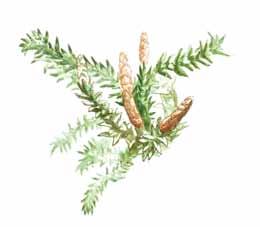

Conservation status : Low risk. This evergreen tree can grow as high as 35 meters. It inhabits very humid to waterlogged areas. It is associated with Drimys winteri , Weinmannia trichosperma and Pilgerodendron uvigerum
Te P ú.
s cientific name : Tepuaria stipularis.
Conservation status : Low risk. This is an evergreen tree or shrub, monotypic and endemic. It is common on flat, humid land where it often forms forests called “tepuales”.
g uA i T eCA s Cy Pr ess
s cientific name : Pilgerodendron uviferum.

Conservation status : Vulnerable. A tree endemic to the extreme southern parts of Chile and Argentina, it is the world’s southernmost coniferous tree. It has been used intensely for construction and much of its habitat has been destroyed. This, together with its slow growth rate, makes it vulnerable. Today it is illegal to commercialize the wood.
M A ri N e oTT er.
s cientific name : Lontra felina.

Conservation status : Vulnerable. These animals live in pairs or groups of three along Chile’s seacoast. They prefer the most barren rocky areas, exposed to wave action, and are active only during the day. They feed on crustaceans, mollusks and fish. Years ago they were heavily hunted, and although the practice continues to a lesser degree today, the principal threat is the competition from the fisheries and the harvest of other marine species. Population counts do not indicate that their numbers have stopped declining. Their most important natural predators are killer whales and sharks. Also found in : Islotes de Puñihuil and Isla Cachagua.
NeoT ro Pi C Cor M or ANT s cientific name : Phalacrocorax olivaceus.
Conservation status : Low risk. This bird is a permanent resident of the coastal waters of the Americas, from the southern United States to Patagonia. It dives underwater to fish and is a great swimmer. It is often seen on top of rocks, extending its wings in order to dry them. Also found in : Isla Cachagua.
C AN e Lo.
Nombre científico : Drimys winteri. e stado de conservación : Riesgo menor. Especie dominante en terrenos anegados o muy húmedos, como quebradas o laderas de exposición sur. Sus hojas y corteza eran una importante fuente de vitamina C para los marinos que, durante los siglos XVI y XVII, se aprovisionaban de canelo para combatir el escorbuto. Es interesante el hecho de que está muy emparentado con especies de árboles tropicales de Sudamérica.

Coigüe de Chi Loé.
Nombre científico : Nothofagus nitida. e stado de conservación : Riesgo menor. Es un árbol siempreverde que puede llegar a los 35metros de altura. Habita en terrenos muy húmedos e incluso anegados. Suele asociarse con Drimys winterii , Weinmannia trichosperma y Pilgerodendro nuvigerum.
Te P ú.
Nombre científico : Tepuaria stipularis. e stado de conservación : Riesgo menor. Arbusto o árbol siempreverde monotípico y endémico, común en terrenos planos y pantanosos, donde suele formar bosques denominados “tepuales”.

Ci Prés de LA s g uA i T eCA s. Nombre científico : Pilgerodendron uviferum. e stado de conservación : Vulnerable. Es endémico del extremo sur de Chile y Argentina. Es la conífera más austral del mundo. Fue usado intensivamente para construcción y gran parte de su hábitat ha sido despejado, lo que, sumado a su lento crecimiento, lo hace vulnerable. Hoy está prohibida la comercialización de su madera.
Chu N gu N go o N u T ri A MA ri NA Nombre científico : Lontra felina. e stado de conservación : Vulnerable. Vive en parejas o grupos de tres en el intermareal costero a lo largo de Chile; prefiere los roqueríos más escarpados y expuestos al oleaje y tiene hábitos diurnos. Se alimenta de crustáceos, moluscos y peces. Antiguamente era cazado, pero, aunque la práctica continúa hoy, la principal amenaza es la competencia con la pesca y recolección de especies marinas. Los censos no dan señales de que su población haya dejado de disminuir. Sus depredadores naturales más importantes son la orca y los tiburones. También en : Islotes de Puñihuil, Isla Cachagua.
Cor M orá N . Nombre científico : Phalacrocorax olivaceus. e stado de conservación : Riesgo menor. Residente permanente de las costas americanas, desde el sur de Estados Unidos a la Patagonia. Se sumerge para pescar (es un gran nadador). Se suele ver sobre las rocas, extendiendo las alas para secar sus plumas. También en : Isla Cachagua.



Natural Monument (NM) d eclaration d ate: October 13, 1982.
Location : Region XI of Aysén, Aysén Province and Aysén County.
surface area : 211 hectares (approximately). Forty-five years ago it was thought to contain only 180 hectares 1 .
Name origin: From the two lakes (dos lagunas) that form the NM: the Toro and the Escondida.
Motive for conservation: In addition to their great natural beauty, the two lakes are home to a large number of wild birds, including woodpeckers and swans. The plant life represents a transition area, or ecotone, between Aysén’s deciduous forest and the Patagonian steppe. The rich biodiversity of this ecotone is threatened, however, by both the cattle and forestry industries 2 .
fecha de creación como Monumento Natural (MN): 13 de octubre de 1982.
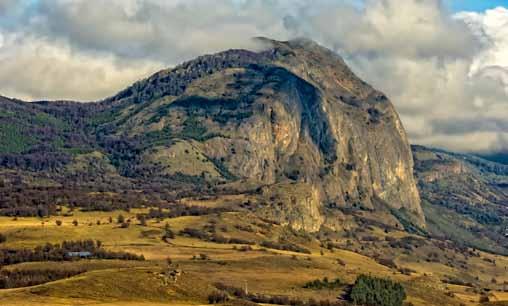
u bicación : XI Región de Aysén, provincia y comuna de Coyhaique. superficie : 211 hectáreas (aprox.). Hace 45 años se consideraron sólo 180 hectáreas 1
o rigen del nombre: Alude a las dos lagunas que lo conforman: El Toro y Escondida.
Motivo de conservación: Ambas lagunas, además de su belleza escénica, contemplan gran cantidad de aves silvestres, entre ellos carpinteros y cisnes. Su flora corresponde a la de un sector de transición entre el bosque caducifolio de Aysén y la estepa patagónica, dándole a este ecosistema el carácter de ecotono (zona de transición entre dos o más comunidades ecológicas), el que se ve amenazado por la actividad ganadera y forestal, con la consecuente pérdida de biodiversidad 2
1 Cf: CONAF, “Plan de manejo: Monumento Natural Dos lagunas”, XI Región de Aysén, Coyhaique, 2009, p. 17.
2 Ibid., p. 4.
2 Ibid., p. 4.
 Bosque de Nothofagus sp.
Bosque de Nothofagus sp.
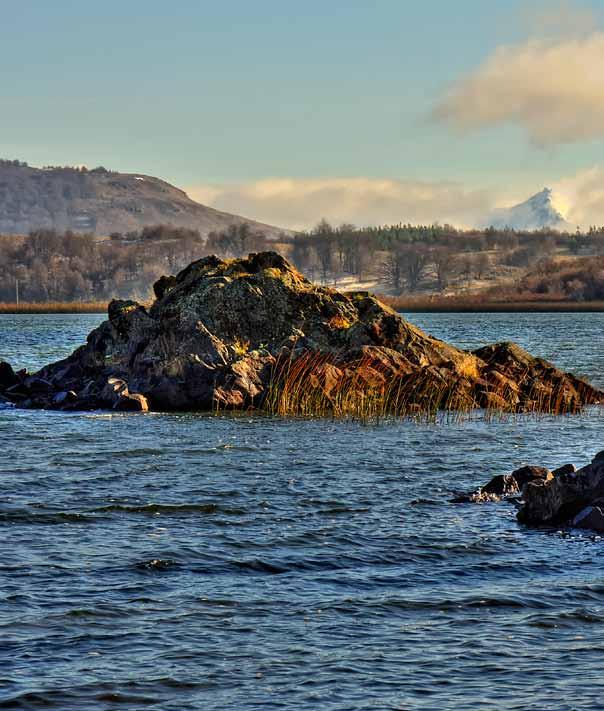
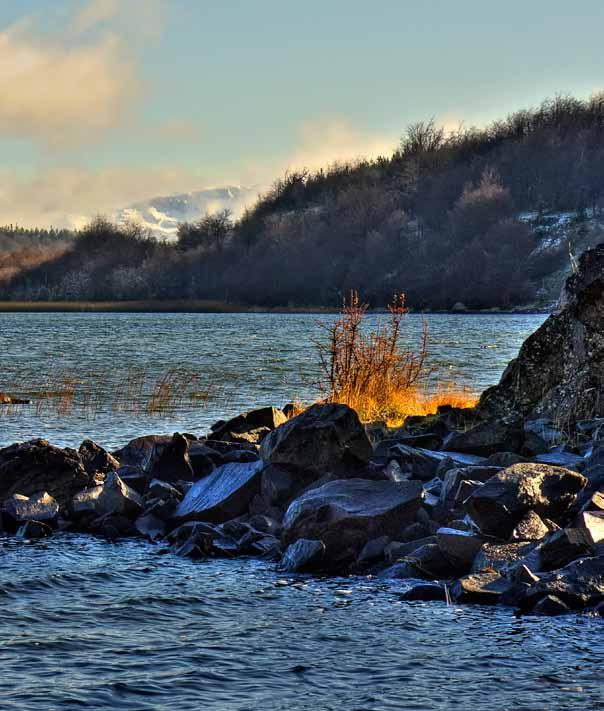
g eographic and climatic characteristics: This NM constitutes a transition area between the Patagonian steppe and the deciduous forest of Aysén, a native forest mainly composed of lenga and ñirre trees, two closely related species that frequently produce hybrids. These trees are very resistant to wind, so it is not unusual to find them standing alone in exposed areas, where they grow into strange and deformed shapes as a result of the wind. When the trees grow in rocky areas or crevices they may form natural “bonsais”.
The landscape is characterized by soft hills with occasional rocky areas that were formed by volcanic activity. These rocky formations are known as El Toro. In the surrounding area there are many small basins that have given rise to many lakes, large and small, within just a few square kilometers. A good example is the proximity of the Mellizas and El Zorro lagoons. Because of its numerous lakes, many bird species use the area as a rookery 3
f lora: Typical flora of this area includes a mixture of ñirre (Nothofagus antartica ), calafate (Berberis buxifolia ), notro (Embothrium coccineum ), wild strawberry (Fragaria chiloensis ), epiphytes, and endemic orchids such as the palomita (Codornochis lessoni ).

3 Ibid., p. 18.
Características geográficas y climáticas: Presenta un ambiente de transición entre la estepa patagónica y el bosque caducifolio de Aysén, bosque nativo compuesto principalmente por lenga y ñirre, dos especies tan emparentadas que frecuentemente producen híbridos. Son árboles muy resistentes al viento, por lo que es típico encontrarlos en laderas expuestas donde, solitarios, crecen de formas extrañas y deformadas por el viento. Cuando colonizan grietas o recovecos pueden formar “bonsáis” naturales.
El paisaje se caracteriza por suaves lomas entre las que sobresale una formación rocosa de origen volcánico, conocida como formación El Toro. En los alrededores hay múltiples microcuencas donde se han desarrollado lagunas y lagos en pocos kilómetros cuadrados, por ejemplo las lagunas Mellizas y El Zorro. Debido a la particularidad lacustre de la zona, muchas aves han utilizado este sector como sitio de nidificación 3 .
f lora: Existe una flora típica del lugar, que mezcla ñirre (Nothofagus antartica ), calafate (Berberis buxifolia ), notro (Embothrium coccineum ), epífitas, orquídeas endémicas como la palomita (Codornochis lessoni ), y frutillas silvestres (Fragaria chiloensis ).
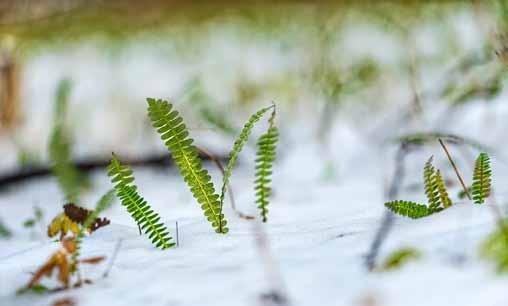
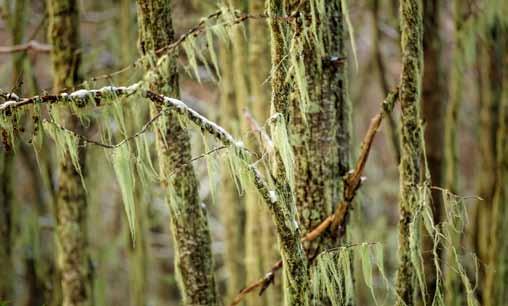

fauna: The principal bird species include the black woodpecker (Campephilus magellanicus ), the Chilean flicker (Colaptes pitius ), the austral parakeet (Enicognathus ferrugineus ), the austral thrush (Turdus falklandii magellanicus ), the brownhooded gull (Chroicocephalus maculipennis ), and the blacknecked swan (Cygnus melancoryphus ). The mammals include the red fox (Pseudalopex culpaeus ), the skunk (Conepatus chinga ) and the armadillo (Chaetophractus villosus )

Public usage and community relationship with the NM: This scenic area is near the international road connecting the capital of Aysén Region with the Republic of Argentina, by way of the Coyhaique Alto border pass.
Traveler notes: Charles Darwin, in his travels through the Southern Cone aboard the Beagle, observed the austral thrush (Turdus falklandii ) and compared it to the same bird species found in northern Chile. Describing their different nesting traits, Darwin explained that the northern thrush constructed their nests with clay, while the southern thrush “generally nest in rocky and dry areas, oftentimes near settlements, where their nests can be seen supported by houses. In this sense, they are much like the English thrush. Still, its song is very different –the American thrush is more tame, quiet and inquisitive”.
species in need of conservation: The black woodpecker in this area is considered to be vulnerable, although its situation farther north is more complicated. A similar trend is occurring with the black-necked swan – south of Aysén it is less threatened, but in Aysén proper and northwards it is considered vulnerable.
fauna: Las aves son, principalmente, el carpintero negro (Campephilus magellanicus ), el pitío (Colaptes pitius ), la cachaña (Enicognathus ferrugineus ), el zorzal (Turdus falklandii magellanicus ), la gaviota cahuil (Chroicocephalus maculipennis ) y el cisne de cuello negro (Cygnus melancoryphus ). También hay mamíferos como el zorro culpeo (Pseudalopex culpaeus ), el chingue (Conepatus chinga ) y el armadillo (Chaetophractus villosus )
relación con los habitantes y usos del MN: Este escenario natural se encuentra cerca del camino internacional que conecta a la capital regional de Aysén con la República Argentina por del paso fronterizo Coyhaique Alto.
Notas de viajero: Charles Darwin, en su viaje por el Cono Sur a bordo del Beagle, observa el zorzal (Turdus falklandii ), y lo compara con la misma especie de ave que habita más al norte del país. Describe sus diferencias en la nidificación, explicando que los zorzales del norte anidan con barro y, en cambio, en el sur “los zorzales generalmente anidan en zonas más rocosas y secas, rondan los pueblos y se los puede ver apoyados en las casas. En ese sentido, se parecen mucho al zorzal inglés, no obstante su canto es diferente, el zorzal americano es manso, silencioso e inquisitivo”.
e species con problemas de conservación: El carpintero negro en esta zona se considera vulnerable, aunque su situación hacia el norte es más complicada. Algo similar ocurre con el cisne de cuello negro, que, si bien desde Aysén al sur está relativamente menos amenazado, se considera vulnerable en esta área.
PALo M i TA .
s cientific name : Codornochis lessoni.
Conservation status : Not yet evaluated. This delicate orchid is the world’s southernmost orchid. It grows to as much as 50 cm and has a round bulb that retains its resources. It flowers from December to February and is found in the southern forests of Chile and Argentina.

A NTA rCT i C BeeC h.
s cientific name : Nothofagus antarctica.
Conservation status : Low risk. A deciduous tree that grows in poor, acidic soil in areas exposed to high wind and other kinds of erosion. It can grow like a shrub or to a height of 15 meters, depending on conditions. Also found in : Cueva del Milodón.
Chi L e AN f ire Bush
s cientific name : Embothrium coccineum.
Conservation status : Low risk. Its flowers are pollinated by birds that feed on its nectar and/or pollen, which indicates a mutualist relationship with the plant. The tree cannot reproduce by itself; rather, it can only reproduce by way of cross-pollination.
sT r AWB erry.
s cientific name : Fragaria chiloensis.
Conservation status : Low risk. This ground-level plant could be considered the grandmother of all the strawberries sold in markets around the world. Just like people, animals in the humid forests fed on these false fruits, which in fact are thickenings of the base of the plant’s inflorescence
C ALA fAT e.
s cientific name : Berberis buxifolia. Conservation status : Low risk. This is an evergreen shrub endemic to Patagonia. Its fruit may be eaten and is also used for dyes.

BroWN -hooded g u LL .
s cientific name : Chroicocephalus maculipennis.
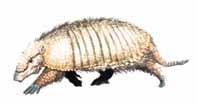
Conservation status : Low risk.
This bird is associated with maritime areas, although it has adapted to eating worms or urban garbage. It is found all over Chile, but the southernmost populations migrate to the center of the country during winter months. It builds large floating nests with aquatic plants.

M Age LLAN Wood PeCK er.
s cientific name : Campephilus magellanicus.
Conservation status : Endangered in the extreme northern areas of its distribution, vulnerable from Aysén southward.

This bird lives and nests in holes it makes in the trunks of trees of the Nothophagus genus – from the Maule Region to the Magallanes Region. It feeds mostly on larvae and beetles that live in the tree trunk. It is endemic to the southern temperate rainforest. Although it is difficult to see, its song is often heard, as is the sound it makes when pecking on the tree trunk. It has a marked sexual dimorphism.
Chi L e AN fL i CK er.
s cientific name : Colaptes pitius. Conservation status : Low risk. Lives in edge forests, in transition areas where there are open spaces. Feeds mostly on earth arthropods or insects when making holes in tree trunks. Unlike other woodpeckers, it does not nest in the tree holes it makes.

Aus T r AL PA r AK ee T
s cientific name : Enicognathus ferrugineus.
Conservation status : Low risk. Lives in groups of 10 to 15 individuals. Diet is based on the flowers, fruit and seeds of the Nothophagus species, complemented by a diet of tree fungi.
Ar MA di LLo.
s cientific name : Chaetophractus villosus.
Conservation status : Rare.
This carnivorous mammal is excellent in digging and spends most of its time underground. Its nose is adapted to breathe through pores in its skin to prevent inhalation of dirt. When it feels threatened it curls up into a ball and is protected by the plaques that cover its body. It eats insects and worms and is especially active at night.
Aus T r AL Thrush.
s cientific name : Turdus falklandii magellanicus.
Conservation status : Low risk. Very intelligent bird, found from the Atacama Desert to the most extreme southern parts of Chile, and commonly seen in cities. Feeds on soft fruit, worms and larvae. It inhabits the ground as well as the canopy of parks and forests.

PALo M i TA .
Nombre científico : Codornochis lessoni. e stado de conservación : No evaluado. Esta delicada orquídea es la más austral del mundo, crece hasta 50 cm y tiene un tubérculo redondo en el que almacena reservas. Florece de diciembre a febrero y puede encontrarse en los bosques australes de Chile y Argentina.

ñ irre.
Nombre científico : Nothofagus antarctica. e stado de conservación : Riesgo menor. Este árbol caducifolio de invierno crece en suelos pobres, ácidos, laderas expuestas al viento y otras formas de erosión. Puede crecer como arbusto o llegar a los 15 m, dependiendo de las condiciones. También en : Cueva del Milodón.
NoT ro.
Nombre científico : Embothrium coccineum. e stado de conservación : Riesgo menor. Sus flores son polinizadas por aves que se alimentan de néctar y/o polen, lo que indica una relación mutualista con la planta, ya que esta es auto-incompatible, o sea, solo puede reproducirse por polinización cruzada.

f ru T i LLA
Nombre científico : Fragaria chiloensis. e stado de conservación : Riesgo menor. Esta planta rastrera se podría considerar la abuela de las frutillas que se venden en los mercados de todo el mundo. Así como el hombre, los animales del bosque húmedo también se alimentan de sus falsos frutos, que en realidad corresponden a un engrosamiento de la base de la inflorescencia.

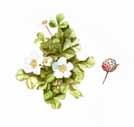
C ALA fAT e.
Nombre científico : Berberis buxifolia. e stado de conservación : Riesgo menor. Arbusto siempreverde endémico de la Patagonia, sus frutos son comestibles y también se usan para extraer pigmentos.
gAvioTA CA hui L . Nombre científico : Chroicocephalus maculipennis. e stado de conservación : Riesgo menor. Ave asociada a entornos marinos o lacustres, aunque se ha adaptado a alimentarse de gusanos en potreros y plantaciones o depósitos de desechos urbanos. Se distribuye por todo Chile, pero las poblaciones más australes migran al centro del país durante el invierno. Construye voluminosos nidos flotantes con plantas acuáticas.
C A r Pi NT ero N egro, gALLo de M o NT e. Nombre científico : Campephilus magellanicus. e stado de conservación : En peligro en el extremo norte de su distribución, vulnerable de Aysén al sur. Habita y anida en hoyos que hacen en los troncos de árboles del género Nothophagus desde la región del Maule a Magallanes, se alimenta principalmente de larvas y escarabajos que viven en la madera. Es endémico del bosque temperado austral, donde, aunque es difícil de ver, suele oírse su canto, o el sonido de su martilleo en los árboles. Presenta dimorfismo sexual.


Pi T ío.
Nombre científico : Colaptes pitius. e stado de conservación : Riesgo menor. Habita en los bordes de bosques, en la transición hacia los espacios abiertos, se alimenta de artrópodos del suelo o de insectos de la madera, los que encuentra dentro de troncos de árboles haciendo hoyos en ellos. A diferencia de otros carpinteros, no suele anidar en los troncos ahuecados.
C AC h A ñ A .
Nombre científico : Enicognathus ferrugineus. e stado de conservación : Riesgo menor. Vive en bandadas de 10 a 15 individuos. Su dieta se basa en flores, frutos y semillas de Nothophagus , la cual complementan con hongos arbóreos.
Ar MA di LLo.
Nombre científico : Chaetophractus villosus. e stado de conservación : Rara. Este mamífero carnívoro es un gran excavador, pasa la mayor parte del tiempo bajo tierra. Tiene la nariz adaptada para respirar a través de los poros del suelo sin aspirar tierra. Cuando se siente amenazado se enrosca como bola y queda protegido por las placas que cubren su cuerpo. Se alimenta de insectos y gusanos, y es particularmente activo durante la noche.

zorz AL
Nombre científico : Turdus falklandii magellanicus. e stado de conservación : Riesgo menor. Ave muy astuta, habita desde Atacama al extremo sur de Chile. Muy común en el entorno urbano. Se alimenta de frutos blandos, lombrices y larvas. Habita tanto en tierra como en el dosel de parques y bosques.

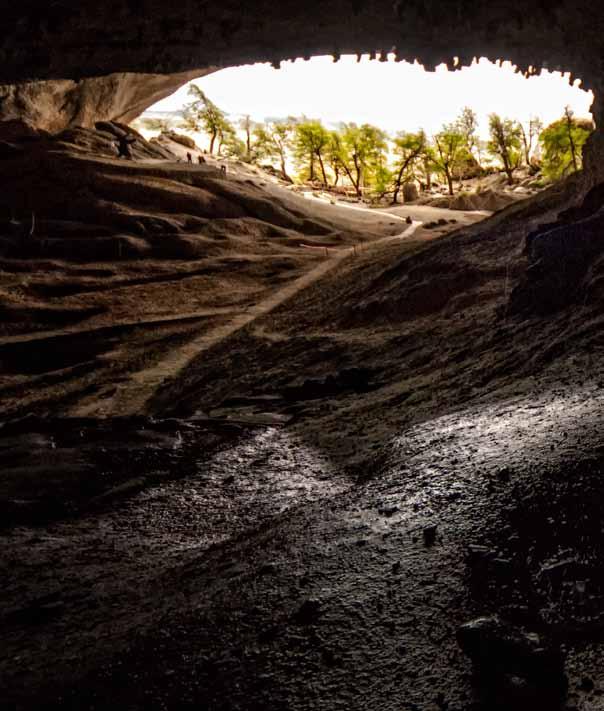


Natural Monument (NM) d eclaration d ate: December 16, 1993. It was originally declared a Historic Monument in 1968.
Location: Region XII of Magallanes and Chilean Antarctica, Última Esperanza Province, Puerto Natales County.
surface area: 189.5 hectares.
Name origin: In 1895 immigrant settler Herman Eberhard discovered the skin and remains of a giant ground sloth – a mylodon – in a nearby cave, or cueva in Spanish. Darwin was the first to discover the fossil remains of a mylodon, when exploring south of Buenos Aires, Argentina in 1833. British scientist Richard Owen gave the name Mylodon Darwinii to the species, since Darwin had been the first to discover the creature, although not exactly the same as the one found in the cave.
Motive for conservation: It is a source of paleontological evidence of various species that once inhabited the area, like the giant panther (Panthera onca mesembrin ) and a small, prehistoric horse (Hippidion saldiasi ). The site also has archeological value because of the human communities that once lived there.
g eographic and climatic characteristics: It is a cold steppe climate, with an average temperature of 8 °C and annual rainfall between 400 to 500 mm 1 . Over time, the heavy rainfall at this latitude dropped off greatly, while the height of the Andes and the Coastal Mountains Range also gradually declined, resulting in greater winds and greater encroachment of coastal conditions. It is interesting to note that while the local fauna have changed greatly since prehistoric times, the flora continue to be mostly the same.
f lora: Deciduous Magellanic forest, comprised mostly of ñirre (Nothofagus antartica ), a shrub-like tree, and lenga (a much taller tree). Other plant life includes the leña dura (Maitenus magellanica ), prados de cadillo ( Acaena ovalifolia ) and arbustos de chaura (Gaulteria mucronata ).
fauna: Mammals found here include the fox (Pseudalopex culpaeus ), the puma (Puma concolor ), the mountain cat and the skunk (Conepatus chinga ). Birds visiting the area and nesting here include the southern crested caracara (Polyborus plancus ), the eagle (Geranoaetus melanoleucus ) and the condor (Vultur gryphus ).
fecha de creación como Monumento Natural (MN): 16 de diciembre de 1993. En 1968 había sido declarado Monumento Histórico.
superficie: 189,5 hectáreas.
u bicación : XII Región de Magallanes y Antártica Chilena, provincia de Última Esperanza, comuna de Puerto Natales.
o rigen del nombre: En 1895 el colono Herman Eberhard descubrió en esta gruta piel y restos de milodón. El primer fósil de milodón lo halló Darwin en 1833, al sur de Buenos Aires, Argentina. El inglés Richard Owen le da el nombre de Mylodon Darwinii , por haber sido Darwin el primero en encontrar sus restos, aunque no fue en esta caverna.
Motivo de conservación: Constituye una fuente de evidencia paleontológica sobre varias especies extintas de la zona, como el jaguar del Pleistoceno (Panthera onca mesembrin ) y un équido (Hippidion saldiasi ). También tiene valor arqueológico por las comunidades humanas que se refugiaban allí.
Características geográficas y climáticas: Su clima es de estepa frío. La temperatura media alcanza los 8 °C y las precipitaciones son de 400 a 500 mm 1 . Las lluvias a esta latitud han disminuido bastante y la altura de las cordilleras de los Andes y de la Costa también, lo que provoca que vientos y flujos marítimos penetren el territorio. Es interesante recordar que mientras la fauna ha cambiado desde la prehistoria, los registros muestran que la composición de especies de plantas sigue siendo muy similar.
f lora: Bosque magallánico deciduo, que se compone de ñirre (Nothofagus antartica ), una especie más bien arbustiva, y de lenga, que es una especie de árbol alto. Otras plantas presentes son la leña dura (Maitenus magellanica ), prados de cadillo ( Acaena ovalifolia ) y arbustos de chaura (Gaulteria mucronata ).
fauna: Se observan mamíferos como el zorro culpeo (Pseudalopex culpaeus ), el puma (Puma concolor ), el gato montés y el chingue (Conepatus chinga ). Entre las aves que visitan el área y anidan, las más comunes son el carancho (Polyborus plancus ), el águila (Geranoaetus melanoleucus ) y el cóndor (Vultur gryphus ). 1 www.conaf.cl Revisado 25-5-2012.


Public usage and community relationship with the NM: This Natural Monument is important to scientists because of the great amount of geoclimatic information it contains. The cave itself was the result of wave action, and was formed between 20,000 and 14,500 years ago when sea levels were much higher and the continent had not risen up to its current height.
Traveler notes: According to Mateo Martinic in 1966, “Hermann Eberhard, grandson to a pioneer, found on the cave’s floor, about 100 meters from the entranceway, a piece of dry skin partially embedded in the dirt. They kicked at it with their feet, but could not get it out because it was so deeply buried. Once they finally pulled it out, they saw that it was a large piece of leathered skin, but a kind they had not seen before. It was covered by long hair and small bones were irregularly distributed in it. This skin was doubled up like an accordion, and was very difficult to open since it was so hard.” This is how the circumstances of discovery were related years later by Ernst von Heinz, one of the leaders of the group that made the finding, as told to Joseph Emperaire and Annette Laming 2
2 Mateo Martinic Beros: La Cueva del Milodón: historia de los hallazgos y otros sucesos: relación de los estudios realizados a lo largo de un siglo (1895-1995) [Cave of the Mylodon: a story of discoveries and other events. Investigations realized throughout a century (1895-1995)], Universidad de Magalllanes. Anales del Instituto de la Patagonia. Serie Ciencias Humanas, vol. 24, 1996, pp. 43-80.
relación con los habitantes y usos del MN: La importancia científica de este MN reside en que constituye una rica fuente de información geoclimática para el sur del continente. La cueva misma se formó, debido al oleaje, entre 20.000 y 14.500 años atrás, cuando el nivel del mar era más alto y el continente no se había elevado aún a su altura actual.

Notas de viajero: Según Mateo Martinic en 1966, “el señor Hermann Eberhard, nieto del pionero, se encontró en el suelo, aproximadamente a un centenar de metros de la entrada, un trozo de piel seca que sobresalía semienterrado en el polvo. Lo empujaron con sus pies. El objeto no se movió, estaba profundamente enterrado. Cuando fue extraído, observaron que era un gran pedazo de cuero, de una clase que nunca habían visto. Estaba cubierto con pelos largos y tenía incrustados huesecillos distribuidos irregularmente. El cuero formaba una especie de paquete, plegado como acordeón, y era muy difícil abrirlo, pues estaba muy endurecido”. Así relataría muchos años después Ernst von Heinz, uno de los protagonistas del suceso, a Joseph Emperaire y Annette Laming, las circunstancias del hallazgo”2
2 Mateo Martinic Beros: La Cueva del Milodón: historia de los hallazgos y otros sucesos. Relación de los estudios realizados a lo largo de un siglo (1895-1995), Universidad de Magallanes, Anales, Serie Ciencias Humanas, vol. 24, 1996, pp. 43-80.
species in need of conservation: At a national level the puma is considered a threatened species, mostly because of illegal hunting by cattlemen and loss of habitat. Condors, for their part, are threatened in more northern parts of Chile, but free from danger in this area.


relationship with pre- h ispanic cultures: Because of the abundance of information in the area about the mylodon, the species has been linked to certain aboriginal myths that spoke of hunting animals with tremendously tough skin. While this could not have been possible, since the mylodon was extinct many thousands of years ago, it is interesting to see how its discovery has impacted the region’s popular culture.
e species con problemas de conservación: El puma está evaluado a nivel nacional como casi amenazado, principalmente por la caza ilegal que hacen algunos ganaderos y por la pérdida de su hábitat. Por su parte, afortunadamente, el cóndor, que se encuentra con problemas de conservación desde la región de Aysén hacia el norte, en esta zona se considera fuera de peligro. relación con culturas prehispánicas: Debido a la abundante información acerca del milodón en la zona, se llegó a relacionar a esta especie con ciertos cuentos aborígenes que mencionaban la caza de unos animales de piel muy dura. Si bien esto no es posible, ya que el milodón está extinto desde hace milenios, es interesante observar el impacto que este hallazgo ha tenido en la cultura popular de la región.
T Wo-s Pi N ed ACA e NA .
s cientific name : Acaena ovalifolia. Conservation status : Low risk. A common herb found in southern Chile. Its fruit has points at its end that cling to animal fur, which helps the dispersion of its seeds.

Pri CKLy h e AT h.
s cientific name : Gaulteria mucronata. Conservation status : Low risk. A shrub that grows from Arauco to Cape Horn, with edible fruit. Also found in : Dos Lagunas.

M Age LLAN ’s M Ay T e N .
s cientific name : Maitenus magellanica. Conservation status : Low risk everywhere except the Magallanes Region, where it is vulnerable. This shrub, endemic to the south of Chile and Argentina, has been introduced to other parts of the world because of its ornamental value. It is found on both sides of the Andes Mountains and is highly valued because of the hardness of its wood.
B LACK- C hes T ed Buzz A rd eAg L e. s cientific name : Geranoaetus melanoleucus.
Conservation status : Not evaluated. Bird of prey that ranges from Arica to Tierra del Fuego. Flying in high circles, it searches for prey, including rabbits, snakes, rodents and other birds. Also found in : Contulmo and El Morado.
A N de AN Co N dor.
s cientific name : Vultur gryphus.
Conservation status : Vulnerable from the extreme north of the country to Maule. Rarely seen between Region VIII and Region X. Out of danger from Aysén southward.
It is possible to see this giant vulture – soaring high in the sky looking for carrion – in mountainous areas throughout South America. The male is distinguished from the female by its red crest, while both share a characteristic white-feathered collar. It is, by a great margin, the largest bird in Chile, with an extended wingspan of as much as 3.2 meters. It is used in heraldic national iconography and has a role in indigenous mythology in many countries, including Colombia, Ecuador, Peru, Bolivia and Chile. Even so, it is threatened by loss of territory and poisoning. Also found in : El Morado and Salar de Surire.
s ou T h A M eri CAN gr Ay fox s cientific name : Pseudalopex griseus. Conservation status : Low risk. A solitary animal that feeds on rodents, young pigeons, bird eggs, fruit, seeds and insects. Roams the shrub-steppe landscapes, where it reproduces each spring with up to five pups. It occasionally attacks chicken coops, and it is common in Patagonia to put traps with poisoned meat. Its numbers have fallen in some areas where it is also hunted by abandoned dogs. Also found in : Dos Lagunas, Contulmo, Pichasca, and Quebrada Cardones.
r ed fox.
s cientific name : Pseudalopex culpaeus. Conservation status : Low risk.
A solitary animal that feeds on rodents, rabbits, birds, lizards and – to a lesser degree – plants and carrion. In some areas they attack sheep herds, where proprietors of livestock hunt them either with arms or poison. As a result, foxes have become very rare in some areas, and extinct in others. Habitat is open scrubland. Also found in : Dos Lagunas, Contulmo.
Pu MA .
s cientific name : Puma concolor

Conservation status : Almost threatened. Territorial and solitary, each animal can occupy up to 1,000 square kilometers. Its protection, then, depends upon the preservation of large extensions of land necessary for its habitat. It hunts camelids such as the guanaco and other mammals, including foxes, skunks, and species as small as insects and rodents. It normally ambushes its prey. When its territory is invaded by man, it can get angry and attack cattle and, very infrequently, people. Also found in : Contulmo.
sK u NK .
s cientific name : Conepatus chinga. Conservation status : Rare.
An omnivorous, solitary animal that is most active at night. It lives in caves it builds itself or caves taken from other animals. When threatened, it expels a foul smelling spray that can be smelled many kilometers away. Also found in : Dos Lagunas, Contulmo.

C A di LLo.
Nombre científico : Acaena ovalifolia. e stado de conservación : Riesgo menor. Hierba común en los pastizales del sur de Chile, sus frutos terminan en unas puntas que se enganchan al pelaje de los animales, lo que ayuda a que se dispersen sus semillas.

Ch Aur A
Nombre científico : Gaulteria mucronata. e stado de conservación : Riesgo menor. Arbusto que crece de Arauco al Cabo de Hornos; sus frutos son comestibles. También en : Dos Lagunas.
Leñ A dur A
Nombre científico : Maitenus magellanica. e stado de conservación : Riesgo menor en toda su distribución excepto la región de Magallanes, donde se considera vulnerable.
Arbusto endémico del sur de Chile y Argentina, se ha introducido en otras partes del mundo por su valor ornamental. Crece en ambas cordilleras y es muy apreciado por la dureza de su madera.
águi LA .
Nombre científico : Geranoaetus melanoleucus. e stado de conservación : No evaluado. Ave de presa que habita deArica a Tierra del Fuego. Describiendo círculos al planear, busca a sus presas, entre las que se encuentran liebres, culebras, roedores y aves. También en : Contulmo, El Morado.
Có N dor.
Nombre científico : Vultur gryphus. e stado de conservación : Vulnerable desde el extremo norte al Maule, raro desde la VIII a la X región, fuera de peligro de Aysén al sur. Es posible ver a este buitre gigante planeando en busca de carroña, en zonas montañosas de Sudamérica. El macho se diferencia de la hembra por una cresta rojiza y ambos tienen un característico collar de plumas blancas. Es, con gran diferencia, el ave más grande de Chile, llegando a alcanzar 3,2 metros de envergadura (ancho de alas extendidas). Forma parte de las simbologías patrias y de las mitologías indígenas de Colombia, Ecuador, Perú, Bolivia y Chile, pese a lo cual está amenazado por pérdidas de territorio y envenenamiento.


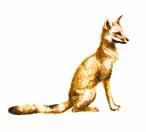


También en : El Morado, Salar de Surire.
zorro C hi LLA .
Nombre científico : Pseudalopex griseus. e stado de conservación : Riesgo menor. Se alimenta de roedores, pichones, huevos de ave, frutos, semillas e insectos. Usa las áreas de estepa y matorral, donde se reproduce en primavera y tiene hasta cinco crías. Ocasionalmente puede atacar los gallineros, por lo que los habitantes de la Patagonia le ponen trampas y/o carroña envenenada. Su población ha disminuido en algunas zonas debido a que es presa de jaurías de perros domésticos abandonados. Hábito solitario.
También en : Dos Lagunas, Contulmo, Pichasca, Quebrada Cardones.
zorro roJ o, zorro C u LPeo. Nombre científico : Pseudalopex culpaeus. e stado de conservación : Riesgo menor. Se alimenta de roedores, conejos, aves y lagartos, y en menor medida de plantas y carroña. En algunas zonas ataca a los rebaños de ovejas, por lo que ha sido perseguido duramente por los ganaderos, que le disparan o envenenan carroñas. En consecuencia, se ha vuelto muy raro en algunas zonas y en otras se ha extinguido. Habita entre matorrales de lugares abiertos y es de hábito solitario. También en : Dos Lagunas, Contulmo.
Pu MA
Nombre científico : Puma concolor. e stado de conservación : Casi amenazado. Es territorial y solitario; cada individuo puede ocupar un territorio de 1.000 km cuadrados, por lo que su conservación depende de la preservación de grandes extensiones de hábitat. Caza camélidos como el guanaco, otros mamíferos como zorros y chingues, y especies tan pequeñas como insectos y roedores. Es típicamente un depredador de emboscada. Cuando su territorio se traslapa con el del hombre puede “cebarse” y atacar al ganado bovino y, muy ocasionalmente, a las personas. También en : Contulmo.
Chi N gue.
Nombre científico : Conepatus chinga. e stado de conservación : Rara. Especie omnívora y generalista, de hábitos solitarios y más activo durante la noche. Habita en cuevas que cava él mismo o que usurpa a otros animales. Cuando se siente amenazado, expele un líquido fétido que se huele a kilómetros. También en
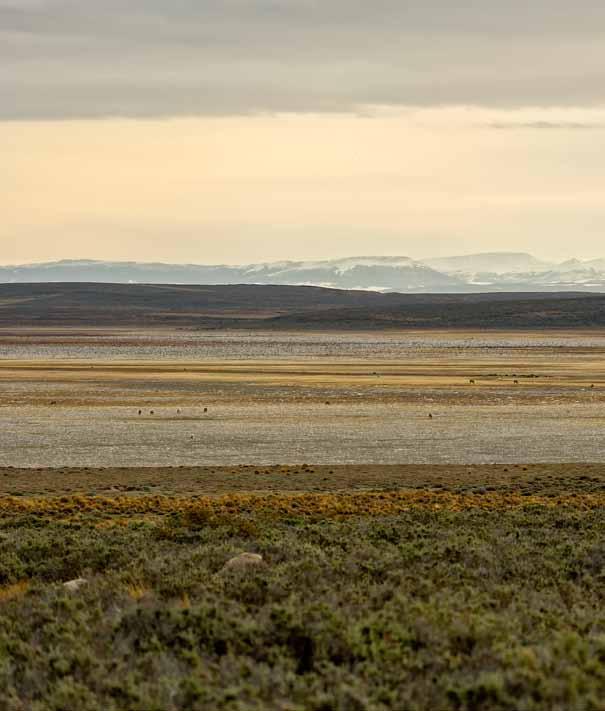

Natural Monument (NM) d eclaration d ate: October 13, 1982.
Location: Region XII, of Magallanes and Chilean Antarctica; Tierra del Fuego Province, Porvenir County.
surface area: A total of 25.3 hectares in its original conformation of seven interior islets within the lake. But with the diminution of the water surface since the 1980’s 1 , the islets now are joined and form a single peninsula that connects with neighboring properties.
Name origin: The name results from the abundance of swans (cisnes in Spanish) on the lake when it was fist declared a Natural Monument. Today, these swans are only occasional visitors.

Motive for conservation: The NM was created to provide protection for a diversity of bird species. The island peninsula offers protection during critical life cycles, and is an important center for the reproductive cycle of various bird species – native and endemic – that live there year round or seasonally, from spring through autumn. These include flamingos, dotterels, and sandpipers that nest, reproduce and raise their young here.
fecha de creación como Monumento Natural (MN): 13 de octubre de 1982.
u bicación : XII Región de Magallanes y Antártica Chilena, provincia de Tierra del Fuego, comuna de Porvenir.
superficie: 25,3 hectáreas en su conformación original de siete islotes interiores de una laguna. Debido a una disminución del espejo de agua, desde comienzos de los 80 1 estos islotes se fueron fusionando hasta conformar una sola gran península, unida, por medio de un corredor de tierra, con predios vecinos.
o rigen del nombre: Se debe a la abundancia de cisnes en el momento de la creación del MN; sin embargo, hoy estas aves solo se ven de forma ocasional.
Motivo de conservación: Es un centro importante para el ciclo reproductivo de diversas especies de aves, nativas o endémicas, que habitan allí durante todo el año, o bien de primavera a otoño: flamencos, chorlos y playeros que se reproducen, nidifican y crían. Las lagunas ofrecen protección durante las etapas críticas del ciclo reproductivo. Este MN fue creado para proteger dicha variedad avícola.
g eographic and climatic characteristics: It has a transAndean climate with a degenerative steppe vegetation. The average temperature is 8 °C, while annual rainfall is between 400 and 500 mm. Because of its aquatic environment, the humidity ranges between 60 and 90 percent.
f lora: Sheep from neighboring properties enter the Natural Monument and often graze on the peninsula, diminishing the vegetation. This situation changes beyond a fence after islet No. 4. From islet No. 4 to islet No. 6, native vegetation like romerillo, cola de zorro and calafate is found.
fauna: There is rich and abundant birdlife, which depends on a variety of factors, including the hydrologic regime, and the size, heterogeneity and structure of the vegetation. Since the lake is composed of brackish water, many species use it only during the winter months, or part of them. On the peninsula, species such as the upland goose, kelp gull (Larus dominicanus ), buff-necked ibis (Theristicus melanosis ), long-tailed meadowlark (Sturnella loyca ), rufous-collared sparrow and the Magellanic plover are found.
Características geográficas: Clima trasandino con degeneración esteparia. La temperatura media alcanza los 8 °C y las precipitaciones anuales van de 400 a 500 mm. Debido a su ambiente acuático, la humedad varía entre un 60 y un 90 por ciento.
f lora: El ganado ovino de los predios colindantes vulnera los límites naturales del MN y con frecuencia pastan en la península, provocando la disminución de la cobertura vegetal. Pasado el cerco que sigue al islote N°4, hasta el islote N° 6 la situación cambia, dando paso a vegetación nativa, siendo las más comunes el romerillo, la cola de zorro y el calafate.
fauna: Presenta riqueza y abundancia de aves, las que dependen de diversos factores, como el régimen hidrológico, el tamaño, la heterogeneidad y la estructura de la vegetación. Al ser el MN una laguna salobre, muchas especies la utilizan solo en la época invernal o parte de ella. En la península se encuentran el caiquén, la gaviota dominicana (Larus dominicanus ), la bandurria (Theristicus melanosis ), la loica (Sturnella loyca ), el chincol austral y el chorlo de Magallanes.
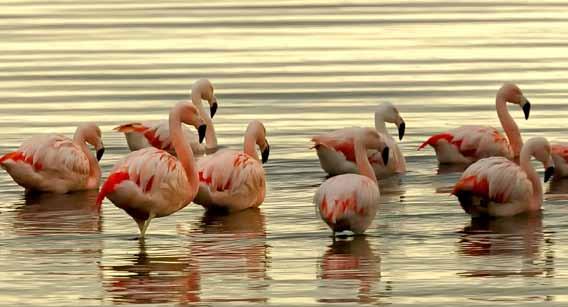


Since these islets have become a peninsula, the site is now accessible to predators like foxes and dogs. This explains the drop off in the number of birds (Ramírez et al. , 2009) and the absence of nesting pairs of blacknecked swans, which were common in the 1970s.
In shallow areas it is possible to see migrating birds like the whiterumped sandpiper and the Chilean flamingo (Phoenicopterus chilensis ). The latter species is a winter visitor, although in some years a few individuals remain in the area for a longer time.
Other species include the crested duck (Lophonetta specularioides ) and the Magellanic steamer duck (Tachyeres patachonicus ).
Near the peninsula there is an area of small peaks where two species of cormorants are seen: the imperial cormorant (Phalacrocorax atriceps ) and the Magellanic cormorant (Phalacrocorax albiventer ). Both are accompanied by lesser numbers of ibis and kelp gulls.
Debido a que hoy los islotes forman una península, el lugar es accesible a predadores como zorros y perros, la que puede explicar la merma de aves al interior de los islotes (Ramírez et al ., 2009) y la ausencia de nidificación, la que sí existía en los años 70 para el cisne de cuello negro.
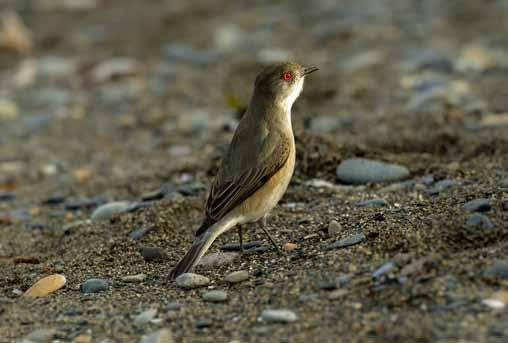
En sectores de aguas poco profundas es posible observar aves migratorias como el playero de lomo blanco y el flamenco chileno (Phoenicopterus chilensis ). Esta última especie es un visitante invernal, aunque en algunos años han permanecido unos pocos individuos en esta área por un mayor período de tiempo.
Otras especies son el pato juarjual (Lophonetta specularioides ) y el pato quetru volador (Tachyeres patachonicus ).
Cerca de la península hay un área de trombolitas en forma de picachos, donde se observan dos especies de cormoranes: el imperial (Phalacrocorax atriceps ) y el de las Malvinas (Phalacrocorax albiventer ). Son acompañados en menor cantidad por bandurrias y gaviotas dominicanas.

On the lake’s shores, where there is shallow, protected water, different species of plovers and beach birds are found, including the two-banded plover (Charadrius falklandicus ), the white-rumped sandpiper (Calidris fusicollis ) and the Baird’s sandpiper (Calidris bairdii ). The Magellanic plover (Pluvianellus socialis ) is especially important, because it is endemic to Patagonia and classified as rare.
Other birds that can be observed include the Magellanic oystercatcher (Haematopos leucopodus ), the barwinged cinclod (Cinclodes fuscus ), and sparrows like the rufous-collared sparrow (Zonotrichia capensis ).
Public usage and community relationship with the NM: This NM preserves a certain kind of natural space, emphasizing its relevance for the community and for our ecological patrimony.

En las riberas de la laguna, con aguas someras y protegidas, es posible encontrar diversas especies de chorlos y playeros, como el chorlo de doble collar (Charadrius falklandicus ), el playero de lomo blanco (Calidris fusicollis ) y el playero de Baird (Calidris bairdii ). Especial relevancia tiene el chorlo de Magallanes (Pluvianellus socialis ), especie endémica del sur de la Patagonia, clasificada en categoría de rara.
Otras aves observadas son el pilpilén austral (Haematopos leucopodus ), el churrete acanelado (Cinclodes fuscus ) y Passeriformes como el chincol austral (Zonotrichia capensis ).
relación con los habitantes y usos del MN: Este MN valoriza ciertos espacios naturales, destacando su relevancia para la comunidad y patrimonio ecológico.
Traveler notes: At the beginning of the 19th century well known naturalist Claudio Gay wrote about the black-necked swan: “This swan is very common in the Americas and most especially in La Plata, where its down is sold. It is found on the lakes and plains of Chile’s mountains. It can only flee when on the water, and so countrymen oftentimes kill them with clubs when they find them on land… their eggs are two or three times larger than a turkey’s egg, taste good and are sold in the markets”2 .
species in need of conservation: These include the ruddyheaded goose, the flamingo and the black-necked swan, all classified as vulnerable. Although the black-necked swan is relatively secure in this region, towards the north it is believed to be becoming extinct. The white-necked swan, however, is vulnerable wherever it is found.
It is noteworthy to point out that the very rare Magellanic plover (Pluvianellus socialis ) can be seen in this NM. Only 1,500 birds of this species are believed to remain on the planet. They are found only in the extreme southernmost parts of South America, north of Tierra del Fuego Island.
Notas de viajero: A principios del siglo XIX los escritos de Claudio Gay, reconocido naturalista, se refieren al cisne de cuello negro diciendo que “este cisne es mui común en la América meridional i sobre todo en La Plata, donde se comercia con su pellejo. Se encuentra en los lagos i llanos de las cordilleras de Chile. Solo puede huir en el agua, así los paisanos suelen matarlos a palos cuando se encuentran en tierra ... los huevos son dos o tres veces mayor que los del pavo, de buen gusto i que se venden en los mercados ”2 e species con problemas de conservación: El cauquén colorado, el flamenco y el cisne de cuello negro están clasificados como vulnerables, aunque este último se encuentra relativamente más asegurado en esta región (hacia el norte se lo considera en peligro de extinción); el cisne de cuello blanco, por su parte, es vulnerable en toda su distribución.
Hoy destaca en el MN el chorlo de Magallanes (Pluvianellus socialis ), especie considerada rara y de la que, en el mundo, no existen más de 1.500 individuos, distribuyéndose solamente en el extremo sudamericano austral (norte de Isla Tierra del Fuego).
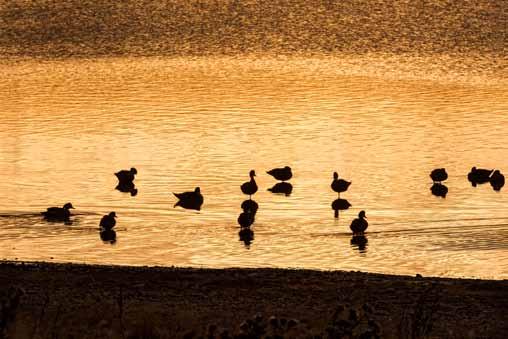
B LACK N eCK ed s WAN .
s cientific name : Cygnus melancoryphus.
Conservation status : In danger of extinction in Regions VIII and X, vulnerable from Aysén southward. Permanent inhabitant of lagoons, feeding on algae and fish eggs. Nests in protected islands. Lives in groups with individuals of its own species and other species. Scientific name comes from cygnus , which means swan; melanco means black and ryphus means neck. Also found in : Dos Lagunas.
Whi T e N eCK ed s WAN .
s cientific name : Coscoroba coscoroba.
Conservation status : Endangered. Coscoroba is the indigenous name for this species. It lives in groups along with other bird species. The southernmost groups migrate north in the winter months, as far as Huasco. They feed on algae and crustaceans, and nest in small islands.
fLAM i N go.
s cientific name : Phoenicopterus chilensis.

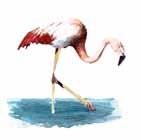
Conservation status : Vulnerable in its entire range of habitat, except in Regions IV and X where it is considered to be rare. Lives in groups and feeds on small aquatic invertebrates. Lives as far south as Tierra del Fuego but migrates north to nest. Also found in : Salar de Surire.
Ashy-he A ded g oose.
s cientific name : Chloephaga poliocephala.
Conservation status : Low risk. Feeds on algae and aquatic plants. Is gregarious, occupies lagoon areas for nesting and raising its chicks.
uPLAN d g oose.
s cientific name : Chloephaga picta.
Conservation status : Low risk.
Lives in Argentine plains ( pampa ) and migrates south in early spring to nest in fields near lagoons. Often found in pairs with a marked sexual dimorphism. During mating season the male’s plumage becomes very colorful, which gives rise to the name of the species –picta – which means “painted” in Latin.
r uddy-he A ded g oose.
s cientific name : Chloephaga rubidiceps.

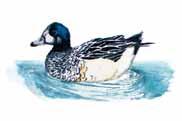
Conservation status : At risk in Regions VII and XIV, and vulnerable from the Araucanía Region southward. A gregarious species that feeds on algae and water plants. Lives as far south as Magallanes, but migrates to northern Chile during winter months.
g re AT egre T.
s cientific name : Egretta alba.
Conservation status : Low risk. This bird is found throughout Chile on the shores of rivers and lagoons, where it nests and feeds on fish, amphibians, and invertebrates. Also found in : Dos Lagunas.
s ou T her N Cres T ed C A r ACA r A . s cientific name : Polyborus plancus. Conservation status : Low risk. A raptor and carrion eater found widely throughout Chile and Argentina. Also found in : Cueva del Milodón, Dos Lagunas, and El Morado.

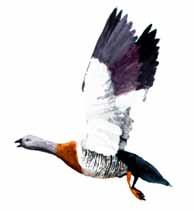
Cres T ed d u CK .
s cientific name : Lophoneta specularioides.
Conservation status : Species not evaluated. It nests in high grass close to water and feeds on algae and invertebrates. It lives in the Chilean/ Argentine Patagonia area and in the Falkland Islands. A highland subspecies is found in mountain lakes. Also found in : El Morado.
Chi Loé Widgeo N
s cientific name : Anas sibilatrix. Conservation status : Low risk. Widely distributed in the calm rivers and lagoons of Chile and Argentina.
Cis N e de C ue LLo N egro. Nombre científico : Cygnus melancoryphus. e stado de conservación : En peligro entre las Regiones VIII y X, vulnerable de Aysén al sur.


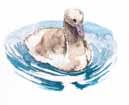
Habita permanentemente en lagunas donde se alimenta de algas y huevos de peces. Anida en islotes protegidos. Vive en grupo con individuos de su especie y de otras. Su nombre científico viene de cygnus , que significa cisne;melanco es negro y ryphus quiere decir cuello. También en : Dos Lagunas.
Cis N e de C ue LLo BLANCo.
Nombre científico : Coscoroba coscoroba. e stado de conservación : En peligro. Coscoroba es el nombre indígena para esta especie. Vive en grupos con aves de otras especies, las poblaciones más australes migran hacia el norte durante el invierno, encontrándose hasta Huasco. Se alimenta de algas y crustáceos y anida en islotes.

fLAM e NCo.
Nombre científico : Phoenicopterus chilensis. e stado de conservación : Vulnerable en todo su rango excepto entre las Regiones IV y X, donde es considerada rara. Vive en grupos y se alimenta de pequeños invertebrados acuáticos. Habita hasta Tierra del Fuego, pero migra hacia el norte para nidificar. También en : Salar de Surire.
C Au Qué N CAB ez A gris. Nombre científico : Chloephaga poliocephala. e stado de conservación : Riesgo menor. Se alimenta de algas y plantas acuáticas, es gregario, ocupa lagunas para hacer sus nidos y criar polluelos.
C Au Qué N .
Nombre científico : Chloephaga picta. e stado de conservación : Riesgo menor. Habita en las pampas argentinas y migra al sur a principios de la primavera para nidificar en praderas cercanas a lagunas. Suelen encontrarse en parejas con un marcado dimorfismo sexual; durante la época reproductiva el macho desarrolla pintas en el plumaje, lo que da nombre a la especie, pues picta en latín significa “pintada”.
C Au Qué N Co Lor A do. Nombre científico : Chloephaga rubidiceps. e stado de conservación : En riesgo entre las Regiones VII y XIX, vulnerable de la Araucanía al sur.
Ave gregaria que se alimenta de algas y plantas acuáticas. Habita hasta Magallanes, pero durante el invierno migra hacia el norte del país.
gA rz A
Nombre científico : Egretta alba. e stado de conservación : Riesgo menor. Esta ave se puede encontrar en orillas de ríos y lagunas a lo largo de Chile, donde nidifica y caza peces, anfibios e invertebrados.


También en : Dos Lagunas
C A r ANC ho.
Nombre científico : Polyborus plancus. e stado de conservación : Riesgo menor. Ave de rapiña y carroñero, está ampliamente distribuido en Chile y Argentina.
También en : Cueva del Milodón, Dos Lagunas, El Morado.
PATo J uA r J uAL .
Nombre científico : Lophonetta specularioides. e stado de conservación : Especie no evaluada.
Anida entre pastos altos cerca del agua; se alimenta de algas e invertebrados. Habita en la Patagonia chilenoargentina y en las islas Falkland. Una subespecie de altura se puede encontrar en lagunas cordilleranas. También en : El Morado.
PATo re AL .
Nombre científico : Anas sibilatrix. e stado de conservación : Riesgo menor. Ampliamente distribuido en ríos calmos y lagunas de Chile y Argentina.


Natural Monument (NM) d eclaration d ate: 1982.
Location: Region XII of Magallanes and Chilean Antarctica, Magallanes Province, Punta Arenas County.
surface area: 97 hectares made up of the Magdalena and Marta islands.
Name origin: The name refers to the fact that the two islands are a habitat for Magellanic penguins.

Motive for conservation: The isolation afforded by the islands, the lack of predatory mammals, and the abundance of food found in nearby sea waters make these islands a preferred rookery for a variety of birds, including the Magellanic penguin and the imperial cormorant. The birds arrive during warm months to build their nests. On Marta Island there is also a colony of sea lions.
g eographic and climatic characteristics: The islands are of a cold steppe climate, with annual rainfall that varies between 300 and 400 mm. During warm months the maximum temperature is about 15 °C, and in winter months it is closer to 0 °C; with temperatures strongly influenced by ocean currents 1 .
f lora: There is little vegetation on these islands. Even so, on Magdalena Island some grass species have established in areas where penguins cannot reach.
fecha de creación como Monumento Natural (MN): 1982.
u bicación : XII Región de Magallanes, Antártica Chilena, provincia de Magallanes, comuna de Punta Arenas.
superficie: 97 hectáreas compuestas por las islas Magdalena y Marta.
o rigen del nombre: Se debe a que es el hábitat del pingüino de Magallanes.

Motivo de conservación: Las condiciones de aislamiento, la falta de mamíferos depredadores y la abundancia de alimentación que provee el mar circundante, han hecho de estas islas lugares preferentes para colonias de nidificación de diversas aves, como el pingüino de Magallanes y el cormorán imperial. Durante la temporada cálida llegan aves que anidan en el lugar. En la Isla Marta existen, además, colonias de reproducción de lobos marinos.
Características geográficas y climáticas: El clima de ambas islas corresponde al de estepa frío, con precipitaciones que oscilan entre 300 y 400 mm anuales. En los meses cálidos las temperaturas máximas rondan los 15 °C, en tanto que la media mínima en los meses más fríos es cercana a los 0 °C; lo anterior, considerando que la zona está muy influida por la temperatura de las corrientes marinas 1 . 1 www.conaf.cl Revisado 10-5-2012.
fauna: There is a notable colony of Magellanic penguins (Spheniscus magellanicus ) on Magdalena Island – approximately 69,000 pairs, together with an abundance of other bird species. The most notable of these other species are the dolphin gull (Leucophaeus scorbesbii ), the common gull (Larus dominicanus ), the Chilean skua (Stercorarius chilensis ), and two species of cormorants. The dominant species on Marta Island is the king cormorant (Phalacrocorax albiventer ), which nests there. In the extreme southwest part of Marta Island there is a reproducing colony of South American sea lions (Otaria flavescens ), and another of South American fur seals ( Arctocephallus australis ). Both of these marine mammals use Magdalena Island for resting and feeding.
e ndangered species: Rather than protecting endangered species, this NM protects necessary ecological niches for migratory birds in March and for nesting penguins. Even so, the Magellanic penguin – which gives name to the Monument, is a nearly threatened species.
Public usage and community relationship with the NM: The NM may be visited between October and March via tourism boats leaving from Punta Arenas. The entire trip takes about five hours, including a walk through a penguin community on a short 850-meter trail on Magdalena Island. The walk permits a close-up view of the penguin colony.
f lora: La vegetación en las islas es escasa. No obstante, en la Isla Magdalena, al haber zonas libres de pingüinos y gaviotas, se han establecido algunas gramíneas.
fauna: En la Isla Magdalena destaca la colonia de pingüino de Magallanes (Spheniscus magellanicus ), de aproximadamente 69.000 parejas, junto a otras aves entre las que destacan, por su abundancia, la gaviota austral (Leucophaeus scorbesbii ), la gaviota común (Larus dominicanus ), el salteador chileno (Stercorarius chilensis ) y dos especies de cormoranes. En la Isla Marta la especie predominante es el cormorán de las Malvinas (Phalacrocorax albiventer ), que nidifica allí. En el extremo suroeste de la Isla Marta existen colonias reproductivas de lobo marino de un pelo (Otaria flavescens ) y de lobo fino de dos pelos ( Arctocephallus australis ); ejemplares de estas especies van a posarse a la Isla Magdalena, la que es utilizada como sitio de descanso y alimentación.
e species en peligro: Más que especies en peligro, aquí lo que se protege son nichos ecológicos, debido a las aves migratorias en marzo y a la nidificación de pingüinos. No obstante, el pingüino magallánico, que da su nombre a este MN, se clasifica como casi amenazado.

So more than just seeing this NM, visitors can get physically close to its most important attraction: the penguins. This is why the NM is open for the public only between October and March – the rest of the year it must be off limits for humans so that the nesting activity can occur uninterrupted 2 .
relationship with pre- h ispanic cultures: This site has not always been totally isolated from human activity, and the area used to be inhabited by indigenous groups. The two islands are located at a transitional point where three cultures interacted: the Selknam, from the eastern part of Tierra del Fuego; the Yaghan, from the western part; and the Kawésqar, from the north.
The Selknam hunted guanacos, but when the sheep industry arrived with colonialists at the beginning of the 20th century, their hunting ground for the guanaco disappeared, which led to the extinction of the Selknam. The Kawésqar and the Yaghan were canoe cultures that spent most of their time at sea 3 .
The bands of indigenous people belonging to these canoe cultures had little impact on the islands, since they were not too numerous, besides being well adapted to life in the sea. However, things are different today, because we make much greater use of land and our customs oftentimes endanger the ecological niches that these islands provide.
relación con los habitantes y sus usos: El MN puede ser visitado entre octubre y marzo, por medio de embarcaciones turísticas que salen desde Punta Arenas. El tiempo de viaje (de ida y retorno) es de aproximadamente cinco horas, tomando en cuenta el recorrido que se puede efectuar en la Isla Magdalena, a través de un sendero de 850 metros de extensión, que permite observar la colonia de pingüinos a corta distancia. De esta forma, el contacto con el MN no es solo visual, pues hay oportunidad de relacionarse físicamente con el entorno y ver de cerca su máxima atracción: los pingüinos. Por lo mismo, el funcionamiento de uso público es solo entre octubre y marzo, pues en el resto del año se mantiene aislado del contacto humano para no interrumpir la nidificación 2
relación con culturas prehispánicas: No siempre el lugar estuvo aislado de los humanos, pues este territorio fue habitado por aborígenes. Específicamente, las dos islas del MN se ubican en un punto donde transitaron tres culturas: los selknam en la parte oriental de Tierra del Fuego, los yaganes en la occidental, y más al norte los kawésqar.
Los selknam eran cazadores de guanacos. Esta fue una de las causas de su extinción, ya que la inserción de la oveja, por parte de los colonos a principios del siglo XX, produjo la pérdida de las pampas que eran aptas para la cacería de este animal. Por otro lado, los kawésqar y los yaganes eran canoeros que vivían de la pesca y pasaban la mayor parte del tiempo en el mar3 .
La perturbación que podían producir estas bandas canoeras en el hábitat de las islas no era mucha, debido a que su número era pequeño y a que, por otra parte, convivían diariamente con la vida de mar.
Hoy la situación es diferente, ya que los usos que le damos a la tierra, junto a nuestras costumbres, ponen en riesgo los nichos ecológicos del lugar.
2 www.conaf.cl Reviewed May 10, 2012.
2 www.conaf.cl Revisado 10-5-2012.
3 Martin Gusinde: Los indios de Tierra del Fuego. Centro Argentino de Etnología Americana, Consejo Nacional de Investigaciones Científicas y Técnicas, 1982.

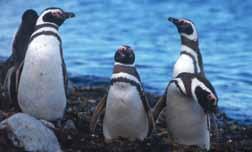
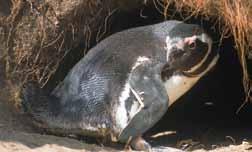
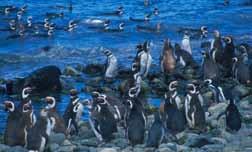



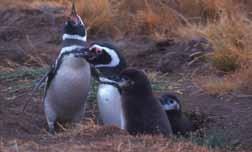
d o LPhi N g u LL .
s cientific name : Leucophaeus scorbesbii.
Conservation status : Species not evaluated.
Permanent resident of southern coasts. Feeds on carrion, excrement of other species, sea invertebrates exposed during low tides, eggs from other species, including penguin eggs.
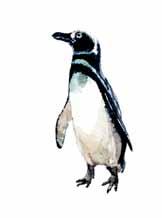

M Age LLAN Pe N gui N .
s cientific name : Spheniscus magellanicus.
Conservation status : Threatened. Adults hunt for fish and squid and spend most of their time on seaside rock formations. During breeding season they move to higher ground where they dig small caves for their nests. Parents take turns protecting the nest and bringing food. Colonies can contain several thousand birds. Also found in : Islotes de Puñihuil, Isla Cachagua.
iMPeri AL s h Ag.
s cientific name : Phalacrocorax atriceps.
Conservation status : Low risk throughout its global distribution, not evaluated in Chile. Forms very dense colonies of as many as tens of thousands of monogamous pairs, sharing space with other species such as penguins. They dive underwater for fish, squid, and crustaceans. During mating season, males develop very erect plumage on their heads.
s ou T h A M eri CAN s e A-Lio N
s cientific name : Otaria flavescens.
Conservation status : Out of danger in all its territories except for the Magallanes Region (Region XII), where it is vulnerable. It forms colonies of roughly 15 individuals, composed of one macho (dominant male), his harem and various offspring. Each female gives only one birth per season. They are found along the entire coast of Chile, where the various colonies claim their territory of rocky islands and shoreline. They prey on penguins and are preyed upon by killer whales. Also found in : Islotes de Puñihuil, Cinco Hermanas, Isla Cachagua, La Portada.
gAvioTA Aus T r AL . Nombre científico : Leucophaeus scorbesbii. e stado de conservación : Especie no evaluada.

Residente permanente de las costas australes, se alimenta de carroña, excrementos de otras especies, invertebrados del intermareal que quedan expuestos durante las mareas bajas, y huevos de otras especies, entre ellos de pingüinos.
Pi N güi N o MAg ALL á N i Co. Nombre científico : Spheniscus magellanicus. e stado de conservación : Amenazado. Los adultos cazan peces y calamares y pasan la mayor parte del tiempo en roqueríos de la orilla. En época de reproducción escalan las laderas costeras donde excavan pequeñas cuevas en las que anidan. Los padres se turnan día a día para proteger el nido y traer alimento. Forman colonias de varios miles. También en : Islotes de Puñihuil, Isla Cachagua.
Cor M orá N i MPeri AL . Nombre científico : Phalacrocorax atriceps. e stado de conservación : Riesgo menor en su distribución mundial, no evaluado en Chile.

Forma colonias muy densas de decenas de miles de parejas monógamas, y comparte el espacio con otras especies como pingüinos. Se sumerge en el mar para cazar peces, calamares y crustáceos. Durante la etapa reproductiva los machos desarrollan una cresta eréctil de plumas.
Lo B o MA ri N o de u N Pe Lo. Nombre científico : Otaria flavescens. e stado de conservación : Fuera de peligro en todo su rango, excepto en la región de Magallanes, donde es vulnerable. Forma colonias de unos 15 individuos, compuestas de un macho, su harén y varios juveniles. Cada hembra tiene una sola cría por temporada. Se lo puede encontrar en playas, a lo largo de todo Chile, formando grupos de varias colonias, donde cada colonia se apropia de un sector de los roqueríos costeros. Se alimenta de pingüinos, y es presa de orcas. También en : Islotes de Puñihuil, Cinco Hermanas, Isla Cachagua, La Portada.
C LAudio A LMA rz A vALe Nzue LA is a naturalist and explorer. He has a Master’s degree in Science Journalism and has been a nature photographer for National Geographic Magazine . He studied at the Universidad Complutense de Madrid and at Boston University. He is a member of the Vertical Foundation and the Senda Darwin Foundation, and is director/ founder of the magazine Geográfica . He prefers to dedicate his time working on investigation and conservation issues related to biodiversity and threatened species, an endeavor that allows optimal use of his photographic abilities. His work has been exhibited on every continent and he has published nine books, including Patagonia, la última tierra (Patagonia, the Last Land ), El invierno desconocido (The Unknown Winter ), a work that resulted in his first publication in National Geographic , and Parque Oncol, selva valdiviana (Parque Oncol, the Valdivian Rainforest ). This last work, shown at the World Expo-Shanghai, was the result of two years of extensive research and scientific documentation by the author. It is the first all-encompassing encyclopedic work about the Validivian temperate rain forest, the most ancient rain forest of its kind on the planet. Claudio Almarza is a professional supported by UNESCO.
oLAyA sANfue NTes eCheverríA received her undergraduate degree in History from the Pontificia Universidad Católica de Chile, her Master of Arts degree from Georgetown University and her Doctorate in History of the Arts from the Universidad Autónoma de Barcelona. She devotes her professional time to the cultural and art history of Chile and Latin America. She is the author of Develando el Nuevo Mundo: Imágenes de un proceso (Unveiling the New World: Images of a process), and has written specialized magazine reports and special chapters in books. She is also the author of various history books for children. She has participated in numerous cultural and patrimony-related projects, including working on scripts for museum expositions; and has been a judge in the Tesoros Humanos Vivos (Live Human Treasures) competition. She has organized international seminars about Chile’s cultural patrimony and has helped edit books related to this subject.
TeresA viAL PeñAiLiLLo has an undergraduate degree in Social Communication and Journalism from the Universidad de Chile. She completed a Master’s degree in Art Theory from the same university and is currently director of Midia, a publishing firm specialized in books about culture and patrimony. She is a member of the Asociación de Gestores Culturales de Chile (Association of Cultural Promotion of Chile) and has led various important cultural projects. She has edited a number of publications for private and public businesses, including Parques de Santiago (Parks of Santiago), Civilización y cobre (Civilization and Copper), Chamantos (Ponchos), Santiago gráfico (Graphic Santiago), Valparaíso gráfico (Graphic Valparaíso), Cartas de la memoria (Memorial letters), La otra ciudad (The Other City), Innovación made in Chile (Innovation Made in Chile), Neopop: tendencias visuales en Iberoamérica (Neo-pop: Visual Tendencies in Latin America), among others. She is also founder and director of Chile Verde, a communications and diffusion platform aimed at creating a culture of sustainability in Chile and helping green initiatives.
C LAudio A LMA rz A vALe Nzue LA es un naturalista, magister en periodismo científico, explorador y fotógrafo de naturaleza de la revista National Geographic . Realizó sus estudios en la Universidad Complutense de Madrid y en Boston University. Miembro de las fundaciones Vertical y Senda Darwin, y director-fundador de la revista Geográfica , se dedica preferentemente a la investigación y conservación de biodiversidad en estado amenazado, área en que utiliza la fotografía como un valioso instrumento de concientización. Ha expuesto en todos los continentes y publicado, a la fecha, más de nueve libros, destacándose entre ellos Patagonia, la última tierra ; El invierno desconocido, que dio origen a su primera publicación en National Geographic ; y Selva valdiviana, Parque Oncol . Este último, presentado en la Expo-Shanghái, fue fruto de una extensa labor de investigación y documentación científica que el autor realizó durante dos años, constituyéndose en el primer libro enciclopédico del bosque templado lluvioso valdiviano, el más antiguo del planeta en su tipo. Claudio Almarza es un profesional respaldado por la UNESCO.
oLAyA sAN fue NT es eC heverrí A es licenciada en Historia de la Pontificia Universidad Católica de Chile, Master of Arts de Georgetown University y Doctor en Historia del Arte de la Universidad Autónoma de Barcelona. Se dedica a temas de historia del arte e historia cultural en Chile y Latinoamérica. Es autora del libro Develando el Nuevo Mundo. Imágenes de un proceso, y de artículos en revistas especializadas y capítulos de libros. Es autora también de libros de historia para niños. Asimismo, ha participado en varios proyectos de gestión cultural y patrimonial, a cargo de la confección de guiones museográficos, como jurado en el concurso de Tesoros Humanos Vivos, en la organización de seminarios internacionales sobre patrimonio cultural y en la edición de libros sobre este mismo tema.
TeresA v i AL Peñ A iLiLLo es licenciada en Comunicación Social y Periodismo de la Universidad de Chile. Realizó un magíster en Teoría del Arte en esa misma universidad y en la actualidad es directora de Midia, empresa editorial especializada en la creación y publicación de libros sobre la cultura y el patrimonio. Es miembro de la Asociación de Gestores Culturales de Chile, y ha llevado a cabo importantes proyectos en tal sentido. Ha sido editora de numerosas publicaciones para empresas públicas y privadas, entre las que destacan Parques de Santiago , Civilización y cobre , Chamantos , Santiago gráfico, Valparaíso gráfico, Cartas de la memoria , La otra ciudad , Innovación made in Chile , Neopop: tendencias visuales en Iberoamérica , entre otros. Es también fundadora y directora de Chile Verde, plataforma de comunicación y difusión para la creación de una cultura sustentable en Chile y de emprendimientos medioambientales.
PAu LA de so LMi N ih AC C A s T ro has an undergraduate degree in Visual Arts from the Pontificia Universidad Católica de Chile and a Master’s degree in Visual Arts from the Universidad de Chile. She lives in Santiago where she works as a creative artist, a professor, and a facilitator of cultural activities and workshops. She has been an active participant in national and foreign exhibits, art fairs and biennial cultural events. Among these are the IV Biennial of Contemporary Art of Beijing in 2010, “In Absentia” at the Museo del Barro in Paraguay in 2005, and “Zona3” at the Isabel Aninat Gallery in 2012. She is a professor at the Universidad Católica, and founder of NUBE, an art workshop for children and the investigation between art and education. She has edited two books: María Elena: la magia del último pueblo salitrero de la pampa chilena (María Elena: The Magic of the Last Nitrate Town of the Chilean Plains) and PAN , a book about 10 contemporary Chilean artists. Among her notable workshops are Taller Artes del Barro (Mud Arts Workshop) in 2009, and Minimax, Contemporary Chilean Ceramics in 2012.
TeresA A N i NAT sA h Li has an undergraduate degree in Visual Arts from the Pontificia Universidad Católica de Chile and a Master’s degree in Visual Arts from Universidad de Chile. She has taught at the Universidad del Desarrollo. In 2002, together with Catalina Swinburn, she formed an art collective to work with different media, including photography, installation and performance. Among her private exhibitions, her most noteworthy include “Indulgences” at the Selma Feriani Gallery in London in 2012; “Paraíso Perdido” (Lost Paradise) at the Fundación Collahuasi in Iquique in 2011; “El Lujoso Silencio” (Luxurious Silence) at the Cecilia Gonzá lez Gallery in Lima, Peru in 2011; “ Status Quo” (Status Quo) at the CCU Art Gallery in 2010; “No hay peor ciego que el que no quiere ver” (There is none so blind as those who are not willing to see) at the Isabel Aninat Art Gallery in 2008; and “Obituario” (Obituary) at the Animal Gallery in 2004. And together with Catalina Swinburn in 2008, she created the public space and mural project “Lugares Comunes” (Common Places) for the Vitacura Civic Center.
x iM e NA v i AL LeCA ros has an undergraduate degree in History with an emphasis on the 20th century. Her studies included two research seminars on 20th century subjects, both related to Chile and the world. She worked for two years as a teacher’s aid for courses on History Theory, Chilean Anthropology and Topics of Contemporary History. Her greatest interest is in teaching and promoting cultural and patrimony issues. She taught history at the pre-university level for three years and currently works in areas related to national patrimony.
PABLo Mo NT e ALegre BA r BA has an undergraduate degree in Art from the Pontificia Universidad Católica de Chile and a Master’s degree in Visual Arts from the Universidad de Chile. His works as a visual artist range from painter to illustrator and photographer. As an illustrator he has worked in a number of projects, including 40 grados, la primera guía del pisco chileno (40 degrees, the first guide to Chilean pisco ), published by Emporio Creativo. He also worked in Bonsái , a film by Cristián Jiménez that was released in 2011.
JuAN s iMó N áLAMos u rzúA is currently an undergraduate student of Agronomy at the Pontificia Universidad Católica de Chile, after first studying Art for three years at the same university. He has worked as a research aid for projects relating to the evolution of native species. He is part of the iGEM-UC team, whose focus is the development of a project regarding synthetic biology.
PAu LA de so LMi N ih AC C A s T ro es licenciada en Artes Visuales de la Pontificia Universidad Católica de Chile y Magíster en Artes Visuales de la Universidad de Chile. Vive en Santiago, donde trabaja en creación artística, docencia, gestión cultural y curatorías ocasionales. Ha participado activamente en exposiciones nacionales y extranjeras, en ferias de arte y en bienales, entre las que destacan la IV Bienal de Arte Contemporáneo de Beijing el año 2010, “In Absentia”, en Museo del Barro, Paraguay, el año 2005; y “Zona3” en Galería Isabel Aninat el año 2012. Es profesora de la Universidad Católica y fundadora de NUBE, taller de arte para niños, y de investigación sobre arte y educación. Ha sido editora de los libros María Elena: La magia del último pueblo salitrero de la pampa chilena y PAN, libro sobre 10 artistas contemporáneos chilenos. Dentro de sus curatorías destacan Taller Artes del Barro para la Trienal de Chile 2009 y Minimax , Cerámica Contemporánea Chilena, 2012.
TeresA A N i NAT sA h Li es licenciada en Artes Visuales de la Pontificia Universidad Católica de Chile y Magíster en Artes Visuales de la Universidad de Chile. Ha sido docente de la Universidad del Desarrollo. En 2002, junto a Catalina Swinburn, forma un colectivo de arte, trabajando con diferentes medios como fotografía, instalación y performance. Entre sus exposiciones individuales destacan: ”Indulgences”, galería Selma Feriani, Londres, 2012; “Paraíso Perdido”, Fundación Collahuasi, Iquique, 2011; “El Lujoso Silencio”, galería Cecilia Gonzá lez, Lima, Perú, 2011; ” Statu Quo”, sala de arte CCU, 2010; “No hay peor ciego que el que no quiere ver”, Galería de Arte Isabel Aninat, 2008, y “Obituario”, Galería Animal, 2004, entre otras. En 2008 realizó, en conjunto con Catalina Swinburn,el proyecto en el espacio público y mural “Lugares Comunes”, para el edificio Centro Cívico de Vitacura.
x iM e NA v i AL LeCA ros es licenciada en Historia, con especial interés en el siglo XX, y participó en dos seminarios de investigación sobre temáticas del siglo, ambas relacionadas con Chile y el mundo. Dos años de trabajo como ayudante en Teoría de la Historia, Antropología Chilena y Temas de Historia Contemporánea. Gran interés por la docencia, y la gestión patrimonial y cultural. Experiencia de tres años de docencia en preuniversitario de historia, y práctica en el área de patrimonio.
PABLo Mo NT e ALegre BA r BA es licenciado en Artes de la Pontificia Universidad Católica de Chile y magister en Artes Visuales de la Universidad de Chile. Se desempeña como artista visual en el área de pintura, como ilustrador y como fotógrafo. Ha participado como ilustrador en diversos proyectos, entre ellos 40 grados, la primera guía del pisco chileno , publicada por Emporio Creativo; también enBonsái , largometraje de Cristián Jiménez estrenado el año 2011.
JuAN s iMó N áLAMos u rzúA es estudiante de Agronomía en la Pontificia Universidad Católica de Chile, carrera a la que ingresó después de estudiar tres años de Licenciatura en Arte en la misma universidad. Se ha desempeñado como ayudante de investigación en proyectos de ecología evolutiva de especies nativas. Actualmente forma parte del equipo de iGEM-UC, con el cual desarrolla un proyecto de biología sintética.
Monumentos Naturales de Chile cuenta con el auspicio de Núcleo Paisajismo
Y con el patrocinio de Corporación del Patrimonio Cultural de Chile
Nacional Forestal Chile Verde
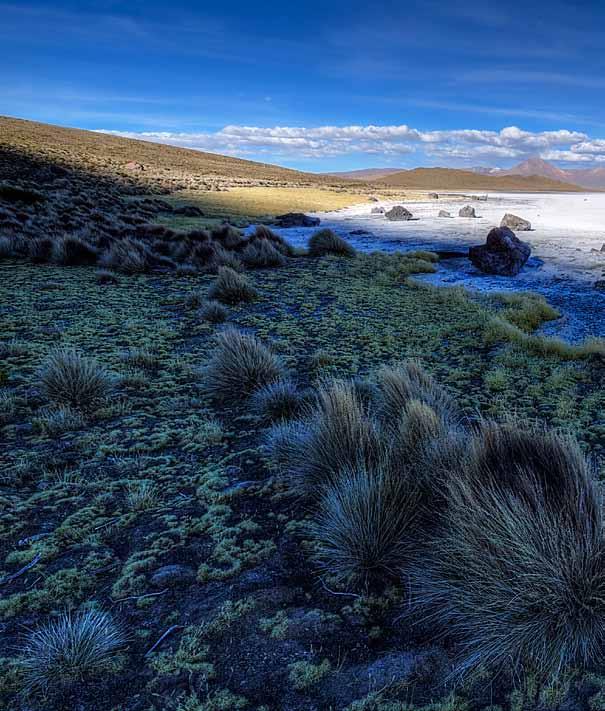

‡ Monumentos Naturales